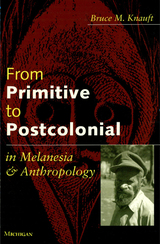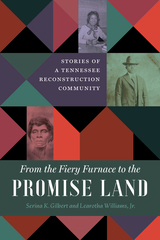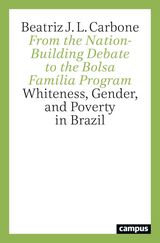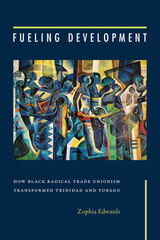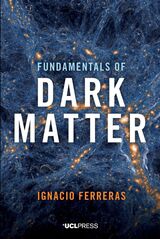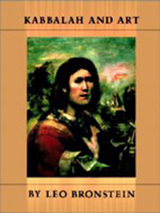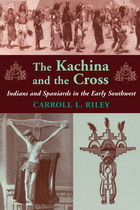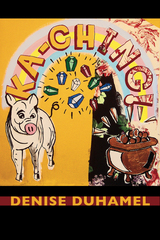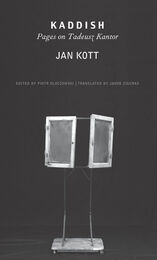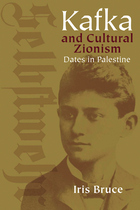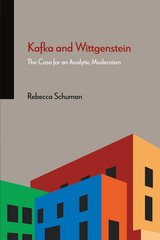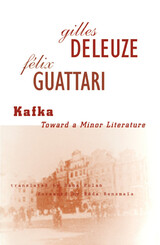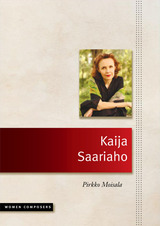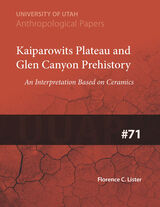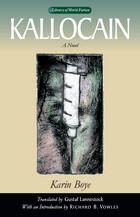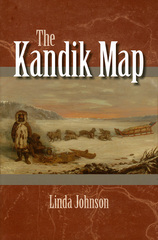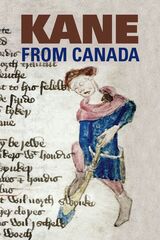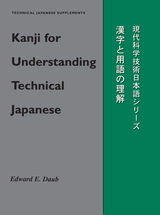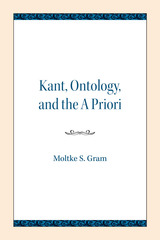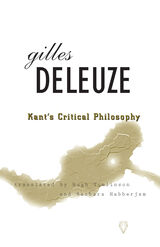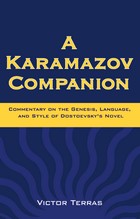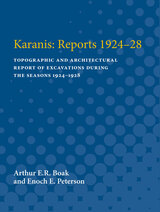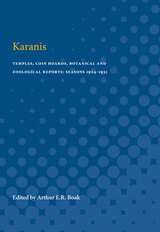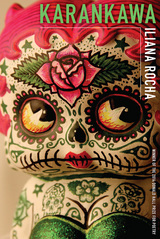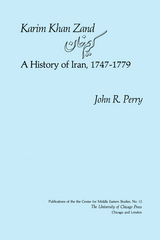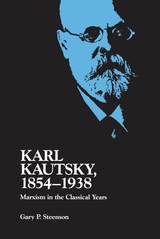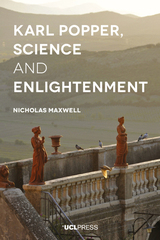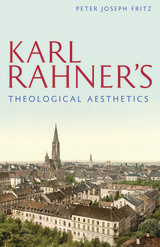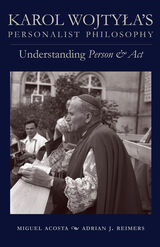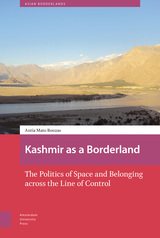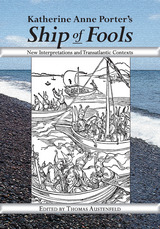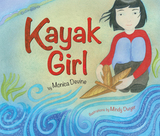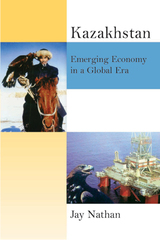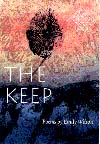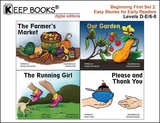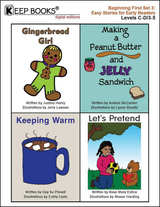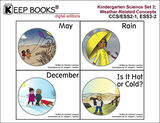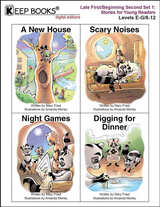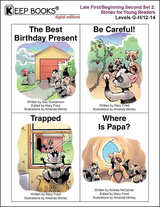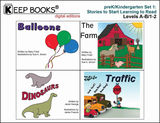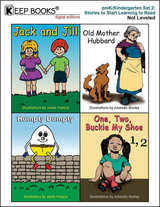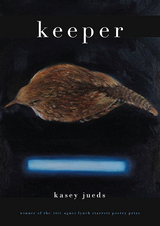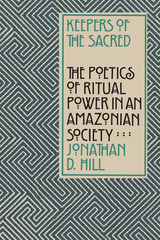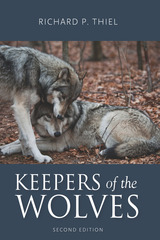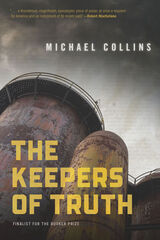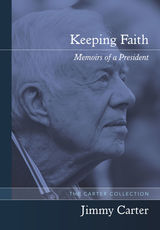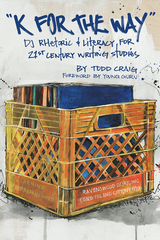 "K for the Way": DJ Rhetoric and Literacy for 21st Century Writing Studies
Todd Craig
Utah State University Press, 2023 “K for the Way” explores writing, rhetoric, and literacy from the perspective of the Hip Hop DJ. Todd Craig, a DJ himself, establishes and investigates the function of DJ rhetoric and literacy, illuminating the DJ as a fruitful example for (re)envisioning approaches to writing, research, and analysis in contemporary educational settings. Because it is widely recognized that the DJ was the catalyst for the creation of Hip Hop culture, this book begins a new conversation in which Hip Hop DJs introduce ideas about poetics and language formation through the modes, practices, and techniques they engage in on a daily basis.
Using material from a larger qualitative research study that illustrates the Hip Hop DJ as a twenty-first-century new media reader, writer, and literary critic, Craig blends interviews from prominent and influential DJs in the Hip Hop community with narrative and interdisciplinary scholarship from writing studies, Hip Hop studies, African American studies, urban education, and ethnomusicology. The voices of DJs sit front and center, presenting a revolutionary conversation about writing and communication in the twenty-first century.
Weaving Craig’s life experiences with important discussions of racial literacies, “K for the Way” is a layered and utterly singular exploration of culture, identity, and literacy in America.
 "K for the Way": DJ Rhetoric and Literacy for 21st Century Writing Studies
Todd Craig
Utah State University Press, 2023 “K for the Way” explores writing, rhetoric, and literacy from the perspective of the Hip Hop DJ. Todd Craig, a DJ himself, establishes and investigates the function of DJ rhetoric and literacy, illuminating the DJ as a fruitful example for (re)envisioning approaches to writing, research, and analysis in contemporary educational settings. Because it is widely recognized that the DJ was the catalyst for the creation of Hip Hop culture, this book begins a new conversation in which Hip Hop DJs introduce ideas about poetics and language formation through the modes, practices, and techniques they engage in on a daily basis.
Using material from a larger qualitative research study that illustrates the Hip Hop DJ as a twenty-first-century new media reader, writer, and literary critic, Craig blends interviews from prominent and influential DJs in the Hip Hop community with narrative and interdisciplinary scholarship from writing studies, Hip Hop studies, African American studies, urban education, and ethnomusicology. The voices of DJs sit front and center, presenting a revolutionary conversation about writing and communication in the twenty-first century.
Weaving Craig’s life experiences with important discussions of racial literacies, “K for the Way” is a layered and utterly singular exploration of culture, identity, and literacy in America.
Kabbalah and Art
Léo Bronstein
University Press of New England, 2002 Told as a series of reflections, this study traces links between cultures as diverse as pre-Vedic India and late 19th-century France. An array of unrelated artists are all in fact linked by the Kabbalah and the correlation between art and this mystic Jewish thought.
 Kabbalah, Magic and Science: The Cultural Universe of a Sixteenth-Century Jewish Physician
David Ruderman
Harvard University Press, 1988 In describing the career of Abraham Yagel, a Jewish physician, kabbalist, and naturalist who lived in northern Italy from 1553 to about 1623, David Ruderman observes the remarkable interplay between early modern scientific thought and religious and occult traditions from a wholly new perspective: that of Jewish intellectual life.
Whether he was writing about astronomical discoveries, demons, marvelous creatures and prodigies of nature, the uses of magic, or reincarnation, Yagel made a consistent effort to integrate empirical study of nature with kabbalistic and rabbinic learning. Yagel's several interests were united in his belief in the interconnectedness of all thing—a belief, shared by many Renaissance thinkers, that turns natural phenomena into “signatures” of the divine unity of all things. Ruderman argues that Yagel and his coreligionists were predisposed to this prevalent view because of occult strains in traditional Jewish thought He also suggests that underlying Yagel's passion for integrating and correlating all knowledge was a powerful psychological need to gain cultural respect and acceptance for himself and for his entire community, especially in a period of increased anti-Semitic agitation in Italy.
Yagel proposed a bold new agenda for Jewish culture that underscored the religious value of the study of nature, reformulated kabbalist traditions in the language of scientific discourse so as to promote them as the highest form of human knowledge, and advocated the legitimate role of the magical arts as the ultimate expression of human creativity in Judaism. This portrait of Yagel and his intellectual world will well serve all students of late Renaissance and early modern Europe.
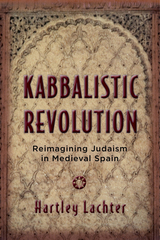 Kabbalistic Revolution: Reimagining Judaism in Medieval Spain
Lachter, Hartley
Rutgers University Press, 2014 The set of Jewish mystical teachings known as Kabbalah are often imagined as timeless texts, teachings that have been passed down through the millennia. Yet, as this groundbreaking new study shows, Kabbalah flourished in a specific time and place, emerging in response to the social prejudices that Jews faced.
Hartley Lachter, a scholar of religion studies, transports us to medieval Spain, a place where anti-Semitic propaganda was on the rise and Jewish political power was on the wane. Kabbalistic Revolution proposes that, given this context, Kabbalah must be understood as a radically empowering political discourse. While the era’s Christian preachers claimed that Jews were blind to the true meaning of scripture and had been abandoned by God, the Kabbalists countered with a doctrine that granted Jews a uniquely privileged relationship with God. Lachter demonstrates how Kabbalah envisioned this increasingly marginalized group at the center of the universe, their mystical practices serving to maintain the harmony of the divine world.
For students of Jewish mysticism, Kabbalistic Revolution provides a new approach to the development of medieval Kabbalah. Yet the book’s central questions should appeal to anyone with an interest in the relationships between religious discourses, political struggles, and ethnic pride.
Kachina and the Cross
Carroll L Riley
University of Utah Press, 1999 In The Kachina and the Cross, Carroll Riley weaves elements of archaeology, anthropology, and history to tell a dramatic story of conflict between the Pueblo Indians and Franciscan missionaries in the seventeenth-century Spanish colony of New Mexico.
Until now, histories of the early Southwest have tended to concentrate on the Spanish presence, with little mention of Indian resistance or the decade-long war that eventually erupted. In The Kachina and the Cross Riley completes the picture by utilizing archaeological and anthropological research from the past forty years, fleshing out the story of the first century of sustained Spanish-Pueblo relations.
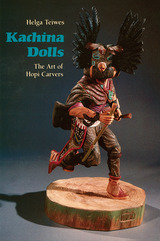 Kachina Dolls: The Art of Hopi Carvers
Helga Teiwes
University of Arizona Press, 1991 Much has been written about the popular kachina dolls carved by the Hopi Indians of northern Arizona, but little has been revealed about the artistry behind them. Now Helga Teiwes describes the development of this art form from early traditional styles to the action-style kachina dolls made popular in galleries throughout the world, and on to the kachina sculptures that have evolved in the last half of the 1980s.
Teiwes explains the role of the Katsina spirit in Hopi religion and that of the kachina doll—the carved representation of a Katsina—in the ritual and economic life of the Hopis. In tracing the history of the kachina doll in Hopi culture, she shows how these wooden figures have changed since carvers came to be influenced by their marketability among Anglos and how their carving has been characterized by increasingly refined techniques. Unique to this book are Teiwes's description of the most recent trends in kachina doll carving and her profiles of twenty-seven modern carvers, including such nationally known artists as Alvin James Makya and Cecil Calnimptewa. Enhancing the text are more than one hundred photographs, including twenty-five breathtaking color plates that bring to life the latest examples of this popular art form.
Ka-Ching!
Denise Duhamel
University of Pittsburgh Press, 2009 Ka-Ching! is a book of poems that explores America’s obsession with money. It also includes a crown of sonnets about e-bay, sestinas on the subjects of Sean Penn and the main characters of fairytales, a pantoum that riffs on a childhood riddle, and a villanelle inspired by bathroom grafitti.
Kaddish: Pages on Tadeusz Kantor
Jan Kott
Seagull Books, 2020 Tadeusz Kantor (1915–90) was renowned for his revolutionary theater performances in both his native Poland and abroad. Despite nominally being a Catholic, Kantor had a unique relationship with Jewish culture and incorporated many elements of Jewish theater into his works. In Kaddish, Jan Kott, an equally important figure in twentieth-century theater criticism, presents one of the most poignant descriptions of what might be called “the experience of Kantor.” At the core of the book is a fundamental philosophical question: What can save the memory of Kantor’s “Theatre of Death”—the Image, or the Word/Logos? Kott’s biblical answer in Kaddish is that Kantor’s theatre can be saved in its essence only by the Word, the Logos. This slim volume, Kott’s final work, is a distilled meditation that casts light on how two of the most prominent figures in Western theater reflected on the philosophy of the stage.
 Kafka
Klaus Wagenbach
Harvard University Press, 2003 In Kafka's writing, Albert Camus tells us, we travel "to the limits of human thought." And in this book, the world's leading Kafka authority conducts us to the deepest reaches of Kafka's own troubled psyche, to reveal the inner workings of the man who gave his name to a central facet of modern experience, the Kafkaesque. Klaus Wagenbach, who wrote the first major critical biography of Kafka, draws upon a wealth of new and recent information to produce a concise but finely nuanced portrait of the author, an ideal introduction to this quintessential figure of modernity.
With extensive reference to Kafka's extraordinary letters and diaries, Wagenbach shows us the author of Metamorphosis and The Trial perpetually caught between the irresistible attractions of the world and his ruthless desire for solitude and isolation. It was this tension, Wagenbach tells us, that gave Kafka's writing its uncanny quality and that haunted his intense, unresolved relationships with women. And it was in this tension that both his misery and mastery inhered, making his one of the most painfully powerful voices of the experience of the twentieth century.
Kafka and Cultural Zionism: Dates in Palestine
Iris Bruce
University of Wisconsin Press, 2007 Kafka and Cultural Zionism is an illumination of the individual Jewish identity of this major modernist German author. Through a thorough examination of Kafka's life, his influences, and his writings, Iris Bruce makes a case for Kafka's interest in Zionism and demonstrates the presence of Jewish themes and motifs in Kafka's literary works. In recognizing this essential part of Kafka's individual voice, Bruce hopes to provide a new perspective on Kafka and his writings that allows the reader to find the humor, playfulness, rebelliousness, and challenge that can be overlooked if the reader expects to find a Kafka who is disengaged from his ethnic and cultural identity, as well as the politics of his age. Outstanding Academic Title, Choice Magazine
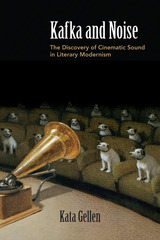 Kafka and Noise: The Discovery of Cinematic Sound in Literary Modernism
Kata Gellen
Northwestern University Press, 2019 A series of disruptive, unnerving sounds haunts the fictional writings of Franz Kafka. These include the painful squeak in Gregor Samsa's voice, the indeterminate whistling of Josefine the singer, the relentless noise in "The Burrow," and telephonic disturbances in The Castle. In Kafka and Noise, Kata Gellen applies concepts and vocabulary from film theory to Kafka's works in order to account for these unsettling sounds. Rather than try to decode these noises, Gellen explores the complex role they play in Kafka's larger project.
Kafka and Noise offers a method for pursuing intermedial research in the humanities—namely, via the productive "misapplication" of theoretical tools, which exposes the contours, conditions, and expressive possibilities of the media in question. This book will be of interest to scholars of modernism, literature, cinema, and sound, as well as to anyone wishing to explore how artistic and technological media shape our experience of the world and the possibilities for representing it.
Kafka and Wittgenstein: The Case for an Analytic Modernism
Rebecca Schuman
Northwestern University Press, 2015 In Kafka and Wittgenstein, Rebecca Schuman undertakes the first ever book-length scholarly examination of Ludwig Wittgenstein’s philosophy of language alongside Franz Kafka’s prose fiction. In groundbreaking readings, she argues that although many readers of Kafka are searching for what his texts mean, in this search we are sorely mistaken. Instead, the problems and illusions we portend to uncover, the im-portant questions we attempt to answer—Is Josef K. guilty? If so, of what? What does Gregor Samsa’s transformed body mean? Is Land-Surveyor K. a real land surveyor?— themselves presuppose a bigger delusion: that such questions can be asked in the first place. Drawing deeply on the entire range of Wittgenstein’s writings, Schuman can-nily sheds new light on the enigmatic Kafka.
 Kafka Goes to the Movies
Hanns Zischler
University of Chicago Press, 2002 "Went to the movies. Wept. Matchless entertainment." So wrote Franz Kafka in one of his diaries, giving us but one hint of his little-known passion for the cinema. Until now, Kafka aficionados have been left to speculate about which films moved Kafka so powerfully and how those films might have influenced his writing. With Kafka Goes to the Movies, German actor and film director Hanns Zischler draws on years of detective work to provide the first account of Kafka's moviegoing life.
Since many of Kafka's visits to the cinema occurred during bachelor trips with Max Brod, Zischler's research took him not only to Kafka's native Prague but to film archives in Munich, Milan, and Paris. Matching Kafka's cinematic references to reviews and stills from daily papers, Zischler hunted down rare films in collections all across Europe. A labor of love, then, by a true man of the cinema, Kafka Goes to the Movies brims with discoveries about the pioneering years of European film. With a wealth of illustrations, including reproductions of movie posters and other rare materials, Zischler opens a fascinating window onto movies that have been long forgotten or assumed lost.
But the real highlights of the book are those about Kafka himself. Long considered one of the most enigmatic figures in literature, the Kafka that emerges in this work is strikingly human. Kafka Goes to the Movies offers an absorbing look at a witty, passionate, and indulgently curious writer, one who discovered and used the cinema as a place of enjoyment and escape, as a medium for the ambivalent encounter with modern life, and as a filter for the changing world around him.
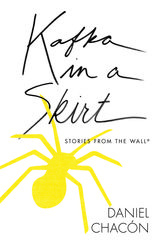 Kafka in a Skirt: Stories from the Wall
Daniel Chacón
University of Arizona Press, 2019 This is not your ordinary short story collection. In his newest work, Daniel Chacón subverts expectation and bends the rules of reality to create stories that are intriguing, hilarious, and deeply rooted in Chicano culture. These stories explore the concept of a wall that reaches beyond our immediate thoughts of a towering physical structure. While Chacón aims to address the partition along the U.S.-Mexico border, he also uses these stories to work through the intangible walls that divide communities and individuals—particularly those who straddle multiple cultures in their daily lives.
Set in El Paso and other Latinx-dominant urban spaces, Kafka in a Skirt is an immersive look into the myriad lives of the characters who inhabit these culturally diverse areas. Chacón masterfully weaves elements of the surreal and fantastic through a shining tapestry of fiction, creating moments of touching realism in contrast with scenes that are fascinatingly unfamiliar. Occasionally teasing the ghosts of Jorge Luis Borges and the Argentine poet Alejandra Pizarnik, this collection disregards boundaries and transports readers into a world merely parallel to our own. Kafka in a Skirt unravels the intricacies of culture, sexuality, love, and loneliness in a collection that shows the personal implications of barriers while remaining hopeful and bright.
Kafka: Toward a Minor Literature
Gilles Deleuze
University of Minnesota Press, 1986 In this classic of critical thought, Deleuze and Guattari challenge conventional interpretations of Kafka’s work. Instead of exploring preexisting categories or literary genres, they propose a concept of “minor literature”—the use of a major language that subverts it from within. Writing as a Jew in Prague, they contend, Kafka made German “take flight on a line of escape” and joyfully became a stranger within it. His work therefore serves as a model for understanding all critical language that must operate within the confines of the dominant language and culture.
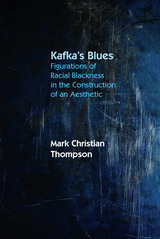 Kafka’s Blues: Figurations of Racial Blackness in the Construction of an Aesthetic
Mark Christian Thompson
Northwestern University Press, 2016 Kafka's Blues proves the startling thesis that many of Kafka's major works engage in a coherent, sustained meditation on racial transformation from white European into what Kafka refers to as the "Negro" (a term he used in English). Indeed, this book demonstrates that cultural assimilation and bodily transformation in Kafka's work are impossible without passage through a state of being "Negro." Kafka represents this passage in various ways—from reflections on New World slavery and black music to evolutionary theory, biblical allusion, and aesthetic primitivism—each grounded in a concept of writing that is linked to the perceived congenital musicality of the "Negro," and which is bound to his wider conception of aesthetic production. Mark Christian Thompson offers new close readings of canonical texts and undervalued letters and diary entries set in the context of the afterlife of New World slavery and in Czech and German popular culture.
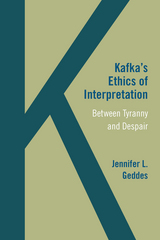 Kafka's Ethics of Interpretation: Between Tyranny and Despair
Jennifer L. Geddes
Northwestern University Press, 2016 Kafka's Ethics of Interpretation refutes the oft-repeated claim, made by Kafka's greatest interpreters, including Walter Benjamin and Harold Bloom, that Kafka sought to evade interpretation of his writings. Jennifer L. Geddes shows that this claim about Kafka's deliberate uninterpretability is not only wrong, it also misconstrues a central concern of his work. Kafka was not trying to avoid or prevent interpretation; rather, his works are centrally concerned with it.
Geddes explores the interpretation that takes place within, and in response to, Kafka's writings, and pairs Kafka's works with readings of Sigmund Freud, Pierre Bourdieu, Tzvetan Todorov, Emmanuel Levinas, and others. She argues that Kafka explores interpretation as a mode of power and violence, but also as a mode of engagement with the world and others. Kafka, she argues, challenges us to rethink the ways we read texts, engage others, and navigate the world through our interpretations of them.
 Kafka's Law: "The Trial" and American Criminal Justice
Robert P. Burns
University of Chicago Press, 2014 The Trial is actually closer to reality than fantasy as far as the client’s perception of the system. It’s supposed to be a fantastic allegory, but it’s reality. It’s very important that lawyers read it and understand this.” Justice Anthony Kennedy famously offered this assessment of the Kafkaesque character of the American criminal justice system in 1993. While Kafka’s vision of the “Law” in The Trial appears at first glance to be the antithesis of modern American legal practice, might the characteristics of this strange and arbitrary system allow us to identify features of our own system that show signs of becoming similarly nightmarish?
With Kafka’s Law, Robert P. Burns shows how The Trial provides an uncanny lens through which to consider flaws in the American criminal justice system today. Burns begins with the story, at once funny and grim, of Josef K., caught in the Law’s grip and then crushed by it. Laying out the features of the Law that eventually destroy K., Burns argues that the American criminal justice system has taken on many of these same features. In the overwhelming majority of contemporary cases, police interrogation is followed by a plea bargain, in which the court’s only function is to set a largely predetermined sentence for an individual already presumed guilty. Like Kafka’s nightmarish vision, much of American criminal law and procedure has become unknowable, ubiquitous, and bureaucratic. It, too, has come to rely on deception in dealing with suspects and jurors, to limit the role of defense, and to increasingly dispense justice without the protection of formal procedures. But, while Kennedy may be correct in his grim assessment, a remedy is available in the tradition of trial by jury, and Burns concludes by convincingly arguing for its return to a more central place in American criminal justice.
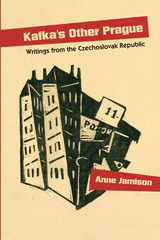 Kafka’s Other Prague: Writings from the Czechoslovak Republic
Anne Jamison
Northwestern University Press, 2018 Kafka’s Other Prague: Writings from the Czechoslovak Republic examines Kafka’s late writings from the perspective of the author’s changing relationship with Czech language, culture, and literature—the least understood facet of his meticulously researched life and work.
Franz Kafka was born in Prague, a bilingual city in the Habsburg Empire. He died a citizen of Czechoslovakia. Yet Kafka was not Czech in any way he himself would have understood. He could speak Czech, but, like many Prague Jews, he was raised and educated and wrote in German. Kafka critics to date have had little to say about the majority language of his native city or its “minor literature,” as he referred to it in a 1913 journal entry. Kafka’s Other Prague explains why Kafka’s later experience of Czech language and culture matters.
Bringing to light newly available archival material, Anne Jamison’s innovative study demonstrates how Czechoslovakia’s founding and Kafka’s own dramatic political, professional, and personal upheavals altered his relationship to this “other Prague.” It destabilized Kafka’s understanding of nationality, language, gender, and sex—and how all these issues related to his own writing.
Kafka’s Other Prague juxtaposes Kafka’s German-language work with Czechoslovak Prague’s language politics, intellectual currents, and print culture—including the influence of his lover and translator, the journalist Milena Jesenská—and shows how this changed cultural and linguistic landscape transformed one of the great literary minds of the last century.
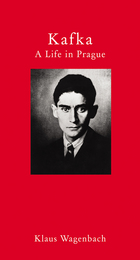 Kafka's Prague
Klaus Wagenbach
Haus Publishing, 2020 Nearly one hundred years after Franz Kafka’s death, his works continue to intrigue and haunt us. Kafka is regarded as one of the most significant intellectuals of the nineteenth and twentieth century, and even for those who are only barely acquainted with his novels, stories, diaries, or letters, “Kafkaesque” has become a term synonymous with the menacing, unfathomable absurdity of modern existence and bureaucracy. While the significance of his fiction is wide-reaching, Kafka’s writing remains inextricably bound up with his life and work in a particular place: Prague. It is here that the author spent every one of his forty years.
Drawing from a range of documents and historical materials, this is the first book specifically dedicated to the relationship between Kafka and Prague. Klaus Wagenbach’s account of Kafka’s life in the city is a meticulously researched insight into the author’s family background, his education and employment, his attitude toward the town of his birth, his literary influences, and his relationships with women. The result is a fascinating portrait of the twentieth century’s most enigmatic writer and the city that provided him with so much inspiration. W. G. Sebald recognized that “literary and life experience overlap” in Kafka’s works, and the same is true of this book.
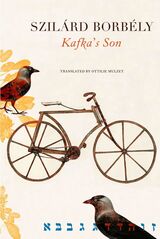 Kafka’s Son
Szilárd Borbély
Seagull Books, 2023 A posthumously published Hungarian masterpiece that reflects on fragmented lives.
Born in 1963, Szilárd Borbély emerged as one of the most important poets of post-communist Europe, exploring the themes of grief, memory, and trauma in his critically acclaimed work. Following the murder of his mother during a burglary in 2000, and the subsequent breakdown and death of his father, Borbély suffered from post-traumatic depression and tragically ended his own life in 2014.
Among the manuscripts that Borbély left behind was Kafka’s Son, a fragmentary work, rendered still more fragmented through the author’s death. Through a series of haunting passages that explore early twentieth-century Prague, including the ruins of the ancient Jewish ghetto during the time of its demolition, Borbély inscribes the story of Franz Kafka and his father onto the city. We are used to hearing from Franz; here Hermann Kafka is also given a voice. “The son,” he tells us, “is the life of the father. The father is the death of the son.” By extension, then, this book is also an indirect telling of the story of Borbély and his father, and about sons and fathers in the Habsburg empire and the culture of brutality that defined Eastern Europe.
A posthumously published Hungarian masterpiece, Kafka’s Son now appears in English in award-winning translator Ottilie Mulzet’s sensitive translation, a fragmentary yet iridescent work inviting us to reflect on our fragmented lives.
 Kafka's Zoopoetics: Beyond the Human-Animal Barrier
Naama Harel
University of Michigan Press, 2020 Nonhuman figures are ubiquitous in the work of Franz Kafka, from his early stories down to his very last one. Despite their prominence throughout his oeuvre, Kafka’s animal representations have been considered first and foremost as mere allegories of intrahuman matters. In recent years, the allegorization of Kafka’s animals has been poetically dismissed by Kafka’s commentators and politically rejected by posthumanist scholars. Such critique, however, has yet to inspire either an overarching or an interdiscursive account. This book aims to fill this lacuna. Positing animal stories as a distinct and significant corpus within Kafka’s entire poetics, and closely examining them in dialogue with both literary and posthumanist analysis, Kafka’s Zoopoetics critically revisits animality, interspecies relations, and the very human-animal contradistinction in the writings of Franz Kafka. Kafka’s animals typically stand at the threshold between humanity and animality, fusing together human and nonhuman features. Among his liminal creatures we find a human transformed into vermin (in “The Metamorphosis”), an ape turned into a human being (in “A Report to an Academy”), talking jackals (in “Jackals and Arabs”), a philosophical dog (in “Researches of a Dog”), a contemplative mole-like creature (in “The Burrow”), and indiscernible beings (in “Josefine, the Singer or the Mouse People”). Depicting species boundaries as mutable and obscure, Kafka creates a fluid human-animal space, which can be described as “humanimal.” The constitution of a humanimal space radically undermines the stark barrier between human and other animals, dictated by the anthropocentric paradigm. Through denying animalistic elements in humans, and disavowing the agency of nonhuman animals, excluding them from social life, and neutralizing compassion for them, this barrier has been designed to regularize both humanity and animality. The contextualization of Kafka's animals within posthumanist theory engenders a post-anthropocentric arena, which is simultaneously both imagined and very real.
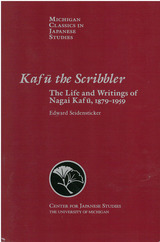 Kafu the Scribbler: The Life and Writings of Nagai Kafu, 1897–1959
Edward Seidensticker
University of Michigan Press, 1990 Kafū the Scribbler is neither pure biography nor pure criticism nor yet a pure anthology, but a blending of the three. It is an introduction to Nagai Kafū and his city, accompanied by a fairly generous sampling from his works. Marleigh Ryan writes: “In this book Edward Seidensticker presents a unique combination of biography and literary criticism by skillfully interweaving details of the life of Nagai Kafū with studies of his writing. With quotations of from Kafū’s fiction and nonfiction alike, Seidensticker is able to reconstruct many incidents in the author’s life which had previously been little understood. The latter half of the book is given over to translations of short stories and to selections from two novels and a journal. Seidensticker has thoughtfully given cross references to the material in both parts of the book which enable the reader to handle this wealth of material with some dexterity. “Seidensticker’s skill as a translator is so well established that it seems almost unnecessary to comment on it further here but one cannot help being impressed by his rendering of Kafū’s lyrical style. As we realize when reading the critical material, there is remarkably little plot or character development in Kafū’s fiction. His position as leading modern writer is dependent to a considerable degree upon the beauty and grace of his style, and we are fortunate indeed to have such masterful translations as these to convey that style.”* *Ryan, Marleigh. Journal of the American Oriental Society 88, no. 3 (1968): 624. doi:10.2307/596924.
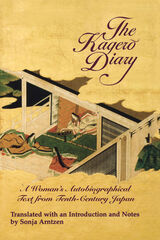 The Kagero Diary: A Woman’s Autobiographical Text from Tenth-Century Japan
Translated with an Introduction and Notes by Sonja Arntzen
University of Michigan Press, 1997 Japan is the only country in the world where women writers laid the foundations of classical literature. The Kagerō Diary commands our attention as the first extant work of that rich and brilliant tradition. The author, known to posterity as Michitsuna’s Mother, a member of the middle-ranking aristocracy of the Heian period (794–1185), wrote an account of 20 years of her life (from 954–74), and this autobiographical text now gives readers access to a woman’s experience of a thousand years ago. The diary centers on the author’s relationship with her husband, Fujiwara Kaneie, her kinsman from a more powerful and prestigious branch of the family than her own. Their marriage ended in divorce, and one of the author’s intentions seems to have been to write an anti-romance, one that could be subtitled, “I married the prince but we did not live happily ever after.” Yet, particularly in the first part of the diary, Michitsuna’s Mother is drawn to record those events and moments when the marriage did live up to a romantic ideal fostered by the Japanese tradition of love poetry. At the same time, she also seems to seek the freedom to live and write outside the romance myth and without a husband. Since the author was by inclination and talent a poet and lived in a time when poetry was a part of everyday social intercourse, her account of her life is shaped by a lyrical consciousness. The poems she records are crystalline moments of awareness that vividly recall the past. This new translation of the Kagerō Diary conveys the long, fluid sentences, the complex polyphony of voices, and the floating temporality of the original. It also pays careful attention to the poems of the text, rendering as much as possible their complex imagery and open-ended quality. The translation is accompanied by running notes on facing pages and an introduction that places the work within the context of contemporary discussions regarding feminist literature and the genre of autobiography and provides detailed historical information and a description of the stylistic qualities of the text.
 Kaiaulu: Gathering Tides
Mehana Blaich Vaughan
Oregon State University Press, 2018 The tide is rising ahead of the early morning sun on the northeast coast of the Hawaiian island of Kaua‘i. Waves rush singing onto the outer reef where two throw net fishermen stalk the surge. An elderly woman with her silver hair in a kerchief makes her way toward shore, two octopuses tucked in her mesh bag. Within hours, two hundred tourists will snorkel, sunbathe, and teeter on the coral, few ever knowing that people fish here or that their catch sustains an entire kaiāulu (community) connected to this stretch of reef.
This coast is known as a playground for tourists and backdrop for Hollywood movies, but catch from small local reefs, and the sharing of this abundance, has sustained area families for centuries, helping them to thrive through tidal waves, hurricanes, an influx of new residents, and economic recessions. Yet fishing families are increasingly invisible and many have moved away, threatened by global commodification and loss of access to coastal lands that are now private retreats for star entertainers, investors, and dot-com millionaires.
Building on two decades of interviews with more than sixty Hawaiian elders, leaders, and fishermen and women, Kaiāulu shares their stories of enduring community efforts to perpetuate kuleana, often translated to mean “rights and responsibilities.” Community actions extend kuleana to include nurturing respectful relationships with resources, guarding and cultivating fishing spots, perpetuating collective harvests and sharing, maintaining connection to family lands, reasserting local governance rooted in ancestral values, and preparing future generations to carry on.
An important contribution to scholarship in the fields of natural resource management, geography, Indigenous Studies, and Hawaiian Studies, Kaiāulu is also a skillfully written and deeply personal tribute to a community based not on ownership, but reciprocity, responsibility, and caring for the places that shape and sustain us all.
Kaija Saariaho
Pirkko Moisala
University of Illinois Press, 2008 This book is the first comprehensive study of the music and career of contemporary composer Kaija Saariaho. Born in Finland in 1952, Saariaho received her early musical training at the Sibelius Academy, where her close circle included composer and conductor Esa-Pekka Salonen. She has since become internationally known and recognized for her operas L'amour de loin and Adriana Mater and other works that involve electronic music. Her influences include the spectral analysis of timbre, especially string sounds, micropolyphonic techniques, as well as the visual and literary arts and sounds in the natural world. Pirkko Moisala approaches the unique characteristics of Saariaho's music through composition sketches, scores, critical reviews, and interviews with the composer and her trusted musicians.
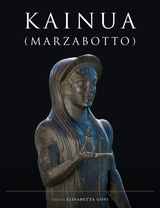 Kainua (Marzabotto)
Edited by Elisabetta Govi
University of Texas Press, 2023 This volume brings together leading scholars of Etruria to provide up-to-date findings from the key archaeological site of Kainua. Located in what is now the Italian town of Marzabotto, Kainua is the only Etruscan site whose complete urban layout has been preserved, making it possible to trace houses, roads, drainage systems, cemeteries, craft workshops, and an acropolis. Under excavation since the 1850s, Kainua offers a trove of insights into Etruscan culture and society. The volume’s editor, Elisabetta Govi, and her fellow experts examine the material evidence underlying our understanding of the history, economy, religion, and social structures of Kainua, including trade routes that linked the city with the wider Mediterranean. Particularly exciting are recent discoveries of sanctuaries dedicated to Tinia and Uni, analogous to the Greek Zeus and Hera, which provide new information about Etruscan cults. Kainua (Marzabotto) also draws on the latest research to reconstruct the city’s foundation rites, a sacred charter, and urban plan. Finally, the authors explore the site’s archaeological history, discussing new knowledge made possible since the introduction of modern techniques of remote sensing and 3D modeling.
The Kaiping Mines, 1877–1912: Second Edition
Ellsworth C. Carlson
Harvard University Press, 1971 This study, revised in light of new material that has appeared since the first edition (1957), explores the problems encountered and the adaptations necessary when Western technology and methods were employed in a Chinese environment and demonstrates the impact of Western financial imperialism on Chinese business enterprise.
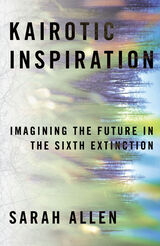 Kairotic Inspiration: Imagining the Future in the Sixth Extinction
Sarah Allen
University of Pittsburgh Press, 2022 On the precipice of the Sixth Extinction, we face a frightening fate—ongoing ecological crises that may result in not only the extinction of a million species within decades but another mass extinction event like the one that wiped out the dinosaurs. In Kairotic Inspiration: Imagining the Future in the Sixth Extinction, Sarah Allen suggests that humans face this future, whatever it brings, by attending to the ways in which all beings are caught in the entangled processes of becoming. But change is often painful and requires inspiration. Allen explores a theory that shifts the concept of inspiration away from the unique genius of the individual and instead situates it within conceptual, human and nonhuman animal relations that can disrupt the state of being. To expand the understanding of change beyond the polarized binary that defines difference, the author builds on Nietzsche’s conceptualization of the Dionysian, which explains how the self is unmade through immersive experiences. This unmaking creates room for a different experience of becoming, one which Donna Haraway calls “becoming-with” and “producing-with.” In the end, Allen demonstrates how deepening kairotic connections can transform us as beings, thrusting us further into the processes of becoming and embracing the change that is possible in this living, changing, endangered world.
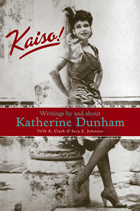 Kaiso!: Writings by and about Katherine Dunham
Edited by VeVe A. Clark and Sara E. Johnson
University of Wisconsin Press, 2006 “Kaiso,” a term of praise that is the calypso equivalent of “bravo,” is a fitting title for this definitive and celebratory collection of writings by and about Katherine Dunham, the legendary African American dancer, choreographer, anthropologist, and social activist. Originally produced in the 1970s, this is a newly revised and much expanded edition that includes recent scholarly articles, Dunham’s essays on dance and anthropology, press reviews, interviews, and chapters from Dunham’s unpublished volume of memoirs, “Minefields.” With nearly a hundred selections by dozens of authors, Kaiso! provides invaluable insight into the life and work of this pioneering anthropologist and performer and is certain to become an essential resource for scholars and general readers interested in social anthropology, dance history, African American studies, or Katherine Dunham herself.
 Kakungulu and the Creation of Uganda, 1868–1928: 1868-1928
Michael Twaddle
Ohio University Press, 1993 This is a history of the early days of Uganda. The account has an African focus because it shows the British takeover through the experiences of an extraordinary leader. “At this spot in the year 1901 the British flag was first hoisted by Semei Kakanguru, emissary and loyal servant of His Majesty the King. He built here a boma which was for a short time the headquarters of the district. From this beginning came the establishment of peace and the development of orderly progress in this part of Uganda.” Michael Twaddle was shown this plaque in 1963 by a local government official who said “That man created the Uganda we Ugandans are fighting for today.” And yet the local people had had the plaque removed to a bicycle shed. How do people regard an African who had an active role in the creation of the imperial state? Was this man “a hero,” “a collaborator,” “a warlord”? The reaction of colonial officials was mixed. One considered him “…in point of general intelligence, progressive ideas and charm of manner…far above all other natives in the Protectorate…” Another dismissed him, along with his companions, as “no better than Masai or Nandi cattle lifters.” And yet another viewed him as “undoubtedly…a partial religious maniac.” The story of this man is an example of the dilemma for a whole generation of East Africans at the turn of the last century. This book has been compared in its importance to Shepperson’s and Price’s Independent African.
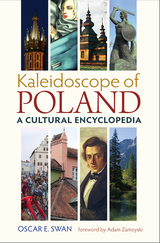 Kaleidoscope of Poland: A Cultural Encyclopedia
Oscar E. Swan
University of Pittsburgh Press, 2015 Foreword by Adam Zamoyski
Kaleidoscope of Poland is a highly readable volume containing short articles on major personalities, places, events, and accomplishments from the thousand-year record of Polish history and culture. Featuring approximately 900 compact text entries and 600 illustrations, it will be a handy reference at home, a perfect supplement to traditional guide books when traveling, an aid to language study, or simply browsed with enjoyment from cover to cover by anyone with an interest in Poland.
The entries describe essential features of Poland from the mundane to the sublime. Whether it is bagels or the Bug River, Chopin or Madame Curie, the authors offer colorful and often witty snapshots of significant individuals, customs, folklore, historic events, phrases, places, geography, and much, much more. Beginning with the emergence of the Polish state in 966 under Mieszko I, to the resurrection of present-day Poland within the European Union, it’s also a sweeping account of the tumult and triumphs the nation has witnessed through much of its history.
This highly entertaining yet informative book is essentially a “cultural dictionary”—offering a knowledge base that can be referred to time and time again. Kaleidoscope of Poland will be welcomed by readers of Polish descent, students of Polish, or anyone planning to visit Poland—anyone seeking a greater insight into this fascinating land.
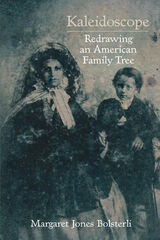 Kaleidoscope: Redrawing an American Family Tree
Margaret Jones Bolsterli
University of Arkansas Press, 2015 In 2005 Margaret Jones Bolsterli learned that her great-great-grandfather was a free mulatto named Jordan Chavis, who owned an antebellum plantation near Vicksburg, Mississippi. The news was a shock; Bolsterli had heard about the plantation in family stories told during her Arkansas Delta childhood, but Chavis’s name and race had never been mentioned. With further exploration Bolsterli found that when Chavis’s children crossed the Mississippi River between 1859 and 1875 for exile in Arkansas, they passed into the white world, leaving the family’s racial history completely behind.
Kaleidoscope is the story of this discovery, and it is the story, too, of the rise and fall of the Chavis fortunes in Mississippi, from the family’s first appearance on a frontier farm in 1829 to ownership of over a thousand acres and the slaves to work them by 1860. Bolsterli learns that in the 1850s, when all free colored people were ordered to leave Mississippi or be enslaved, Jordan Chavis’s white neighbors successfully petitioned the legislature to allow him to remain, unmolested, even as three of his sons and a daughter moved to Arkansas and Illinois. She learns about the agility with which the old man balanced on a tightrope over chaos to survive the war and then take advantage of the opportunities of newly awarded citizenship during Reconstruction. The story ends with the family’s loss of everything in the 1870s, after one of the exiled sons returns to Mississippi to serve in the Reconstruction legislature and a grandson attempts unsuccessfully to retain possession of the land. In Kaleidoscope, long-silenced truths are revealed, inviting questions about how attitudes toward race might have been different in the family and in America if the truth about this situation and thousands of others like it could have been told before.
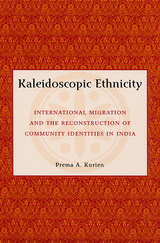 Kaleidoscopic Ethnicity: International Migration and the Reconstruction of Community Identities in India
Kurien, Prema A
Rutgers University Press, 2002 Co-Winner of the 2003 American Sociological Association's Asia/Asian American book award.
Based on ethnographic research in three communities (Ezhava Hindu, Mappila Muslim, and Syrian Christian) in Kerala, India, which sent large numbers of workers to the Middle East for temporary jobs, Kaleidoscopic Ethnicity explores the factors responsible for the striking differences in the groups’ patterns of migration and migration-induced social change. Most broadly, Prema Kurien seeks to understand what ethnicity is and how it affects people’s activities and decisions. She argues that, in each case, a community-specific nexus of religion, gender, and status shaped migration, and was, in turn, transformed by it.
The religious background of the three groups determined their social location within colonial and postcolonial Kerala. This social location in turn affected their occupational profiles, family structures, and social networks, as well as their conceptions of gender and honor, and thus was fundamental in shaping migration patterns. The rapid enrichment brought about by international migration resulted in a reinterpretation of religious identity and practice which was manifested by changes in patterns of gendered behavior and status in each of the three communities. What makes this book unique is its focus on the sociocultural patterns of short-term international migration and its comparative ethnographic approach.
 Kaleidoscopic Visions: The Black, Migrant, and Refugee Women’s Movement in The Netherlands
Nancy Jouwe
Amsterdam University Press, 2025 First published in March 2001, this work was the first and only book of its kind in the Dutch intellectual landscape, and it rapidly became a classic for multigenerational audiences with an interest in intersectional theory and praxis. By zooming in on the issues that Black, migrant, and refugee (BMR) women placed on the feminist and multicultural agenda of the late twentieth century, the writers in this volume highlight the exclusionary practices BMR women encountered within Dutch institutions (the police, education, and the arts) based on their gender, race, class, and sexuality. Kaleidoscopic Visions also explores the world of BMR women’s organizations and processes of identity formation.
This new edition makes this Dutch feminist classic available in English for the first time. It includes an updated reflection on the contemporary relevance of intersectionality in light of important developments since 2001, such as the rise of Islamophobia and the persistence of neoliberalism.
The Kalevala: Or, Poems of the Kaleva District
Elias Lönnrot
Harvard University Press, 1991 The national folk epic of Finland is here presented in an English translation that is both scholarly and eminently readable. To avoid the imprecision and metrical monotony of earlier verse translations, Francis Magoun has used prose, printed line for line as in the original so that repetitions, parallelisms, and variations are readily apparent. The lyrical passages and poetic images, the wry humor, the tall-tale extravagance, and the homely realism of the Kalevala come through with extraordinary effectiveness.
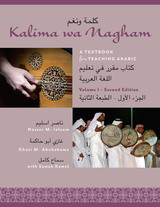 Kalima wa Nagham: A Textbook for Teaching Arabic, Volume 1
By Nasser M. Isleem and Ghazi M. Abuhakema
University of Texas Press, 2020 Presenting a new Teaching Arabic as a Foreign Language (TAFL) curriculum that can be used in secondary and postsecondary educational settings, Kalima wa Nagham (Volume I) is a textbook that uniquely and simultaneously introduces Modern Standard Arabic (MSA) and salient aspects of Educated Spoken Arabic (ESA) to beginning language students. Students who fully utilize this book should be able to develop the different language skills: listening, speaking, reading, writing, and expressing deep cultural knowledge. Written by Arabic language teaching practitioners and experienced educators who are certified language testers, Volume I of Kalima wa Nagham employs a threaded story that introduces language concepts along with music to enhance vocabulary retention and recall. At the core of the textbook are dialogues that present students and teachers with examples of Arabic grammatical concepts and important cultural aspects, as well as related vocabulary. These are supplemented by drills and activities that can be used in a classroom setting or pursued individually. Dialogues, pronunciation and listening drills, and charts to accompany the lessons are available on the UT Press website. This volume is student-centered in content and methodology, which will enable learners to meet and exceed linguistic and cultural proficiency expectations.
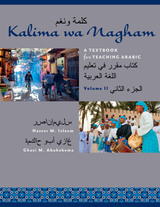 Kalima wa Nagham: A Textbook for Teaching Arabic, Volume 2
By Nasser M. Isleem and Ghazi M. Abuhakema
University of Texas Press, 2016 Presenting a new Teaching Arabic as a Foreign Language (TAFL) curriculum that can be used in secondary and postsecondary educational settings, Kalima wa Nagham, Volume 2, is a textbook that uniquely and simultaneously introduces Modern Standard Arabic (MSA) and salient aspects of Educated Spoken Arabic (ESA) to level two language students. Students who fully utilize this book should be able to develop important language skills: listening, speaking, reading, writing, and expressing deep cultural knowledge. Written by Arabic language teaching practitioners and experienced educators who are certified language testers, Kalima wa Nagham employs a threaded story that introduces language concepts along with music to enhance vocabulary retention and recall. At the core of the textbook are dialogues that present students and teachers with examples of Arabic grammatical concepts and important cultural aspects, as well as related vocabulary. These are supplemented by drills and activities that can be used in a classroom setting or pursued individually. Volume 2 incorporates media language to help students understand news reports and other media texts as well as original cartoons that demonstrate the meaning and significance of idiomatic expressions in a refreshing way. Dialogues and pronunciation and listening drills to accompany the lessons are available on the University of Texas Press website. This volume is student-centered in content and methodology, which will enable learners to meet and exceed linguistic and cultural proficiency expectations.
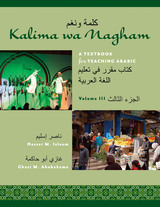 Kalima wa Nagham: A Textbook for Teaching Arabic, Volume 3
By Nasser M. Isleem and Ghazi M. Abuhakema
University of Texas Press, 2020 Presenting a new Teaching Arabic as a Foreign Language (TAFL) curriculum that can be used in secondary and postsecondary educational settings, Kalima wa Nagham, volume 3, is a textbook that uniquely and simultaneously introduces Modern Standard Arabic (MSA) and salient aspects of Educated Spoken Arabic (ESA) to students whose proficiency level is at least intermediate high according to ACTFL’s rating scale. Students who fully use this book should be able to develop important language skills—listening, speaking, reading, writing, and expressing deep cultural knowledge—and reach the advanced high proficiency level by the end of the book. Written by Arabic language teaching practitioners and experienced educators who are certified language testers, Kalima wa Nagham employs a threaded story that introduces language concepts along with music to enhance vocabulary retention and recall. At the core of the textbook are written and oral texts that present students and teachers with examples of Arabic grammatical concepts and important cultural aspects, as well as related vocabulary. These are supplemented by drills and activities that can be used in a classroom setting or pursued individually. Dialogues and pronunciation and listening drills that accompany the lessons are available on the University of Texas Press website. This volume is student-centered in content and methodology, which will enable learners to meet and exceed linguistic and cultural proficiency expectations.
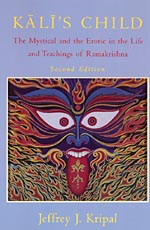 Kali's Child: The Mystical and the Erotic in the Life and Teachings of Ramakrishna
Jeffrey J. Kripal
University of Chicago Press, 1998 In a book now marked by both critical acclaim and cross-cultural controversy, Jeffrey J. Kripal explores the life and teachings of Ramakrishna Paramahamsa, a nineteenth-century Bengali saint who played a major role in the creation of modern Hinduism. Through extended textual and symbolic analyses of Ramakrishna's censored "secret talk," Kripal demonstrates that the saint's famous ecstatic and visionary experiences were driven by mystico-erotic energies that he neither fully accepted nor understood. The result is a striking new vision of Ramakrishna as a conflicted, homoerotic Tantric mystic that is as complex as it is clear and as sympathetic to the historical Ramakrishna as it is critical of his traditional portraits.
In a substantial new preface to this second edition, Kripal answers his critics, addresses the controversy the book has generated in India, and traces the genealogy of his work in the history of psychoanalytic discourse on mysticism, Hinduism, and Ramakrishna himself. Kali's Child has already proven to be provocative, groundbreaking, and immensely enjoyable.
"Only a few books make such a major contribution to their field that from the moment of publication things are never quite the same again. Kali's Child is such a book."—John Stratton Hawley, History of Religions
Winner of the American Academy of Religion's History of Religions Prize for the Best First Book of 1995
 Kali's Child: The Mystical and the Erotic in the Life and Teachings of Ramakrishna
Jeffrey J. Kripal
University of Chicago Press, 1995 The nineteenth-century Bengali mystic Ramakrishna played a major role in the development of Hinduism and is regarded as a modern saint. Yet he remains an enigma to followers unable to reconcile his saintly status with his eroticized language and actions.
In this work, Jeffrey J. Kripal attempts to untangle the paradox. He demonstrates that Ramakrishna's famous mystical experiences were driven by erotic energies that he neither fully accepted nor understood; the key to understanding this extraordinary figure, Kripal argues, lies in Tantra and its ritual, symbolic, and doctrinal equation of the mystical and the erotic.
Moving through Ramakrishna's world both chronologically and conceptually, Kali's Child employs two complementary interpretive strategies, a nuanced phenomenological reinterpretation of original Bengali texts and a nonreductive psychoanalytic reading of Ramakrishna's mystical eroticism. Kripal shows how the heterosexual structure of Tantric symbolism, the abusive way its rituals were often forced upon the saint, and Ramakrishna's own homosexual desires all came together to produce in him profound feelings of shame, disgust, and fear. Kripal establishes that the homosexuality of this great, if unwilling, Tantric mystic is linked inextricably to virtually every aspect of his life and teachings.
 Kallimachos: The Alexandrian Library and the Origins of Bibliography
Rudolf Blum
University of Wisconsin Press, 1991 The famous library of Alexandria, founded around 295 BCE by Ptolemaios I, housed the greatest collection of texts in the ancient world and was a fertile site of Hellenistic scholarship. Rudolf Blum’s landmark study, originally published in German in 1977, argues that Kallimachos of Kyrene was not only the second director of the Alexandrian library but also the inventor of two essential scholarly tools still in use to this day: the library catalog and the “biobibliographical” reference work. Kallimachos expanded the library’s inventory lists into volumes called the Pinakes, which extensively described and categorized each work and became in effect a Greek national bibliography and the source and paradigm for most later bibliographic lists of Greek literature. Though the Pinakes have not survived, Blum attempts a detailed reconstruction of Kallimachos’s inventories and catalogs based on a careful analysis of surviving sources, which are presented here in full translation.
Kallocain
Karin Boye
University of Wisconsin Press, 2002 This classic Swedish novel envisioned a future of drab terror. Seen through the eyes of idealistic scientist Leo Kall, Kallocain’s depiction of a totalitarian world state is a montage of what novelist Karin Boye had seen or sensed in 1930s Russia and Germany. Its central idea grew from the rumors of truth drugs that ensured the subservience of every citizen to the state.
 Kalmykia in Russia's Past and Present National Policies and Administrative System
Konstantin N. Maksimov
Central European University Press, 2008 Kalmykia is a constituent of the Russian Federation that shaped and has been developing within Russia for several centuries. Kalmykia was incorporated into the Russian state in the early second half of the 17 th century, it was officially recognized by the Russian authorities and constituted as an ethno-political entity in the form of feudal khanate with the status of a virtually autonomous unit. The Kalmyk Khanate's status as a largely self-ruling area within the Russian Empire gradually transformed into the status of a regular administrative territory under the Astrakhan governor. It received the status of a Republic from Stalin.Maksimov examines issues of interrelations between the Kalmyk people and Russia before and after the Kalmyks' accession to the Russian state. Analyzes the Soviet national policy and to the destiny of Kalmykia under the communist regime. The legal status of this republic and its development under the new Russian federalism are discussed in great details.
 Kamikaze Biker: Parody and Anomy in Affluent Japan
Ikuya Sato
University of Chicago Press, 1991 In this firsthand account of high-risk car and motorcycle racing in Japan, Ikuya Sato shows how affluence and consumerism have spawned various experimental and deviant life-styles among youth. Kamikaze Biker offers an intriguing look at a form of delinquency in a country traditionally thought to be devoid of social problems.
"Ikuya Sato's Kamikaze Biker is an exceptionally fine ethnographic analysis of a recurrent form of Japanese collective youth deviance. . . . Sato has contributed a work of value to a wide range of scholarly audiences."—Jack Katz, Contemporary Sociology
"A must for anyone interested in Japan, juvenile delinquency and/or youth behavior in general, or the impact of affluence on society."—Choice
"The volume provides a sophisticated . . . discussion of changes happening in Japanese society in the early 1980s. As such, it serves as a window on the 1990s and beyond."—Ross Mouer, Asian Studies Review
"Kamikaze Biker is a superlative study, one that might help liberate American social science from the simplistic notion that behavior not directly contributing to economic productivity should be summarily dismissed as 'dangerous' and 'deviant.' "—Los Angeles Times Book Review
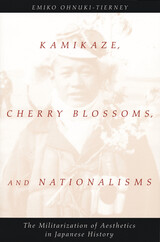 Kamikaze, Cherry Blossoms, and Nationalisms: The Militarization of Aesthetics in Japanese History
Emiko Ohnuki-Tierney
University of Chicago Press, 2002 Why did almost one thousand highly educated "student soldiers" volunteer to serve in Japan's tokkotai (kamikaze) operations near the end of World War II, even though Japan was losing the war? In this fascinating study of the role of symbolism and aesthetics in totalitarian ideology, Emiko Ohnuki-Tierney shows how the state manipulated the time-honored Japanese symbol of the cherry blossom to convince people that it was their honor to "die like beautiful falling cherry petals" for the emperor.
Drawing on diaries never before published in English, Ohnuki-Tierney describes these young men's agonies and even defiance against the imperial ideology. Passionately devoted to cosmopolitan intellectual traditions, the pilots saw the cherry blossom not in militaristic terms, but as a symbol of the painful beauty and unresolved ambiguities of their tragically brief lives. Using Japan as an example, the author breaks new ground in the understanding of symbolic communication, nationalism, and totalitarian ideologies and their execution.
 Kamikaze Diaries: Reflections of Japanese Student Soldiers
Emiko Ohnuki-Tierney
University of Chicago Press, 2006 “We tried to live with 120 percent intensity, rather than waiting for death. We read and read, trying to understand why we had to die in our early twenties. We felt the clock ticking away towards our death, every sound of the clock shortening our lives.” So wrote Irokawa Daikichi, one of the many kamikaze pilots, or tokkotai, who faced almost certain death in the futile military operations conducted by Japan at the end of World War II.
This moving history presents diaries and correspondence left by members of the tokkotai and other Japanese student soldiers who perished during the war. Outside of Japan, these kamikaze pilots were considered unbridled fanatics and chauvinists who willingly sacrificed their lives for the emperor. But the writings explored here by Emiko Ohnuki-Tierney clearly and eloquently speak otherwise. A significant number of the kamikaze were university students who were drafted and forced to volunteer for this desperate military operation. Such young men were the intellectual elite of modern Japan: steeped in the classics and major works of philosophy, they took Descartes’ “I think, therefore I am” as their motto. And in their diaries and correspondence, as Ohnuki-Tierney shows, these student soldiers wrote long and often heartbreaking soliloquies in which they poured out their anguish and fear, expressed profound ambivalence toward the war, and articulated thoughtful opposition to their nation’s imperialism.
A salutary correction to the many caricatures of the kamikaze, this poignant work will be essential to anyone interested in the history of Japan and World War II.
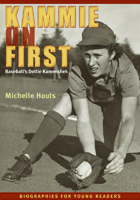 Kammie on First: Baseball’s Dottie Kamenshek
Michelle Houts
Ohio University Press, 2014 Dorothy Mary Kamenshek was born to immigrant parents in Norwood, Ohio. As a young girl, she played pickup games of sandlot baseball with neighborhood children; no one, however, would have suspected that at the age of seventeen she would become a star athlete at the national level. The outbreak of World War II and the ensuing draft of able-bodied young men severely depleted the ranks of professional baseball players. In 1943, Philip K. Wrigley, owner of the Chicago Cubs, led the initiative to establish a new league—a women’s league—to fill the ballparks while the war ground on in Europe and the Pacific. Kamenshek was selected and assigned to the Rockford Peaches in their inaugural season and played first base for a total of ten years, becoming a seven-time All-Star and holder of two league batting titles. When injuries finally put an end to her playing days, she went on to a successful and much quieter career in physical therapy. Fame came again in 1992, when Geena Davis portrayed a player loosely based on Kamenshek in the hit movie A League of Their Own. Kammie on First is a real-life tale that will entertain and inspire young readers, both girls and boys. It is the first book in a new series, Biographies for Young Readers, from Ohio University Press.
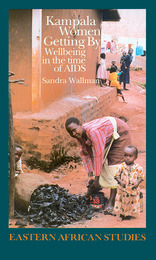 Kampala Women Getting By: Wellbeing in the Time of AIDS
Sandra Wallman
Ohio University Press, 1996 What do ordinary women in an African city do in the face of “serious enough” infections in themselves and signs of acute illness in their young children? How do they manage? What does it take to get by? How do they maintain the wellbeing of the household in a setting without what would be considered as basic health provision in an American or European city? Professor Wallman focuses on women in a densely-populated part of Kampala called Kamwokya. With the help of a team of Ugandans and non-Ugandans, a vivid picture emerges, enhanced by color photographs, sketches and maps. Women are largely responsible for the management of illness in all members of the family. Young children are at particular risk and the women have to take the first crucial decisions about treatment. Formal health resources are scarce and so they most often resort to an extraordinary range of treatments provided in the informal economy. A holistic picture of all the options that local people recognize is drawn, and an enriched understanding of problems and opportunities for health care in tropical cities emerges. Multidisciplinary work on sexually transmitted disease is rare, even in this time of AIDS, and the book effectively maps the social contexts of its perception and management. Moreover, it focuses on women as ordinary citizens, selected by residence and not by reference to known medical conditions or high risk behavior. It is important too that the field strategies have encouraged local informants to become active participants in the definition of local problems and their solutions.
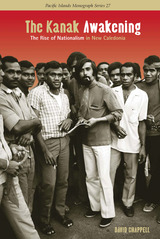 The Kanak Awakening: The Rise of Nationalism in New Caledonia
David Chappell
University of Hawaii Press, 2014 In 1853, France annexed the Melanesian islands of New Caledonia to establish a convict colony and strategic port of call. Unlike other European settler–dominated countries in the Pacific, the territory’s indigenous people remained more numerous than immigrants for over a century. Despite military conquest, land dispossession, and epidemics, its thirty language groups survived on tribal reserves and nurtured customary traditions and identities. In addition, colonial segregation into the racial category of canaques helped them to find new unity. When neighboring anglophone colonies began to decolonize in the 1960s, France retained tight control of New Caledonia for its nickel reserves, reversing earlier policies that had granted greater autonomy for the islands. Anticolonial protest movements culminated in the 1980s Kanak revolt, after which two negotiated peace accords resulted in autonomy in a progressive form and officially recognized Kanak identity for the first time. But the near-parity of settlers and Kanak continues to make nation-building a challenging task, despite a 1998 agreement among Kanak and settlers to seek a “common destiny.”
This study examines the rise in New Caledonia of rival identity formations that became increasingly polarized in the 1970s and examines in particular the emergence of activist discourses in favor of Kanak cultural nationalism and land reform, multiracial progressive sovereignty, or a combination of both aspirations. Most studies of modern New Caledonia focus on the violent 1980s uprising, which left deep scars on local memories and identities. Yet the genesis of that rebellion began with a handful of university students who painted graffiti on public buildings in 1969, and such activists discussed many of the same issues that face the country’s leadership today. After examining the historical, cultural, and intellectual background of that movement, this work draws on new research in public and private archives and interviews with participants to trace the rise of a nationalist movement that ultimately restored self-government and legalized indigenous aspirations for sovereignty in a local citizenship with its own symbols. Kanak now govern two out of three provinces and have an important voice in the Congress of New Caledonia, but they are a slight demographic minority. Their quest for nationhood must achieve consensus with the immigrant communities, much as the founders of the independence movement in the 1970s recommended.
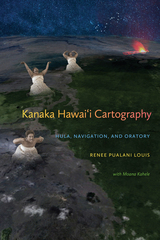 Kanaka Hawai'i Cartography: Hula, Navigation, and Oratory
Renee Pualani Louis
Oregon State University Press, 2017 Hawai'ian performance cartography is an interactive presentation of place as ‘experienced space’ that situates mapping in the environment, and encodes spatial knowledge into bodily memory via repetitive recitations and other habitual practices.
An important symbolic element in Hawai'ian cartography is the storied place name, which reflects Hawai'ian spatial knowledge of the environment. Many Hawai'ian place names performed in daily rituals were a conscious act of locating genealogical connections, recreating cultural landscapes, and regenerating cultural mores. They constitute a critically important body of Hawai'ian cultural knowledge. When Hawai'ian place names were incorporated into Western cartographic maps they were transformed epistemologically. They went from representing place as a repository of cultural knowledge to representing place as an object on the landscape. Hawai'ian spatial knowledge presentation is interactive, multi-sensual, and multi‐ dimensional.
Kanaka Hawai'i Cartography interweaves methodology with personal narrative and performance presentation in a playbill format. Three of the seven chapters are presented as “Acts” in a play. The remaining four chapters serve as intermissions or interludes together with a prologue and an epilogue for setting the stage and providing closure. To help make the topic more accessible, complex terms have been minimized, making academic theory easier for the educated reader to understand. The book will fill an important gap in Indigenous and Native Studies and will be welcomed by anyone interested in traditional Hawai’ian performance cartography.
The Kandik Map
Linda Johnson
University of Alaska Press, 2009 In 1880, a Native American named Paul Kandik and a French explorer, François Mercier, traveled across northeastern Alaska and western Canada to create the earliest known map of the region. Linda Johnson now delves into the fascinating story behind the Kandik Map, examining the reasons why and how these two men from such different backgrounds combined their extensive knowledge of the country to map the Kandik River region. Drawing on historical letters, geographical analysis, and the original map itself held in the University of California’s Bancroft Library, Johnson produces a groundbreaking study on the history of the Kandik Map and reveals its significant implications for Native American scholarship.
Kane from Canada
Mary Kane
Arizona Center for Medieval and Renaissance Studies, 2016
Kanji For Comprehending Technical Japanese
Edward E. Daub
University of Wisconsin Press, 1995 Designed as a companion and study guide for the textbook Comprehending Technical Japanese, this book may also be used as a supplement to the textbook Basic Technical Japanese. It provides detailed explanations of the origin and meaning of the 500 kanji featured in CTJ, which were chosen for their frequency and significance in chemistry, physics, and biology.
Each chapter is keyed to a chapter in CTJ, presenting twenty kanji, vocabulary that use those kanji, a kanji-card format for study and review, and the Japanese essay that appears at the close of each CTJ chapter, and its English translation. This volume also introduces significant scientific vocabulary that include kanji other than the 500 introduced in CTJ.
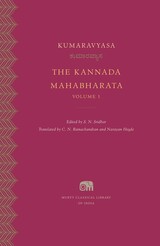 The Kannada Mahabharata
Kumaravyasa
Harvard University Press, 2024 The classic Kannada version of the Mahabharata, a jewel of world literature, translated into English.
The Mahabharata, a cornerstone of ancient Indian literature, recounts the rivalry between branches of a royal family, the Pandavas and the Kauravas, culminating in a cataclysmic war. It has inspired numerous adaptations across languages and artistic media.
The Kannada Mahabharata, known as Kumāravyāsa Bhārata, is an innovative retelling where Krishna occupies center stage, composed by the fifteenth-century poet Kumaravyasa. His powerful verses critique kingship and caste and remain popular in musical performances and improvisational folk theatre today.
Volume 1 comprises “The Book of Beginnings” and “The Book of the Assembly,” including Pandu’s tragic death, the marriage of the Pandavas to Draupadi, Arjuna’s fiery destruction of the Khandava forest, the slaying of King Shishupala, and the dice game plotted by the Kauravas leading to the Pandavas’s exile.
This edition, which abridges the Kannada classic, presents a new English translation and the most reliable text of the original in the Kannada script.
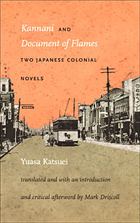 Kannani and Document of Flames: Two Japanese Colonial Novels
Katsuei Yuasa
Duke University Press, 2005 This volume makes available for the first time in English two of the most important novels of Japanese colonialism: Yuasa Katsuei’s Kannani and Document of Flames. Born in Japan in 1910 and raised in Korea, Yuasa was an eyewitness to the ravages of the Japanese occupation. In both of the novels presented here, he is clearly critical of Japanese imperialism. Kannani (1934) stands alone within Japanese literature in its graphic depictions of the racism and poverty endured by the colonized Koreans. Document of Flames (1935) brings issues of class and gender into sharp focus. It tells the story of Tokiko, a divorced woman displaced from her Japanese home who finds herself forced to work as a prostitute in Korea to support herself and her child. Tokiko eventually becomes a landowner and oppressor of the Koreans she lives amongst, a transformation suggesting that the struggle against oppression often ends up replicating the structure of domination. In his introduction, Mark Driscoll provides a nuanced and engaging discussion of Yuasa’s life and work and of the cultural politics of Japanese colonialism. He describes Yuasa’s sharp turn, in the years following the publication of Kannani and Document of Flames, toward support for Japanese nationalism and the assimilation of Koreans into Japanese culture. This abrupt ideological reversal has made Yuasa’s early writing—initially censored for its anticolonialism—all the more controversial. In a masterful concluding essay, Driscoll connects these novels to larger theoretical issues, demonstrating how a deep understanding of Japanese imperialism challenges prevailing accounts of postcolonialism.
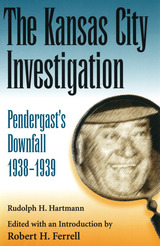 The Kansas City Investigation: Pendergast's Downfall, 1938-1939
Rudolph H. Hartmann, Edited & Intro by Robert H. Ferrell
University of Missouri Press, 1999 The long reign of Kansas City political boss Thomas J. Pendergast came to an end in 1939, after an investigation led by Special Agent Rudolph Hartmann of the U.S. Department of the Treasury resulted in Pendergast's conviction for income tax evasion. In 1942, Hartmann's account was submitted to Secretary of the Treasury Henry Morgenthau, Jr., in whose papers it remained for the past fifty-six years unbeknownst to historians. While researching the relations between Pendergast and Franklin D. Roosevelt, Robert H. Ferrell came across Hartmann's landmark report—the only firsthand account of the investigation that brought down the greatest political machine of its time, possibly one of the greatest in all of American history. Reading like a "whodunit," The Kansas City Investigation traces Pendergast's political career from its beginnings to its end. As one of America's major city bosses, Pendergast was at the height of his influence in 1935-1936 when his power reached not merely to every ward and precinct in Kansas City but also to the statehouse in Jefferson City and Capitol Hill in Washington, D.C. It was during this time that the boss took a massive bribe—$315,000—from 137 national fire insurance companies operating within Missouri, opening him to attack by his enemies. Early in 1938, an official in the Washington headquarters of the Bureau of Internal Revenue, a former Missourian, quit his job to accept private employment, but not without first tipping off a reporter from the Kansas City Star about Pendergast's bribe. The reporter immediately phoned Lloyd C. Stark, the governor of Missouri and a known enemy of Pendergast. Stark then went to Washington to inform President Roosevelt. Although the president had been a supporter of Pendergast, he now considered Stark a more important political ally. Roosevelt asked the Treasury Department to investigate Pendergast's income taxes. The intelligence unit of the Treasury Department put Hartmann, its best operative, on the case. Within a year, after the most minute of inquiries into checkbooks, serial numbers on currency, a safe-deposit box, and a telegraphed transfer of $10,000, Hartmann and his agents found enough evidence to convict Boss Tom. More than a simple account of what the Roosevelt administration did to cause the collapse of the Pendergast machine, The Kansas City Investigation takes the reader through the ups and downs, twists and turns, of this intriguing investigation, all from an insider's perspective. More important, Hartmann's report provides historians and readers alike the opportunity to evaluate the machine era in American political history—an era that, according to the investigation, "proved the old axiom that `truth is stranger than fiction.'"
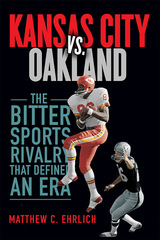 Kansas City vs. Oakland: The Bitter Sports Rivalry That Defined an Era
Matthew C. Ehrlich
University of Illinois Press, 2019 A driving ambition linked Oakland and Kansas City in the 1960s. Each city sought the national attention and civic glory that came with being home to professional sports teams. Their successful campaigns to lure pro franchises ignited mutual rivalries in football and baseball that thrilled hometown fans. But even Super Bowl victories and World Series triumphs proved to be no defense against urban problems in the tumultuous 1960s and 1970s. Matthew C. Ehrlich tells the fascinating history of these iconic sports towns. From early American Football League battles to Oakland's deft poaching of baseball's Kansas City Athletics, the cities emerged as fierce opponents from Day One. Ehrlich weaves a saga of athletic stars and folk heroes like Len Dawson, Al Davis, George Brett, and Reggie Jackson with a chronicle of two cities forced to confront the wrenching racial turmoil, labor conflict, and economic crises that arise when soaring aspirations collide with harsh realities.Colorful and thought-provoking, Kansas City vs. Oakland breaks down who won and who lost when big-time sports came to town.
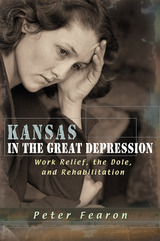 Kansas in the Great Depression: Work Relief, the Dole, and Rehabilitation
Peter Fearon
University of Missouri Press, 2007
No part of the United States escaped the ravages of the Great Depression, but some coped with it better than others. This book examines New Deal relief programs in Kansas throughout the Depression, focusing on the relationship between the state and the federal government to show how their successful operation depended on the effectiveness of that partnership.
Ranging widely over all of Kansas’s 105 counties, Peter Fearon provides a detailed analysis of the key relief programs for both urban and rural areas and shows that the state’s Republican administration—led by FDR’s later presidential opponent Governor Alf Landon—effectively ran New Deal welfare policies. As early as 1933, federal officials reported the Kansas central relief administration to be one of the most efficient in the country, and funding for farm policies was generous enough to keep many Kansas farm families off the relief rolls. Indeed, historically high levels of social spending ensured that New Deal initiatives were radical for their day, but Fearon shows that, especially in Kansas, fears of the debilitating effects of the dole and the insistence on means testing and work relief served as conservative balances to the threat of a dependency culture.
Drawing on extensive research at the county level, Fearon examines relief problems from the perspective of recipients, social workers, and poor commissioners, all of whom had to cope with inadequate and fluctuating funding. He plumbs the sometimes volatile relationships between social workers and their clients to illustrate the formidable difficulties faced by the former and explain reasons for—and effects of—strikes and riots by the latter. He also investigates the operation of work relief, considers the treatment of women and blacks in the distribution of welfare resources, and assesses the effects of the WPA on employment—showing that the majority of those eligible were unable to secure positions and were forced to fall back on county relief.
Kansas in the Great Depression is an insightful look at how federal, state, and local authorities worked together to deal with a national emergency, revealing the complexities of policy initiatives not generally brought to light in studies at the national level while establishing important links between pre-Roosevelt policies and the New Deal. It reaffirms the virtues of government programs run by dedicated public officials as it opens a new window on Americans helping Americans in their darkest hours.
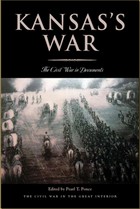 Kansas’s War: The Civil War in Documents
Pearl T. Ponce
Ohio University Press, 2011 When the Civil War broke out in April 1861, Kansas was in a unique position. It had been a state for mere weeks, and already its residents were intimately acquainted with civil strife. Since its organization as a territory in 1854, Kansas had been the focus of a national debate over the place of slavery in the Republic. By 1856, the ideological conflict developed into actual violence, earning the territory the sobriquet “Bleeding Kansas.” Because of this steady escalation in violence, the state’s transition from peace to war was not as abrupt as that of other states.
Kansas’s War illuminates the new state’s main preoccupations: the internal struggle for control of policy and patronage; border security; and issues of race—especially efforts to come to terms with the burgeoning African American population and Native Americans’ coninuing claims to nearly one-fifth of the state’s land. These documents demonstrate how politicians, soldiers, and ordinary Kansans were transformed by the war.
 Kant: A Revolution in Thinking
Marcus Willaschek
Harvard University Press, 2025 A foremost Kant expert takes us on a lively tour through the revolutionary ideas of the founder of modern philosophy.
Immanuel Kant is undoubtedly the most important philosopher of the modern era. His Critique of Pure Reason, “categorical imperative,” and conception of perpetual peace in the global order decisively influenced both intellectual history and twentieth-century politics, shaping everything from the German Constitution to the United Nations Charter.
Renowned philosopher Marcus Willaschek explains why, three centuries after Kant’s birth, his reflections on democracy, beauty, nature, morality, and the limits of human knowledge remain so profoundly relevant. Weaving biographical and historical context together with exposition of key ideas, Willaschek emphasizes three central features of Kant’s theory and method. First, Kant combines seemingly incompatible positions to show how their insights can be reconciled. Second, he demonstrates that it is not only human thinking that must adjust to the realities of the world; the world must also be fitted to the structures of our thinking. Finally, he overcomes the traditional opposition between thought and action by putting theory at the service of practice.
In Kant: A Revolution in Thinking, even readers having no prior acquaintance with Kant’s ideas or with philosophy generally will find an adroit introduction to the Prussian polymath’s oeuvre, beginning with his political arguments, expanding to his moral theory, and finally moving to his more abstract considerations of natural science, epistemology, and metaphysics. Along the way, Kant himself emerges from beneath his famed works, revealing a magnetic personality, a clever ironist, and a man deeply engaged with his contemporary world.
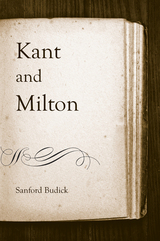 Kant and Milton
Sanford Budick
Harvard University Press, 2010 Kant and Milton brings to bear new evidence and long-neglected materials to show the importance of Kant’s encounter with Milton’s poetry to the formation of Kant’s moral and aesthetic thought. Sanford Budick reveals the relation between a poetic vision and a philosophy that theorized what that poetry was doing. As Plato and Aristotle contemplate Homer, so Kant contemplates Milton. In all these cases philosophy and poetry allow us to better understand each other. Milton gave voice to the transformation of human understanding effected by the Protestant Revolt, making poetry of the idea that human reason is created self-sufficient. Kant turned that religiously inflected poetry into the richest modern philosophy. Milton’s bold self-reliance is Kant’s as well.Using lectures of Kant that have been published only in the past decade, Budick develops an account of Kant based on his lifelong absorption in the poetry of Milton, especially Paradise Lost. By bringing to bear the immense power of his reflections on aesthetic and moral form, Kant produced one of the most penetrating interpretations of Milton’s achievement that has ever been offered and, at the same time, reached new peaks in the development of aesthetics and moral reason.
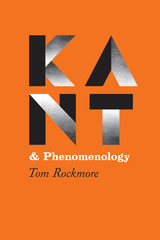 Kant and Phenomenology
Tom Rockmore
University of Chicago Press, 2010 Phenomenology, together with Marxism, pragmatism, and analytic philosophy, dominated philosophy in the twentieth century—and Edmund Husserl is usually thought to have been the first to develop the concept. His views influenced a variety of important later thinkers, such as Heidegger and Merleau-Ponty, who eventually turned phenomenology away from questions of knowledge. But here Tom Rockmore argues for a return to phenomenology’s origins in epistemology, and he does so by locating its roots in the work of Immanuel Kant.
Kant and Phenomenology traces the formulation of Kant’s phenomenological approach back to the second edition of Kant’s Critique of Pure Reason. In response to various criticisms of the first edition, Kant more forcefully put forth a constructivist theory of knowledge. This shift in Kant’s thinking challenged the representational approach to epistemology, and it is this turn, Rockmore contends, that makes Kant the first great phenomenologist. He then follows this phenomenological line through the work of Kant’s idealist successors, Fichte and Hegel. Steeped in the sources and literature it examines, Kant and Phenomenology persuasively reshapes our conception of both of its main subjects.
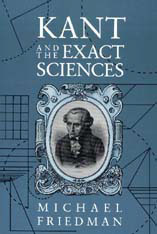 Kant and the Exact Sciences
Michael Friedman
Harvard University Press, 1992 Kant sought throughout his life to provide a philosophy adequate to the sciences of his time—especially Euclidean geometry and Newtonian physics. In this new book, Michael Friedman argues that Kant’s continuing efforts to find a metaphysics that could provide a foundation for the sciences is of the utmost importance in understanding the development of his philosophical thought from its earliest beginnings in the thesis of 1747, through the Critique of Pure Reason, to his last unpublished writings in the Opus postumum.
Previous commentators on Kant have typically minimized these efforts because the sciences in question have since been outmoded. Friedman argues that, on the contrary, Kant’s philosophy is shaped by extraordinarily deep insight into the foundations of the exact sciences as he found them, and that this represents one of the greatest strengths of his philosophy. Friedman examines Kant’s engagement with geometry, arithmetic and algebra, the foundations of mechanics, and the law of gravitation in Part One. He then devotes Part Two to the Opus postumum, showing how Kant’s need to come to terms with developments in the physics of heat and in chemistry formed a primary motive for his projected Transition from the Metaphysical Foundations of Natural Science to Physics.
Kant and the Exact Sciences is a book of high scholarly achievement, argued with impressive power. It represents a great advance in our understanding of Kant’s philosophy of science.
 Kant and the Limits of Autonomy
Susan Meld Shell
Harvard University Press, 2009 Autonomy for Kant is not just a synonym for the capacity to choose, whether simple or deliberative. It is what the word literally implies: the imposition of a law on one’s own authority and out of one’s own rational resources. In Kant and the Limits of Autonomy, Shell explores the limits of Kantian autonomy—both the force of its claims and the complications to which they give rise. Through a careful examination of major and minor works, Shell argues for the importance of attending to the difficulty inherent in autonomy and to the related resistance that in Kant’s view autonomy necessarily provokes in us. Such attention yields new access to Kant’s famous, and famously puzzling, Groundlaying of the Metaphysics of Morals. It also provides for a richer and more unified account of Kant’s later political and moral works; and it highlights the pertinence of some significant but neglected early writings, including the recently published Lectures on Anthropology.
Kant and the Limits of Autonomy is both a rigorous, philosophically and historically informed study of Kantian autonomy and an extended meditation on the foundation and limits of modern liberalism.
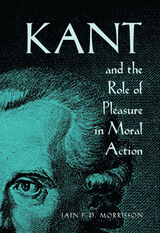 Kant and the Role of Pleasure in Moral Action
Iain P. D. Morrisson
Ohio University Press, 2008 Kant scholars since the early nineteenth century have disaxadgreed about how to interpret his theory of moral motivation. Kant tells us that the feeling of respect is the incentive to moral action, but he is notoriously ambiguous on the question of what exactly this means. In Kant and the Role of Pleasure in Moral Action, Iain Morrisson offers a new view on Kant’s theory of moral action. In a clear, straightforward style, Morrisson responds to the ongoing interpretive stalemate by taking an original approach to the problem. Whereas previous commentators have attempted to understand Kant’s feeling of respect by studying the relevant textual evidence in isolation, Morrisson illuminates this evidence by determining what Kant’s more general theory of action commits him to regarding moral action. After looking at how Kant’s treatment of desire and feeling can be reconciled with his famous account of free maxim-based action, Morrisson argues that respect moves us to moral action in a way that is structurally parallel to the way in which nonmoral pleasure motivates nonmoral action. In reconstructing a unified theory of action in Kant, Morrisson integrates a number of distinct elements in his practical philosophy. Kant and the Role of Pleasure in Moral Action is part of a new wave of interest in Kant’s anthropological (that is, psychological) works.
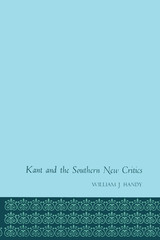 Kant and the Southern New Critics
By William J. Handy
University of Texas Press, 1963 An author’s true meaning has always been largely a matter of opinion among literary critics, even when only objective language was analyzed. However, a writer’s inner meaning, which perhaps not even he or she consciously realizes, interests the “new critics,” who base their theory of criticism on the writings of Immanuel Kant and hold philosophical values to be essential in studying a literary work. William J. Handy, a former student of John Crowe Ransom, himself a critic of note, reveals the inadequacy of logical concept to represent the full quality of human experience. In Kant and the Southern New Critics he discusses the theories and practices of some pioneers of philosophical criticism—John Crowe Ransom, Allen Tate, Cleanth Brooks, and others—and traces the influence of the Kantian generative idea on their assumption that a work of art is the celebration of one’s qualitative experience. Critics in the new school believe that knowledge of experience is distorted when abstracted into scientific, quantitative notations, and that the artist, to portray things in their more natural state, must employ particulars in order to achieve “universals.” Knowledge of any subject or object must include the aesthetic qualities of imagination and emotion that cannot be discovered through analysis. This study explores Ransom’s theory of “ontological criticism.” The basic difference in symbols representing things and those representing ideas was discerned by Kant, who distinguished between understanding (analysis of an object in order to classify it)and imagination (realization of an object undistorted by logical reduction). Handysuggests that ontological structure requires a writer to use the logic that springs from his image-making faculty—a thought also expressed by T. S. Eliot, who says, “The only way of expressing emotion in the form of art is by finding an ‘objective correlative.’ ” The discipline of philosophical aesthetics is necessary for the critic, Handy says, if his principles are to be substantial enough to make a significant contribution to knowledge of literary theory. This book clearly delineates the origins of a philosophical approach and leads the reader to an appreciation of the deeper enjoyment and meaning it can give to literary experience.
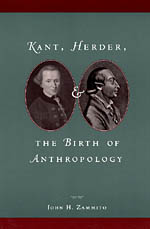 Kant, Herder, and the Birth of Anthropology
John H. Zammito
University of Chicago Press, 2001 If Kant had never made the "critical turn" of 1773, would he be worth more than a paragraph in the history of philosophy? Most scholars think not. But in this pioneering book, John H. Zammito challenges that view by revealing a precritical Kant who was immensely more influential than the one philosophers think they know. Zammito also reveals Kant's former student and latter-day rival, Johann Herder, to be a much more philosophically interesting thinker than is usually assumed and, in many important respects, historically as influential as Kant.
Relying on previously unexamined sources, Zammito traces Kant's friendship with Herder as well as the personal tensions that destroyed their relationship. From this he shows how two very different philosophers emerged from the same beginnings and how, because of Herder's reformulation of Kant, anthropology was born out of philosophy.
Shedding light on an overlooked period of philosophical development, this book is a major contribution to the history of philosophy and the social sciences, and especially to the history of anthropology.
 Kant, Kantianism, and Idealism: The Origins of Continental Philosophy
Edited by Thomas J. Nenon
University of Chicago Press, 2010 From Kant to Kierkegaard, from Hegel to Heidegger, continental philosophers have indelibly shaped the trajectory of Western thought since the eighteenth century. Although much has been written about these monumental thinkers, students and scholars lack a definitive guide to the entire scope of the continental tradition. The most comprehensive reference work to date, this eight-volume History of Continental Philosophy will both encapsulate the subject and reorient our understanding of it. Beginning with an overview of Kant’s philosophy and its initial reception, the History traces the evolution of continental philosophy through major figures as well as movements such as existentialism, phenomenology, hermeneutics, and poststructuralism. The final volume outlines the current state of the field, bringing the work of both historical and modern thinkers to bear on such contemporary topics as feminism, globalization, and the environment. Throughout, the volumes examine important philosophical figures and developments in their historical, political, and cultural contexts.
The first reference of its kind, A History of Continental Philosophy has been written and edited by internationally recognized experts with a commitment to explaining complex thinkers, texts, and movements in rigorous yet jargon-free essays suitable for both undergraduates and seasoned specialists. These volumes also elucidate ongoing debates about the nature of continental and analytic philosophy, surveying the distinctive, sometimes overlapping characteristics and approaches of each tradition. Featuring helpful overviews of major topics and plotting road maps to their underlying contexts, A History of Continental Philosophy is destined to be the resource of first and last resort for students and scholars alike.
 Kant on Causality, Freedom, and Objectivity
William L. Harper and Ralf Meerbote, Editors
University of Minnesota Press, 1984 Kant on Causality, Freedom, and Objectivity was first published in 1984. Minnesota Archive Editions uses digital technology to make long-unavailable books once again accessible, and are published unaltered from the original University of Minnesota Press editions. Kant's account of causation is central to his views on objective truth and freedom. The Second Analogy of Experience, in the Critique of Pure Reason,where he provides his defense of the causal principle, has long been the focus of intense philosophical research. In the past twenty years, there have been two major periods of interest in Kantian themes, The first coincided with a general turn away from positivism by analytic philosophers, and resulted in a fruitful interchange between Kant scholars and those who applied Kantian ideas to contemporary philosophical problems. In recent years, a new surge of interest in Kant's work occurred along with the developing controversy over realism generated by the work of Dummett and Putnam. Scholars now appreciate the extent to which the Kantian causal principle is illuminated by the philosopher's argument that his transcendental idealism supports an empirical realism. And in turn, Kant's views on objectivity, causation, and freedom are especially relevant to the philosophical concerns raised by the new debate over realism. The eight papers in this book are drawn from two conferences that honored Lewis White Beck, an influential Kant scholar. Together with the introductory essay by the editors, they show the continuing relevance of Kant's analysis for the present-day philosophy of causation.
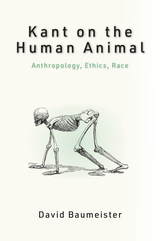 Kant on the Human Animal: Anthropology, Ethics, Race
David Baumeister
Northwestern University Press, 2022 While Immanuel Kant’s account of human reason is well known and celebrated, his account of human animality (Thierheit) is virtually unknown. Animality and reason, as pillars of Kant’s vision of human nature, are original and ineradicable. And yet, the relation between them is fraught: at times tense and violent, at other times complementary, even harmonious. Kant on the Human Animal offers the first systematic analysis of this central but neglected dimension of Kant’s philosophy.
David Baumeister tracks four decades of Kant’s intellectual development, surveying works published in Kant’s lifetime along with posthumously published notes and student lecture transcripts. They show the crucial role that animality plays in many previously unconnected areas of Kant’s thought, such as his account of the human’s originally quadrupedal posture, his theory of early childhood development, and his conception of the process of human racial differentiation. Beginning with a delineation of Kant’s understanding of the commonalities and differences between humans and other animals, Baumeister focuses on the contribution of animality to Kant’s views of ethics, anthropology, human nature, and race.
Placing divergent features of Kant’s thought within a unified interpretive framework, Kant on the Human Animal reveals how, for Kant, becoming human requires that animality not be eclipsed and overcome but rather disciplined and developed. What emerges is a new appreciation of Kant’s human being as the human animal it is.
Kant, Ontology, and the A Priori
Moltke S. Gram
Northwestern University Press, 1968 Kant, Ontology, and the A Priori is a close study of Kant’s conception of metaphysical propositions. In it Moltke Gram aims to show in what sense Kant is offering a theory of metaphysical propositions about objects in general. Gram presents a criticism of the tendency to focus on Kant’s theory of dialectic as the source of paradigm cases of metaphysical propositions.
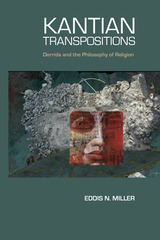 Kantian Transpositions: Derrida and the Philosophy of Religion
Eddis N. Miller
Northwestern University Press, 2019 Kantian Transpositions presents an important new reading of Jacques Derrida’s writings on religion and ethics. Eddis Miller argues that Derrida’s late texts on religion constitute an interrogation of the meaning and possibility of a “philosophy of religion.” It is the first book to fully engage Derrida’s claim, in “Faith and Knowledge: The Two Sources of ‘Religion’ at the Limits of Reason Alone” to be transposing the Kantian gesture of thinking religion “within the limits of reason alone.” Miller outlines the terms of this “transposition” and reads Derrida’s work as an attempt to enact such a transposition. Along the way, he stakes out new ground in the debate over deconstruction and ethics, showing—against recent interpretations of Derrida’s work—that there is an ethical moment in Derrida’s writings that cannot be understood properly without accounting for the decisive role played by Kant’s ethics. The result is the most sustained demonstration yet offered of Kant’s indispensible contribution to Derrida’s thought.
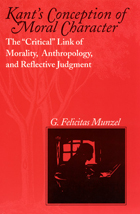 Kant's Conception of Moral Character: The "Critical" Link of Morality, Anthropology, and Reflective Judgment
G. Felicitas Munzel
University of Chicago Press, 1999 Currently fashionable among critics of enlightenment thought is the charge that Kant's ethics fails to provide an adequate account of character and its formation in moral and political life. G. Felicitas Munzel challenges this reading of Kant's thought, claiming not only that Kant has a very rich notion of moral character, but also that it is a conception of systematic importance for his thought, linking the formal moral with the critical, aesthetic, anthropological, and biological aspects of his philosophy.
The first book to focus on character formation in Kant's moral philosophy, it builds on important recent work on Kant's aesthetics and anthropology, and brings these to bear on moral issues. Munzel traces Kant's multifaceted definition of character through the broad range of his writings, and then explores the structure of character, its actual exercise in the world, and its cultivation.
An outstanding work of original textual analysis and interpretation, Kant's Conception of Moral Character is a major contribution to Kant studies and moral philosophy in general.
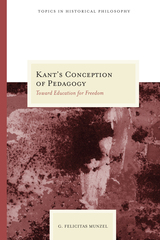 Kant's Conception of Pedagogy: Toward Education for Freedom
G. Felicitas Munzel
Northwestern University Press, 2012 Although Kant was involved in the education debates of his time, it is widely held that in his mature philosophical writings he remained silent on the subject. In her groundbreaking Kant’s Conception of Pedagogy, G. Felicitas Munzel finds extant in Kant’s writings the so-called missing critical treatise on education. It appears in the Doctrines of Method with which he concludes each of his major works.
In it, Kant identifies the fundamental principles for the cultivation of reason’s judgment when it comes to cognition, beauty, nature, and the exercise of morality while subject to the passions and inclinations that characterize the human experience.
From her analysis, Munzel extrapolates principles for a cosmopolitan education that parallels the structure of Kant’s republican constitution for perpetual peace. With the formal principles in place, the argument concludes with a query of the material principles that would fulfill the formal conditions required for an education for freedom.
 Kant’s Final Synthesis: An Essay on the Opus postumum
Eckart Förster
Harvard University Press, 2000 This is the first book in English devoted entirely to Kant’s Opus postumum and its place in the Kantian oeuvre. Over the last few decades, the importance of this text for our understanding of Kant’s philosophy has emerged with increasing clarity.
Although Kant began it in order to solve a relatively minor problem within his philosophy, his reflections soon forced him to readdress virtually all the key problems of his critical philosophy: the objective validity of the categories, the dynamical theory of matter, the natures of space and time, the refutation of idealism, the theory of the self and its agency, the question of living organisms, the doctrine of the practical postulates and the idea of God, the unity of theoretical and practical reason, and the idea of transcendental philosophy itself. In the end Kant was convinced that these problems, some of which had preoccupied him throughout his career, could finally be brought to a coherent and adequate solution and integrated into a single philosophical conception.
As Eckart Förster shows in his penetrating study, Kant’s conviction deserves not only our intellectual respect but also our undivided philosophical attention. Förster provides detailed analyses of the key problems of Kant’s Opus postumum and also relates them to Kant’s major published writings. In this way he provides unique insights into the extraordinary continuity and inner dynamics of Kant’s transcendental philosophy as it progresses toward its final synthesis.
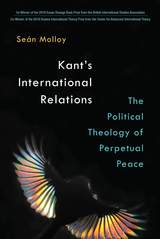 Kant's International Relations: The Political Theology of Perpetual Peace
Seán Molloy
University of Michigan Press, 2017 Why does Immanuel Kant (1724–1804) consistently invoke God and Providence in his most prominent texts relating to international politics? In this wide-ranging study, Seán Molloy proposes that texts such as Idea for a Universal History with Cosmopolitan Intent and Toward Perpetual Peace cannot be fully understood without reference to Kant’s wider philosophical projects, and in particular the role that belief in God plays within critical philosophy and Kant’s inquiries into anthropology, politics, and theology. Molloy’s broader view reveals the political-theological dimensions of Kant’s thought as directly related to his attempts to find a new basis for metaphysics in the sacrifice of knowledge to make room for faith.This book is certain to generate controversy. Kant is hailed as “the greatest of all theorists” in the field of International Relations (IR); in particular, he has been acknowledged as the forefather of Cosmopolitanism and Democratic Peace Theory. Yet, Molloy charges that this understanding of Kant is based on misinterpretation, neglect of particular texts, and failure to recognize Kant’s ambivalences and ambiguities. Molloy’s return to Kant’s texts forces devotees of Cosmopolitanism and other ‘Kantian’ schools of thought in IR to critically assess their relationship with their supposed forebear: ultimately, they will be compelled to seek different philosophical origins or to find some way to accommodate the complexity and the decisively nonsecular aspects of Kant’s ideas.
 Kant’s Methodology: An Essay in Philosophical Archeology
Charles P. Bigger
Ohio University Press, 1995 Kant’s revolution in methodology limited metaphysics to the conditions of possible experience. Since, following Hume, analysis—the “method of discovery” in early modern physics—could no longer ground itself in sense or in God’s constituting reason a new arché, “origin” and “principle,” was required, which Kant found in the synthesis of the productive imagination, the common root of sensibility and understanding. Charles Bigger argues that this imaginative “between” recapitulates the ancient Gaia myth which, as used by Plato in the Timaeus, offers a way into this originary arché. Since it depends on myth and the “likely story” rather than on a self-certain apprehension of Being, this facilitates an imaginative approach to the natural sciences which, through its synthetic a priori formations, can claim to be Kantian. Bigger explores Kant’s ethics as an alternative to metaphysics that holds open the prospect of a Good beyond Being—and phenomenology—whose traces nevertheless appear in original synthesis. Though wary of its reductive implications, Bigger uses Derrida’s difference, a medial, feminine arché, as a way into this creative and procreative metaxu (between). As Emmanuel Levinas suggests, this is Plato’s gap [chaos] between being and becoming, whose possibility, beyond both, lies in chora and the Good. This Open also presents the possibility for a new, yet still Kantian, understanding of the formal and material conditions for the natural sciences.
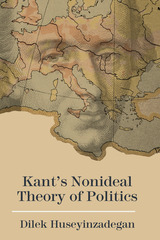 Kant’s Nonideal Theory of Politics
Dilek Huseyinzadegan
Northwestern University Press, 2019 Kant’s Nonideal Theory of Politics argues that Kant’s political thought must be understood by reference to his philosophy of history, cultural anthropology, and geography. The central thesis of the book is that Kant’s assessment of the politically salient features of history, culture, and geography generates a nonideal theory of politics, which supplements his well-known ideal theory of cosmopolitanism.
This novel analysis thus challenges the common assumption that an ideal theory of cosmopolitanism constitutes Kant’s sole political legacy. Dilek Huseyinzadegan demonstrates that Kant employs a teleological worldview throughout his political writings as a means of grappling with the pressing issues of multiplicity, diversity, and plurality—issues that confront us to this day.
Kant’s Nonideal Theory of Politics is the first book-length treatment of Kant’s political thought that gives full attention to the role that history, anthropology, and geography play in his mainstream political writings. Interweaving close textual analyses of Kant’s writings with more contemporary political frameworks, this book also makes Kant accessible and responsive to fields other than philosophy. As such, it will be of interest to students and scholars working at the intersections of political theory, feminism, critical race theory, and post- and decolonial thought.
 Kant's Organicism: Epigenesis and the Development of Critical Philosophy
Jennifer Mensch
University of Chicago Press, 2013 Because it laid the foundation for nearly all subsequent epistemologies, Immanuel Kant’s Critique of Pure Reason has overshadowed his other interests in natural history and the life sciences, which scholars have long considered as separate from his rigorous theoretical philosophy—until now. In Kant’s Organicism, Jennifer Mensch draws a crucial link between these spheres by showing how the concept of epigenesis—a radical theory of biological formation—lies at the heart of Kant’s conception of reason. As Mensch argues, epigenesis was not simply a metaphor for Kant but centrally guided his critical philosophy, especially the relationship between reason and the categories of the understanding. Offsetting a study of Kant’s highly technical theory of cognition with a mixture of intellectual history and biography, she situates the epigenesis of reason within broader investigations into theories of generation, genealogy, and classification, and against later writers and thinkers such as Goethe and Darwin. Distilling vast amounts of research on the scientific literature of the time into a concise and readable book, Mensch offers one of the most refreshing looks not only at Kant’s famous first Critique but at the history of philosophy and the life sciences as well.
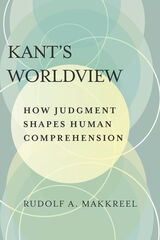 Kant's Worldview: How Judgment Shapes Human Comprehension
Rudolf A. Makkreel
Northwestern University Press, 2022 In Kant’s Worldview: How Judgment Shapes Human Comprehension, Rudolf A. Makkreel offers a new interpretation of Immanuel Kant’s theory of judgment that clarifies Kant’s well-known suggestion that a genuine philosophy is guided by a world‑concept (Weltbegriff). Makkreel shows that Kant increasingly expands the role of judgment from its logical and epistemic tasks to its reflective capacity to evaluate objects and contextualize them in worldly terms. And Makkreel shows that this final orientational power of judgment supplements the cognition of the understanding with the comprehension originally assigned to reason.
To comprehend, according to Kant, is to possess sufficient insight into situations so as to also achieve some purpose. This requires that reason be applied with the discernment that reflective judgment makes possible. Comprehension, practical as well as theoretical, can fill in Kant’s world concept and his sublime evocation of a Weltanschauung with a more down-to-earth worldview.
Scholars have recently stressed Kant’s impure ethics, his nonideal politics, and his pragmatism. Makkreel complements these efforts by using Kant’s ethical, sociopolitical, religious, and anthropological writings to provide a more encompassing account of the role of human beings in the world. The result is a major contribution to our understanding of Kant and the history of European philosophy.
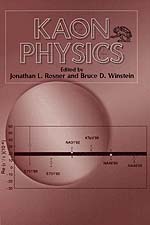 Kaon Physics
Edited by Jonathan L. Rosner and Bruce D. Winstein
University of Chicago Press, 2001 In 1947, the first of what have come to be known as "strange particles" were detected. As the number and variety of these particles proliferated, physicists began to try to make sense of them. Some seemed to have masses about 900 times that of the electron, and existed in both charged and neutral varieties. These particles are now called kaons (or K mesons), and they have become the subject of some of the most exciting research in particle physics. Kaon Physics at the Turn of the Millennium presents cutting-edge papers by leading theorists and experimentalists that synthesize the current state of the field and suggest promising new directions for the future study of kaons.
Topics covered include the history of kaon physics, direct CP violation in kaon decays, time reversal violation, CPT studies, theoretical aspects of kaon physics, rare kaon decays, hyperon physics, charm: CP violation and mixing, the physics of B mesons, and future opportunities for kaon physics in the twenty-first century.
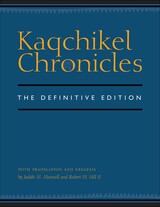 Kaqchikel Chronicles: The Definitive Edition
With translation and exegesis by Judith M. Maxwell and Robert M. Hill II
University of Texas Press, 2006 The collection of documents known as the Kaqchikel Chronicles consists of rare highland Maya texts, which trace Kaqchikel Maya history from their legendary departure from Tollan/Tula through their migrations, wars, the Spanish invasion, and the first century of Spanish colonial rule. The texts represent a variety of genres, including formal narrative, continuous year-count annals, contribution records, genealogies, and land disputes. While the Kaqchikel Chronicles have been known to scholars for many years, this volume is the first and only translation of the texts in their entirety. The book includes two collections of documents, one known as the Annals of the Kaqchikels and the other as the Xpantzay Cartulary. The translation has been prepared by leading Mesoamericanists in collaboration with Kaqchikel-speaking linguistic scholars. It features interlinear glossing, which allows readers to follow the translators in the process of rendering colonial Kaqchikel into modern English. Extensive footnoting within the text restores the depth and texture of cultural context to the Chronicles. To put the translations in context, Judith Maxwell and Robert Hill have written a full scholarly introduction that provides the first modern linguistic discussion of the phonological, morphological, syntactic, and pragmatic structure of sixteenth-century Kaqchikel. The translators also tell a lively story of how these texts, which derive from pre-contact indigenous pictographic and cartographic histories, came to be converted into their present form.
A Karamazov Companion: Commentary on the Genesis, Language, and Style of Dostoevsky's Novel
Victor Terras
University of Wisconsin Press, 1981 The text of The Brothers Karamazov is removed from English-speaking readers today not only by time but also by linguistic and cultural boundaries. Victor Terras’s companion work provides readers with a richer understanding of the Dostoevsky novel as the expression of a philosophy and a work of art.
In his introduction, Terras outlines the genesis, main ideas, and structural peculiarities of the novel as well as Dostoevsky’s political, philosophical, and aesthetic stance. The detailed commentary takes the reader through the novel, clarifying aspects of Russian life, the novel’s sociopolitical background, and a number of polemic issues. Terras identifies and explains hundreds of literary and biblical quotations and allusions. He discusses symbols, recurrent images, and structural stylistic patterns, including those lost in English translation.
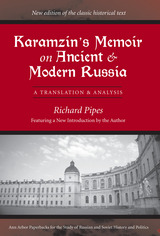 Karamzin's Memoir on Ancient and Modern Russia: A Translation and Analysis
Richard Pipes
University of Michigan Press, 2005 Russian history was typically studied through liberal or socialist lenses until Richard Pipes first published his translation of Karamzin's Memoir. Almost fifty years later, it is still the only English-language edition of this classic work. Still fresh and readable today, the Memoir-in which Alexander I's state historian elaborates his arguments for a strong Russian state-remains the most accessible introduction to the conservatism of Russia's ancien regime. This annotated translation is a "faithful rendition of the letter and spirit of the original," which not only introduces readers to the sweep of Karamzin's ideas, but also weaves together a fascinating version of Russia's rich history. With a new foreword by Richard Pipes, Karamzin's Memoir on Ancient and Modern Russia is a touchstone for anyone interested in Russia's fascinating and turbulent past. Richard Pipes is Baird Professor of History at Harvard University. Nikolai M. Karamzin (1766-1826) was a Russian historian, poet, and journalist. He was appointed court historian by Tsar Alexander I.
Karanis: Reports 1924-28: Topographic and Architectural Report of Excavations During the Seasons 1924-1928
By Arthur E.R. Boak and Enoch E. Peterson
University of Michigan Press, 1931 The University of Michigan Near East Research Expedition has been engaged since 1924–25 in the excavation of the site of ancient Karanis, now known as Kom Aushim or Kom Washim, on the northern border of the Fayyum to the east of Birket Qarun. Kom Aushim was selected as the target site in October 1924, because the ruins there were in a better state of preservation than at other Greco-Roman sites.
Karankawa
Iliana Rocha
University of Pittsburgh Press, 2015 Winner of the 2014 Donald Hall Prize for Poetry
Selected by Joy Harjo
Karankawa is a collection that explores some of the ways in which we (re)construct our personal histories. Rich in family narratives, myths, and creation stories, these are poems that investigate passage—dying, coming out, transforming, being born—as well as the gaps that also reside in our stories, for, as Rocha suggests, the opportunity to create myths is provided by great silences. Much like the Karankawa Indians whose history works in omissions, Karankawa reconfigures such spaces, engaging with the burden and freedom of memory in order to rework and recontextualize private and public mythologies. First and last, these are poems that honor our griefs and desires, for they keep alive the very things we cannot possess.
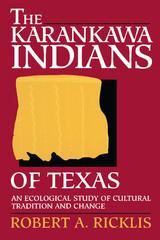 The Karankawa Indians of Texas: An Ecological Study of Cultural Tradition and Change
By Robert A. Ricklis
University of Texas Press, 1996 Popular lore has long depicted the Karankawa Indians as primitive scavengers (perhaps even cannibals) who eked out a meager subsistence from fishing, hunting and gathering on the Texas coastal plains. That caricature, according to Robert Ricklis, hides the reality of a people who were well-adapted to their environment, skillful in using its resources, and successful in maintaining their culture until the arrival of Anglo-American settlers. The Karankawa Indians of Texas is the first modern, well-researched history of the Karankawa from prehistoric times until their extinction in the nineteenth century. Blending archaeological and ethnohistorical data into a lively narrative history, Ricklis reveals the basic lifeway of the Karankawa, a seasonal pattern that took them from large coastal fishing camps in winter to small, dispersed hunting and gathering parties in summer. In a most important finding, he shows how, after initial hostilities, the Karankawa incorporated the Spanish missions into their subsistence pattern during the colonial period and coexisted peacefully with Euroamericans until the arrival of Anglo settlers in the 1820s and 1830s. These findings will be of wide interest to everyone studying the interactions of Native American and European peoples.
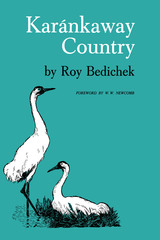 Karánkaway Country
By Roy Bedichek
University of Texas Press, 1974 Roy Bedichek spent most of his life working in the educational field in Texas, but his main interest was always the great outdoors. His first book, Adventures with a Texas Naturalist, was published when he was almost seventy, and his second, Karánkaway Country, appeared three years later. Both were the result of a lifetime of exploring a beloved land, of searching observation, of discussion, debate, wide reading, and reflection. Long out of print, Karánkaway Country is now available in a handsome second edition with a new Foreword by W. W. Newcomb, Jr. Karánkaway Country focuses on the natural history of a strip of coastal prairie lying roughly between Corpus Christi and Galveston and once inhabited by the poorly known and much maligned Karankawa Indians. It serves as home base for an exposition of Bedichek's philosophy, providing a convenient local setting for richly tailored essays on wildlife, soil, human skin, and a variety of other topics suggested by a wide-ranging intellect. Bedichek's philosophy, if it can be reduced to a few words, is essentially that humans must learn to live on peaceful and conciliatory terms with our natural environment.
 Karaoke Idols: Popular Music and the Performance of Identity
Kevin Brown
Intellect Books, 2015 Most ethnographers don’t achieve what Kevin Brown did while conducting their research: in his two years spent at a karaoke bar near Denver, Colorado, he went from barely able to carry a tune to someone whom other karaoke patrons requested to sing. Along the way, he learned everything you might ever want to know about karaoke and the people who enjoy it.
The result is Karaoke Idols, a close ethnography of life at a karaoke bar that reveals just what we’re doing when we take up the mic—and how we shape our identities, especially in terms of gender, ethnicity, and class, through performances in everyday life. Marrying a comprehensive introduction to the history of public singing and karaoke with a rich analysis of karaoke performers and the community that their shared performances generate, Karaoke Idols is a book for both the casual reader and the scholar, and a fascinating exploration of our urge to perform and the intersection of technology and culture that makes it so seductively easy to do so.
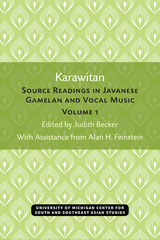 Karawitan: Source Readings in Javanese Gamelan and Vocal Music, Volume 1
Edited by Judith Becker with assistance from Alan H. Feinstein
University of Michigan Press, 1984 The twentieth century has spawned a great interest in Indonesian music, and now books, articles, and manuscripts can be found that expound exclusively about karawitan (the combined vocal and instrumental music of the gamelan). Scholar Judith Becker has culled several key sources on karawitan into three volumes and has translated them for the benefit of the Western student of the gamelan tradition. The texts in her collection were written over a forty-five-year time period (ca 1930–1975) and include articles by Martopangrawit, Sumarsam, Sastrapustaka, Gitosaprodjo, Sindoesawarno, Poerbapangrawit, Probohardjono, Warsadiningrat, Purbodiningrat, Poerbatjaraka, and Paku Buwana X. The final volume also contains a glossary of technical terms, an appendix of the Javanese cipher notations (titilaras kepatihan), a biographical listing, and an index to the musical pieces (Gendhing).
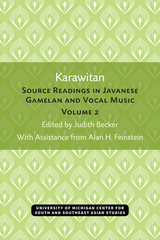 Karawitan: Source Readings in Javanese Gamelan and Vocal Music, Volume 2
Edited by Judith Becker with assistance from Alan H. Feinstein
University of Michigan Press, 1987 The twentieth century has spawned a great interest in Indonesian music, and now books, articles, and manuscripts can be found that expound exclusively about karawitan (the combined vocal and instrumental music of the gamelan). Scholar Judith Becker has culled several key sources on karawitan into three volumes and has translated them for the benefit of the Western student of the gamelan tradition. The texts in her collection were written over a forty-five-year time period (ca 1930–1975) and include articles by Martopangrawit, Sumarsam, Sastrapustaka, Gitosaprodjo, Sindoesawarno, Poerbapangrawit, Probohardjono, Warsadiningrat, Purbodiningrat, Poerbatjaraka, and Paku Buwana X. The final volume also contains a glossary of technical terms, an appendix of the Javanese cipher notations (titilaras kepatihan), a biographical listing, and an index to the musical pieces (Gendhing).
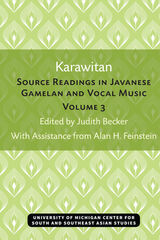 Karawitan: Source Readings in Javanese Gamelan and Vocal Music, Volume 3
Edited by Judith Becker with assistance from Alan H. Feinstein
University of Michigan Press, 1988 The twentieth century has spawned a great interest in Indonesian music, and now books, articles, and manuscripts can be found that expound exclusively about karawitan (the combined vocal and instrumental music of the gamelan). Scholar Judith Becker has culled several key sources on karawitan into three volumes and has translated them for the benefit of the Western student of the gamelan tradition. The texts in her collection were written over a forty-five-year time period (ca 1930–1975) and include articles by Martopangrawit, Sumarsam, Sastrapustaka, Gitosaprodjo, Sindoesawarno, Poerbapangrawit, Probohardjono, Warsadiningrat, Purbodiningrat, Poerbatjaraka, and Paku Buwana X. The final volume also contains a glossary of technical terms, an appendix of the Javanese cipher notations (titilaras kepatihan), a biographical listing, and an index to the musical pieces (Gendhing).
Karim Khan Zand: A History of Iran, 1747-1779
John R. Perry
University of Chicago Press, 1979 A forward thinking and notably popular leader, Karim Khan Zand (1705-1779) was the founder of the Zand dynasty in Iran. In this insightful profile of a man before his time, esteemed academic John Perry shows how by opening up international trade, employing a fair fiscal system and showing respect for existing religious institutions, Karim Khan succeeded in creating a peaceful and prosperous state in a particularly turbulent epoch of history.
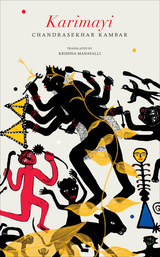 Karimayi
Chandrasekhar Kambar
Seagull Books, 2017 Chandrasekhar Kambar is one of the most accomplished Indian writers working today. In each of Kambar’s novels, the archetypical Mother, Karimayi, is at the center. The narrative of Karimayi moves through an astounding time span, beginning with the mythopoetic times of Goddess Karimayi’s birth and continuing through the historical and cultural shifts in the life of a small rural community called Shivapura during the British colonial era.
Karimayi breaks the familiar narrative of an idyllic and traditional village community being destroyed by the incursion of modernity. Instead, the multilayered narrative of Karimayi weaves everything into itself—the story of the village’s past, the myth of Karimayi, the disorder that sets in with the invasion of colonial modernity and the lure of the city, and, most importantly, of the disruption of another form of “native” modernity that the village community has already begun to incorporate into its rhythms of life. Cleverly challenging colonial cartography, Kambar’s book plays with the idea of an eternal India that exists between myth and reality.
Karl Kautsky, 1854-1938: Marxism in the Classical Years
Gary P. Steenson
University of Pittsburgh Press, 1991 The first major study of Karl Kautsky, considered the most influential Marxian theoretician in the world, from 1895 to 1914. Outside of Friedrich Engels, Kautsky did more to popularize Marism than any other person. An entire generation of Marxists, including Lenin and Trotsky, learned the doctrine in large part from Kautsky.
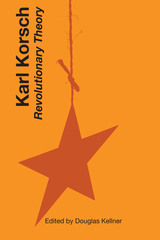 Karl Korsch: Revolutionary Theory
By Karl Korsch
University of Texas Press, 1977 There is growing interest in Europe and the United States in the work of the major German social-political philosopher Karl Korsch. Korsch participated in the turbulent struggles in Weimar Germany and while in exile continually reflected on history and politics. His work affords one of the most important interpretations of the role of Marxism in twentieth-century revolutionary movements, while developing an ongoing critical interrogation of Marxism. His thought provides an illuminating perspective on the process of revolution and counterrevolution in recent history. Karl Korsch: Revolutionary Theory is the first English anthology of his most important writings. This collection presents Korsch's essays on a wide range of subjects, including Marxism and socialization, Lenin and the Soviet Union, the crisis of Marxism, models of revolutionary practice, fascism and counterrevolution, and Korsch's final evaluation of Marxism. Much of this work is translated into English for the first time, and many unknown essays first published in radical journals which are no longer available appear here. The volume includes Korsch's major essays written during the 1920s and 1930s as well as some of his later work. Douglas Kellner's detailed introduction, "Korsch's Revolutionary Marxism," contains the first comprehensive critical interpretation of Korsch's work to appear in English. It provides a historical-theoretical reconstruction of Korsch's life and thought and roots his political theory in the sociopolitical context in which it evolved. The introduction has been described by Korsch scholars as a "first-class piece of exposition and interpretation" and a "serious, first-rate contribution likely to preempt the field in the English language." The editor's introduction along with the representative selection of essays provide firm grounding in the ideas and historical significance of Karl Korsch.
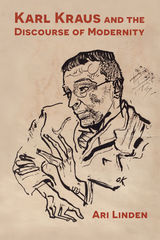 Karl Kraus and the Discourse of Modernity
Ari Linden
Northwestern University Press, 2020 Ari Linden’s Karl Kraus and the Discourse of Modernity reconsiders the literary works of the Viennese satirist, journalist, and playwright Karl Kraus (1874–1936). Combining close readings with intellectual history, Linden shows how Kraus’s two major literary achievements (The Last Days of Mankind and The Third Walpurgis Night) and his adaptation of The Birds by Aristophanes (Cloudcuckooland) address the political catastrophes of the first third of Europe’s twentieth century—from World War I to the rise of fascism.
Kraus’s central insight, Linden argues, is that the medial representations of such events have produced less an informed audience than one increasingly unmoved by mass violence. In the second part of the book, Linden explores this insight as he sees it inflected in the writings of Søren Kierkegaard, Walter Benjamin, and Theodor Adorno. This hidden dialogue, Linden claims, offers us a richer understanding of the often-neglected relationship between satire and critical theory writ large.
 Karl Marx: Greatness and Illusion
Gareth Stedman Jones
Harvard University Press, 2016 As much a portrait of his time as a biography of the man, Karl Marx: Greatness and Illusion returns the author of Das Kapital to his nineteenth-century world, before twentieth-century inventions transformed him into Communism’s patriarch and fierce lawgiver. Gareth Stedman Jones depicts an era dominated by extraordinary challenges and new notions about God, human capacities, empires, and political systems—and, above all, the shape of the future.
In the aftermath of the Battle of Waterloo, a Europe-wide argument began about the industrial transformation of England, the Revolution in France, and the hopes and fears generated by these occurrences. Would the coming age belong to those enthralled by the revolutionary events and ideas that had brought this world into being, or would its inheritors be those who feared and loathed it? Stedman Jones gives weight not only to Marx’s views but to the views of those with whom he contended. He shows that Marx was as buffeted as anyone else living through a period that both confirmed and confounded his interpretations—and that ultimately left him with terrible intimations of failure.
Karl Marx allows the reader to understand Marx’s milieu and development, and makes sense of the devastating impact of new ways of seeing the world conjured up by Kant, Hegel, Feuerbach, Ricardo, Saint-Simon, and others. We come to understand how Marx transformed and adapted their philosophies into ideas that would have—through twists and turns inconceivable to him—an overwhelming impact across the globe in the twentieth century.
 Karl Marx in America
Andrew Hartman
University of Chicago Press, 2025 The vital and untold story of Karl Marx’s stamp on American life.
To read Karl Marx is to contemplate a world created by capitalism. People have long viewed the United States as the quintessential anti-Marxist nation, but Marx’s ideas have inspired a wide range of people to formulate a more precise sense of the stakes of the American project. Historians have highlighted the imprint made on the United States by Enlightenment thinkers such as Adam Smith, John Locke, and Thomas Paine, but Marx is rarely considered alongside these figures. Yet his ideas are the most relevant today because of capitalism’s centrality to American life.
In Karl Marx in America, historian Andrew Hartman argues that even though Karl Marx never visited America, the country has been infused, shaped, and transformed by him. Since the beginning of the Civil War, Marx has been a specter in the American machine. During the Gilded Age, socialists read Marx as an antidote to the unchecked power of corporations. In the Great Depression, communists turned to Marx in hopes of transcending the destructive capitalist economy. The young activists of the 1960s were inspired by Marx as they gathered to protest an overseas war. Marx’s influence today is evident, too, as Americans have become increasingly attuned to issues of inequality, labor, and power.
After decades of being pushed to the far-left corner of intellectual thought, Marx’s ideologies have crossed over into the mainstream and are more alive than ever. Working-class consciousness is on the rise, and, as Marx argued, the future of a capitalist society rests in the hands of the people who work at the point of production. A valuable resource for anyone interested in Marx’s influence on American political discourse, Karl Marx in America is a thought-provoking account of the past, present, and future of his philosophies in American society.
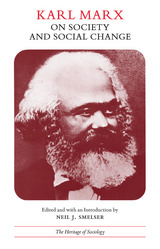 Karl Marx on Society and Social Change: With Selections by Friedrich Engels
Karl Marx
University of Chicago Press, 1975 This volume presents those writings of Marx that best reveal his contribution to sociology, particularly to the theory of society and social change. The editor, Neil J. Smelser, has divided these selections into three topical sections and has also included works by Friedrich Engels.
The first section, "The Structure of Society," contains Marx's writings on the material basis of classes, the basis of the state, and the basis of the family. Among the writings included in this section are Marx's well-known summary from the Preface of A Contribution to a Critique of Political Economy and his equally famous observations on the functional significance of religion in relation to politics.
The second section is titled "The Sweep of Historical Change." The first selection here contains Marx's first statement of the main precapitalist forms of production. The second selection focuses on capitalism, its contradictions, and its impending destruction. Two brief final selections treat the nature of communism, particularly its freedom from the kinds of contradictions that have plagued all earlier forms of societies.
The last section, "The Mechanisms of Change," reproduces several parts of Marx's analysis of the mechanisms by which contradictions develop in capitalism and generate group conflicts. Included is an analysis of competition and its effects on the various classes, a discussion of economic crises and their effects on workers, and Marx's presentation of the historical specifics of the class struggle.
In his comprehensive Introduction to the selections, Professor Smelser provides a biography of Marx, indentifies the various intellectual traditions which formed the background for Marx's writings, and discusses the selections which follow. The editor describes Marx's conception of society as a social system, the differences between functionalism and Marx's theories, and the dynamics of economic and political change as analyzed by Marx.
 Karl Marx on Society and Social Change: With Selections by Friedrich Engels
Karl Marx
University of Chicago Press, 1975 This is an auto-narrated audiobook version of this book.
This volume presents those writings of Marx that best reveal his contribution to sociology, particularly to the theory of society and social change. The editor, Neil J. Smelser, has divided these selections into three topical sections and has also included works by Friedrich Engels.
The first section, "The Structure of Society," contains Marx's writings on the material basis of classes, the basis of the state, and the basis of the family. Among the writings included in this section are Marx's well-known summary from the Preface of A Contribution to a Critique of Political Economy and his equally famous observations on the functional significance of religion in relation to politics.
The second section is titled "The Sweep of Historical Change." The first selection here contains Marx's first statement of the main precapitalist forms of production. The second selection focuses on capitalism, its contradictions, and its impending destruction. Two brief final selections treat the nature of communism, particularly its freedom from the kinds of contradictions that have plagued all earlier forms of societies.
The last section, "The Mechanisms of Change," reproduces several parts of Marx's analysis of the mechanisms by which contradictions develop in capitalism and generate group conflicts. Included is an analysis of competition and its effects on the various classes, a discussion of economic crises and their effects on workers, and Marx's presentation of the historical specifics of the class struggle.
In his comprehensive Introduction to the selections, Professor Smelser provides a biography of Marx, indentifies the various intellectual traditions which formed the background for Marx's writings, and discusses the selections which follow. The editor describes Marx's conception of society as a social system, the differences between functionalism and Marx's theories, and the dynamics of economic and political change as analyzed by Marx.
 Karl Marx’s Interpretation of History: Second Edition
M. M. Bober
Harvard University Press Karl Marx's materialistic conception of history claimed to account for the past, confidently predicted the future, and made history itself. In analyzing the Marxian theory of social evolution, M. M. Bober closely examines the writings of Marx and his friend, Friedrich Engels, tracing the formulation of the doctrine in Capital, The Poverty of Philosophy, Civil War in France, Revolution and Counter-Revolution, The Communist Manifesto, and other of their voluminous publications. By careful, objective investigation, the author is able to present an accurate interpretation of Marx's economic and historical concepts, and he evaluates the theory in the light of actual historical development.
In the extensive revision of his authoritative study, Bober has taken full account of developments since its first publication. Unknown writings by Marx and Engels recently have been discovered; new voices have been raised in defense of and against Marxian concepts; and economic theory has changed, with the problems of the business cycle and economic calculation assuming greater prominence. Bober's critical analysis of Marx and of his influence make a valuable and timely book, of interest not merely to scholars but also to everyone who is stirred to serious reading by the present conflict of political ideologies.
Karl Popper, Science and Enlightenment
Nicholas Maxwell
University College London, 2017 Could science, if properly understood, provide us with the methodological key to the salvation of humanity? That is a chief question coursing through the works of Karl Popper, who famously maintained that science cannot verify theories but only refute them, thereby bringing about progress. Nicholas Maxwell’s new book disputes this line of argument. By proposing a new conception of scientific methodology on disunified theories—which can be applied to all worthwhile human endeavours with problematic aims—this book calls for a new revolution in inquiry to help humanity advance towards a more civilized and enlightened world.
Karl Rahner's Theological Aesthetics
Peter Joseph Fritz
Catholic University of America Press, 2014 This innovative book discloses Karl Rahner's foremost achievement: discovering and delineating an ethos of Catholicism, a multi-faceted and comprehensive approach to life in Christ. Karl Rahner's Theological Aesthetics does so by placing the German Jesuit and his teacher, philosopher Martin Heidegger, into a richly detailed dialogue on aesthetics. The book treats classic Rahner topics such as anthropology and Christology. But it breaks new ground by exploring themes such as angels, Mary, and the apocalypse, juxtaposed with analogous philosophical topics in Heidegger.
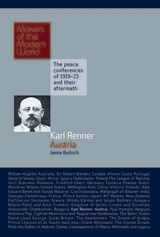 Karl Renner: Austria
Jamie Bulloch
Haus Publishing, 2009 The Socialist politician Karl Renner (1870-1950) was prime minister of the government that took power in Vienna after the collapse of the Austro-Hungarian Empire. He lead the delegation to Paris, which had to face the difficult issue of reparations and war guilt, for which the Allies held the successor states to the Empire responsible for. Fortunately, Renner was a likeable man and a realist, and the Austrian delegation became quite popular in Paris. The new Austrian state was in a perilous condition in 1919, on the brink of starvation and revolution, and facing territorial demands from both Italy, which had its eyes on the Tyrol, and the new Yugoslavia. Many in the German-speaking rump of the Empire sought union with Germany, Anschluss, but the Allied Powers vetoed it. Austria is often overlooked as one of the successor states to the Habsburg Empire, but it was no less important in the postwar settlement than Hungary, Czechoslovakia and the Balkan countries. Jamie Bulloch's account of Karl Renner's adroit handling of a difficult situation makes for fascinating reading.
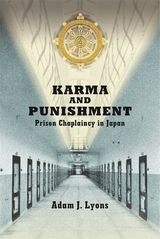 Karma and Punishment: Prison Chaplaincy in Japan
Adam J. Lyons
Harvard University Press Despite being one of the most avowedly secular nations in the world, Japan may have more prison chaplains per inmate than any other country, the majority of whom are Buddhist priests. In this groundbreaking study of prison religion in East Asia, Adam Lyons introduces a form of chaplaincy rooted in the Buddhist concept of doctrinal admonition rather than Euro-American notions of spiritual care.
Based on archival research, fieldwork inside prisons, and interviews with chaplains, Karma and Punishment reveals another dimension of Buddhist modernism that developed as Japan’s religious organizations carved out a niche as defenders of society by fighting crime. Between 1868 and 2020, generations of clergy have been appointed to bring religious instruction to bear on a range of offenders, from illegal Christian heretics to Marxist political dissidents, war criminals, and death row inmates. The case of the prison chaplaincy shows that despite constitutional commitments to freedom of religion and separation of religion from state, statism remains an enduring feature of mainstream Japanese religious life in the contemporary era.
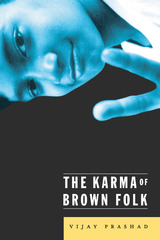 Karma Of Brown Folk
Vijay Prashad
University of Minnesota Press, 2001 Village Voice Favorite Books of 2000
The popular book challenging the idea of a model minority, now in paperback! “How does it feel to be a problem?” asked W. E. B. Du Bois of black Americans in his classic The Souls of Black Folk. A hundred years later, Vijay Prashad asks South Asians “How does it feel to be a solution?” In this kaleidoscopic critique, Prashad looks into the complexities faced by the members of a “model minority”-one, he claims, that is consistently deployed as "a weapon in the war against black America." On a vast canvas, The Karma of Brown Folk attacks the two pillars of the “model minority” image, that South Asians are both inherently successful and pliant, and analyzes the ways in which U.S. immigration policy and American Orientalism have perpetuated these stereotypes. Prashad uses irony, humor, razor-sharp criticism, personal reflections, and historical research to challenge the arguments made by Dinesh D’Souza, who heralds South Asian success in the U.S., and to question the quiet accommodation to racism made by many South Asians. A look at Deepak Chopra and others whom Prashad terms “Godmen” shows us how some South Asians exploit the stereotype of inherent spirituality, much to the chagrin of other South Asians. Following the long engagement of American culture with South Asia, Prashad traces India’s effect on thinkers like Cotton Mather and Henry David Thoreau, Ravi Shankar’s influence on John Coltrane, and such essential issues as race versus caste and the connection between antiracism activism and anticolonial resistance. The Karma of Brown Folk locates the birth of the “model minority” myth, placing it firmly in the context of reaction to the struggle for Black Liberation. Prashad reclaims the long history of black and South Asian solidarity, discussing joint struggles in the U.S., the Caribbean, South Africa, and elsewhere, and exposes how these powerful moments of alliance faded from historical memory and were replaced by Indian support for antiblack racism. Ultimately, Prashad writes not just about South Asians in America but about America itself, in the tradition of Tocqueville, Du Bois, Richard Wright, and others. He explores the place of collective struggle and multiracial alliances in the transformation of self and community-in short, how Americans define themselves.
Karol Wojtyla's Personalist Philosophy
Miguel Acosta
Catholic University of America Press, 2016 This work provides a clear guide to Karol Wojtyla's principal philosophical work, Person and Act, rigorously analyzing the meaning that the author intended in his exposition. An important feature of the work is that the authors rely on the original Polish text, Osoba i czyn, as well as the best translations into Italian and Spanish, rather than on a flawed and sometimes misleading English edition of the work.
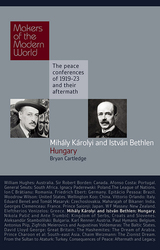 Karolyi & Bethlen: Hungary
Bryan Cartledge
Haus Publishing, 2009 White aster flowers, on sale on the streets of Budapest on the eve of All Souls' Day, are made the symbol of a revolution which brings Mihály Károlyi (1875-1955) to power at the head of a National Council. Károlyi concludes an armistice which leaves large areas of Hungarian territory under occupation by French, Romanian and Serbian forces. Following the King-Emperor's abdication in November 1918, Hungary is declared an independent republic with Károlyi as its President. He sets about meeting Hungary's most pressing social need, for land reform. But Károlyi's liberal regime is soon beset by strong opposition from the right and from the left. The Allies seal Károlyi's fate by refusing to end the economic blockade of Hungary and by imposing, even in advance of a peace settlement (Hungary is denied an invitation until the Conference is virtually over), even harsher armistice terms. Károlyi flinches from opposing these measures by force. The small socialist element in his government of well-meaning aristocrats defects and forms an alliance with Hungary's fledgling Communist Party. Károlyi resigns and chooses exile. The Communists, led by Bela Kun, take power. Kun raises a Red Army, which defeats a Czech invasion but fails to stem the Romanian advance, which enters Budapest in defiance of orders from Paris and engages in an orgy of pillage and destruction. The Peace Conference despatches a British diplomat, Sir George Clerk, to Budapest to broker a Romanian withdrawal. Clerk succeeds in forming a coalition government of right-wing parties, with token representation for the centre-left, which he recognises in the name of the Peace Conference and invites to send a delegation to Paris. It includes Counts István Bethlen (1874-1946) and Pál Teleki, both future prime ministers. The delegation is presented on arrival, on 6 January 1920, with the draft peace treaty for Hungary which the expert committees of the Conference have produced and which the Council has approved without amendment. The Hungarians are appalled to find that the treaty will deprive their country of two-thirds of her territory and over half of her population. The injustice of the Treaty will drive Hungary into the arms of Nazi Germany, a fatal alliance which will doom Hungary's Jews to annihilation and Hungary to defeat and destruction in the Second World War.
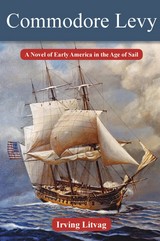 Karski: How One Man Tried to Stop the Holocaust
E. Thomas Wood
Texas Tech University Press Revised and updated, with previously unpublished material, and a new Introduction and Afterword
A young Polish diplomat turned cavalry officer, Jan Karski joined the Polish Underground movement in 1939. He became a courier for the Underground, crossing enemy lines to serve as a liaison between occupied Poland and the free world.
In 1942, Jewish leaders asked him to carry a desperate message to Allied leaders: the news of Hitler's effort to exterminate the Jews of Europe. To be able to deliver an authentic report, Karski twice toured the Warsaw Ghetto in disguise and later volunteered to be smuggled into a camp that was part of the Nazi murder machine.
Carrying searing tales of inhumanity, Karski set out to alert the world to the emerging Holocaust, meeting with top Allied officials and later President Roosevelt, to deliver his descriptions of genocide.
Part spy thriller and part compelling story of moral courage against all odds, Karski is the first definitive account of perhaps the most significant warning of the impending Holocaust to reach the free world.
Co-published with Gihon River Press
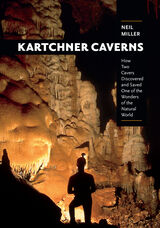 Kartchner Caverns: How Two Cavers Discovered and Saved One of the Wonders of the Natural World
Neil Miller
University of Arizona Press, 2008 It was all routine even if hundreds of pounds of earth were pressing down on their heads, even though the ceiling might potentially collapse at any moment, even if they were surrounded by a sea of darkness and had no idea what lay in front of them.
Award-winning author Neil Miller soon tells us that what lay in front of amateur spelunkers Randy Tufts and Gary Tenen was anything but routine. These young men had crawled into a virgin cave, a landscape untouched and unseen for hundreds of thousands of years. In cave terminology, this underground oasis was “living”—water still seeped down the limestone walls, depositing minerals that slowly built up into stunningly beautiful formations.
In a time when countless caves had been destroyed by vandals and looters who had defaced the walls and had broken formations, this pristine discovery was every caver’s dream. While duplicating that moment might seem difficult, this fascinating account of the fight to preserve Kartchner Caverns lends us the same sense of awe and urgency. In an arresting tale spanning the twenty-five-year period in which Tufts and Tenen struggled to protect their find, Miller skillfully weaves together personal interviews, biographical information, political maneuvering, and geological facts. Presented in full color with dazzling photographs showcasing the natural wonder of the caverns, this is an invitation to take in the mysterious, stunning beauty of a cave as if discovering it for the first time.
The triumph of the conservationists and the opening of Kartchner Caverns as a state park are known to anyone who has visited the caves as a tourist. But this narrative offers a chance to go beyond the guidebooks with its revealing look at this unspoiled natural wonder and the science of cave conservation. With as much depth and colorful detail as the caverns themselves, this page-turning account will captivate anyone interested in caves and the preservation of natural wonders.
KARTOON KINGS: THE GRAPHIC WORK OF SIMON GRENNEN AND CHRISTOPHER SPERANDIO
Paul Krainak
West Virginia University Press, 2007 Kartoon Kings is the first monographic and comprehensive analysis of the graphic artwork of Simon Grennan and Christopher Sperandio. This work showcases a collection of full-color images excerpted from comic book projects, videos, billboards, and more of the artists’ collaborative public contributions created over the past fifteen years. To supplement the images an interview with the artists by Kristina Olson is included, along with essays by Joshua Decter and Paul Krainak. Grennan and Sperandio work together by conspiring about their creative ideas on the Internet. Their teamwork must be done this way because Grennan lives in England, while Sperandio lives in the United States. More of Sperandio and Grennan’s work can be seen at www.kartoonkings.com.
Kashmir as a Borderland: The Politics of Space and Belonging across the Line of Control
Antía Mato Bouzas
Amsterdam University Press, 2019 Kashmir as a Borderland: The Politics of Space and Belonging across the Line of Control examines the Kashmir dispute from both sides of the Line of Control (LoC) and within the theoretical frame of border studies. It draws on the experiences of those living in these territories such as divided families, traders, cultural and social activists. Kashmir is a borderland, that is, a context for spatial transformations, where the resulting interactions can be read as a process of ‘becoming’ rather than of ‘being’. The analysis of this borderland shows how the conflict is manifested in territory, in specific locations with a geopolitical meaning, evidencing the discrepancy between ‘representation’ and the ‘living’. The author puts forward the concept of belonging as a useful category for investigating more inclusive political spaces.
 Kashmir: Roots of Conflict, Paths to Peace
Sumantra Bose
Harvard University Press, 2005 In 2002, nuclear-armed adversaries India and Pakistan mobilized for war over the long-disputed territory of Kashmir, sparking panic around the world. Drawing on extensive firsthand experience in the contested region, Sumantra Bose reveals how the conflict became a grave threat to South Asia and the world and suggests feasible steps toward peace.
Though the roots of conflict lie in the end of empire and the partition of the subcontinent in 1947, the contemporary problem owes more to subsequent developments, particularly the severe authoritarianism of Indian rule. Deadly dimensions have been added since 1990 with the rise of a Kashmiri independence movement and guerrilla war waged by Islamist groups. Bose explains the intricate mix of regional, ethnic, linguistic, religious, and caste communities that populate Kashmir, and emphasizes that a viable framework for peace must take into account the sovereignty concerns of India and Pakistan and popular aspirations to self-rule as well as conflicting loyalties within Kashmir. He calls for the establishment of inclusive, representative political structures in Indian Kashmir, and cross-border links between Indian and Pakistani Kashmir. Bose also invokes compelling comparisons to other cases, particularly the peace-building framework in Northern Ireland, which offers important lessons for a settlement in Kashmir.
The Western world has not fully appreciated the desperate tragedy of Kashmir: between 1989 and 2003 violence claimed up to 80,000 lives. Informative, balanced, and accessible, Kashmir is vital reading for anyone wishing to understand one of the world's most dangerous conflicts.
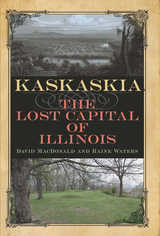 Kaskaskia: The Lost Capital of Illinois
David MacDonald and Raine Waters
Southern Illinois University Press, 2019 This first comprehensive account of the Illinois village of Kaskaskia covers more than two hundred years in the vast and compelling history of the state. David MacDonald and Raine Waters explore Illinois’s first capital in great detail, from its foundation in 1703 to its destruction by the Mississippi River in the latter part of the nineteenth century, as well as everything in between: successes, setbacks, and the lives of the people who inhabited the space.
At the outset the Kaskaskia tribe, along with Jesuit missionaries and French traders, settled near the confluence of the Kaskaskia and Mississippi rivers, about sixty miles south of modern-day St. Louis. The town quickly became the largest French town and most prosperous settlement in the Illinois Country. After French control ended, Kaskaskia suffered under corrupt British and then inept American rule. In the 1790s the town revived and became the territorial capital, and in 1818 it became the first state capital. Along the way Kaskaskia was beset by disasters: crop failures, earthquakes, tornadoes, floods, epidemics, and the loss of the capital-city title to Vandalia. Likewise, human activity and industry eroded the river’s banks, causing the river to change course and eventually wash away the settlement. All that remains of the state’s first capital today is a village several miles from the original site.
MacDonald and Waters focus on the town’s growth, struggles, prosperity, decline, and obliteration, providing an overview of its domestic architecture to reveal how its residents lived. Debunking the notion of a folklore tradition about a curse on the town, the authors instead trace those stories to late nineteenth-century journalistic inventions. The result is a vibrant, heavily illustrated, and highly readable history of Kaskaskia that sheds light on the entire early history of Illinois.
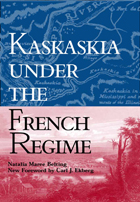 Kaskaskia Under the French Regime
Natalia Maree Belting. Foreword by Carl J. Ekberg
Southern Illinois University Press, 2003 “The Illinois Habitant,” writes Natalia Maree Belting, “was a gay soul; he seemed shockingly carefree to later, self-righteous puritans from the American colonies. He danced on Sunday after mass, was passionately attached to faro and half a dozen other card games, and played billiards at all hours. He gossiped long over a friendly pipe and congenial mug of brandy in the half-dusk of his porch or in the noisy tavern.” First published in 1948, Kaskaskia under the French Regime is a social and economic history of French Kaskaskia from 1703 to 1765. Using a readable, journalistic style, Belting brings to life the prairie terrain, the Kaskaskia mission, early architecture, building methods and materials, the beginnings of government, domestic tools and utensils, commerce, and the social customs of the pioneer. In 1703, Kaskaskia was little more than a mission station in Illinois territory inhabited by a few French traders, their Indian wives, and a priest. Later in the century, the settlement became a flourishing French village filled with rows of low one-story French-style houses lining the streets. But the unique native and French bonds began when the explorers Louis Joliet and Pierre Marquette discovered a peaceful tribe, the Kaskaskia, while journeying along the Illinois River. This historic friendship grew into a unique colonial culture, the remnants which can be seen through numerous primary source documents. Belting draws on and translates from eighteenth century French the Kaskaskia Manuscripts, in which French notaries recorded parish marriage contracts, property transactions (including slave sales), and estate inventories. She also examines the papers of the Marquis de Vaudreuil, among them the most complete census ever conducted in French Illinois, which provides a household-by-household enumeration of the population. What results is a comprehensive depiction of the lives and livelihood of French settlers in colonial Illinois.
Katha Aranyaka: Critical Edition with a Translation into German and an Introduction
Michael Witzel
Harvard University Press Dating to the first half of the first millennium BCE, the Katha Aranyaka is a ritualistic and speculative text that deals with a dangerous Vedic ritual that provides its sponsor with a new body after death. In a new, never-before-published critical edition, Michael Witzel, using available manuscripts and, primarily, a color facsimile of a restored five-hundred-year-old Kashmiri birch bark manuscript preserved at Tübingen since 1895, presents this work which transitions the Vedic ritual into the philosophy of the Upanishads. The text is preceded by an extensive introduction in English dealing with Vedic ritualism and followed by a German translation as well as detailed variant readings and a verse index.
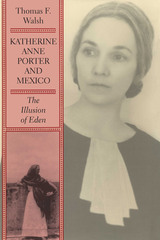 Katherine Anne Porter and Mexico: The Illusion of Eden
By Thomas F. Walsh
University of Texas Press, 1992 In 1920, an unknown journalist named Katherine Anne Porter first sojourned in Mexico. When she left her "familiar country" for the last time in 1931, she was the celebrated author of Flowering Judas and Other Stories and had accumulated a wealth of experiences and impressions that would inspire numerous short stories, essays, and reviews, as well as the opening section of her only novel, Ship of Fools. In this perceptive study of Porter's Mexican experiences, Thomas Walsh traces the important connections between those events and her literary works. Separating fact from the fictions that Porter constantly created about her life, he follows the active role that she played in Mexican political and intellectual life—even to the discovery of a plot to overthrow the Mexican government, which eventually figured in Flowering Judas. Most important, Walsh discerns how the great swings between depression and elation that characterized Porter's emotional life influenced her alternating visions of Mexico. In such works as "Xochimilco," Porter saw Mexico as an earthly Eden where hopes for a better society could be realized, but in other stories, including "The Fiesta of Guadalupe," she depicts Mexico as a place of hopeless oppression for the native peoples. Mexico, Porter once said, gave her back her Texas past. Given the unhappiness of that past, her feelings toward Mexico would always be ambivalent, but her Mexican experiences influenced all her subsequent works to some degree, even those pieces not specifically Mexican in setting. Walsh's study, then, is an essential key for anyone seeking greater understanding of the life or works of Katherine Anne Porter.
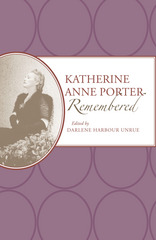 Katherine Anne Porter Remembered
Darlene Harbour Unrue
University of Alabama Press, 2010 Katherine Anne Porter Remembered is a collection of reminiscences and memoirs by contemporaries, friends, and associates of Porter offering a revealing and intimate portrait of the elusive and complex American writer. From a fractured and vagabond girlhood in Texas, Porter led a wildly itinerant life that took her through five marriages, innumerable love affairs, and homes in Colorado, New York, Paris, Mexico, Louisiana, California, and Maryland. With very little formal education, she grew through sheer force of will to become a major American writer of short stories and the author of several books including Flowering Judas and other stories; Ship of Fools; Pale Horse; Pale Ride; Noon Wine; and The Collected Stories of Katherine Anne Porter, which won both the Pulitzer Prize and the National Book Award. Because of Porter’s own dissembling and half-truths about her life, as well as the numerous factual errors that persist in biographical entries and literary dictionaries, a complete and accurate portrait of her life has been hard to establish. The 63 reminiscences gathered in this book paint a vivid portrait of Porter and are testaments to her extraordinary beauty, her gift for mesmerizing and charming audiences and friends, her yearnings for a lasting home, her delusions about love, the astonishing range and scope of her reading, her sharp tongue and vindictiveness, and her final paranoid renunciations of friends and family. Along the way, Porter formed friendships with Eudora Welty, Elizabeth Hardwick, Flannery O’Connor, and CleanthBrooks whose remembrances of her are included in this volume.
 Katherine Dunham: DANCING A LIFE
Joyce Aschenbrenner
University of Illinois Press, 2002 Throughout the better part of the twentieth century, and in performance halls, classrooms, and communities throughout the world, the wellspring of Katherine Dunham's remarkable career can be traced to the intersection of dance, culture, and society. More than a recounting of Dunham's accomplishments as a dancer and choreographer, this biography is the first to thoroughly examine her pioneering contributions to dance anthropology and her commitment to humanizing society through the arts.
Founder of the first self-supporting African American dance company, Dunham relied on her fieldwork as an anthropologist to fundamentally change modern dance. She shaped new dance techniques and introduced other cultures to U.S. and European audiences by fusing Caribbean and African-based movement with ballet and modern dance. Her revolutionary approaches to dance and its greater connection to the world have influenced a generation of dancers, theatrical performers, and scholars. She believes that dance involves the development of an entire person and the rituals and traditions of dance are integral to the study of culture. Throughout her career she has been a living model of the socially responsible artist working to whet cultural appetites and combat social injustice.
Joyce Aschenbrenner's multifaceted portrait blends personal observations based on her own interactions with Dunham, archival documents, and interviews with Dunham's colleagues, students, and members of the Katherine Dunham Dance Company.
Integrating these sources, Aschenbrenner characterizes the social, familial, and cultural environment of Dunham's upbringing and the intellectual and artistic community she embraced at the University of Chicago that laid the groundwork for her development as a dancer, anthropologist, and humanitarian. The book vividly depicts Dunham's and her dancers' touring experiences and includes detailed descriptions of her community cultural and educational programs in East St. Louis.
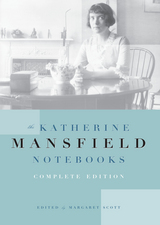 Katherine Mansfield Notebooks: Complete Edition
Katherine Mansfield
University of Minnesota Press, 2002 The only unexpurgated collection of Katherine Mansfield’s private writings-now available for the first time! Edited by Margaret Scott Katherine Mansfield (1888-1923) published three collections of short stories-In a German Pension, Bliss, and The Garden Party-during her tragically short life, and was acclaimed as one of modernism’s most daring and original writers. After her death from tuberculosis in France, Mansfield’s private writings and letters were edited by her husband, John Middleton Murry, and published in four volumes between 1927 and 1954. Murry, however, took liberties in recasting his wife’s journals and notes. He excluded most of the vast mass of material and revised much of what he included, resulting in a distorted image of Mansfield as a passive, ethereal spirit.More than four decades later, the real Mansfield finally emerges in The Katherine Mansfield Notebooks, the first unexpurgated edition of her private writings. Fully and accurately transcribed by editor Margaret Scott, these infrequent diary entries, drafts of letters, introspective notes jotted on scraps of paper, unfinished stories, half-plotted novels, poems, recipes, and shopping lists offer a complete and compelling portrait of a complex woman who was ambitious and at times ruthless, neurotic and sexually voracious, witty and acerbic, fascinated with the minutiae of daily life and obsessed with death."It is only now, with the publication of Margaret Scott’s complete and unselective transcription of the material bequeathed to Murry, that we can really see Mansfield, off her guard and unexpurgated, for the first time. . . . Mansfield's notebooks are remarkable, touched by a sense of the underlying pathos of things, two parts tragedy and two parts comedy." Times Literary Supplement (London)"Mansfield’s work speaks about what is irretrievably lost, material, mortal, unless it is turned to artifice-and nowhere more than in these notebooks, where she is so reluctantly introspective." London Review of Books
Katherine Mansfield's Fiction
Patrick D. Morrow
University of Wisconsin Press, 1993 This book attempts to analyze a major part of Mansfield's fiction, concentrating on an analysis of the various textures, themes, and issues, plus the point of view virtuosity that she accomplished in her short lifetime (34 years). Many of her most famous works, such as "Prelude" and "Bliss," are explicated, along with many of her less famous and unfinished stories.
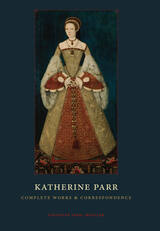 Katherine Parr: Complete Works and Correspondence
Katherine Parr
University of Chicago Press, 2011 To the extent that she is popularly known, Katherine Parr (1512–48) is the woman who survived King Henry VIII as his sixth and last wife. She merits far greater recognition, however, on several other fronts. Fluent in French, Italian, and Latin, Parr also began, out of necessity, to learn Spanish when she ascended to the throne in 1543. As Henry’s wife and queen of England, she was a noted patron of the arts and music and took a personal interest in the education of her stepchildren, Princesses Mary and Elizabeth and Prince Edward. Above all, Parr commands interest for her literary labors: she was the first woman to publish under her own name in English in England. For this new edition, Janel Mueller has assembled the four publications attributed to Parr—Psalms or Prayers, Prayers or Meditations, The Lamentation of a Sinner, and a compilation of prayers and Biblical excerpts written in her hand—as well as her extensive correspondence, which is collected here for the first time. Mueller brings to this volume a wealth of knowledge of sixteenth-century English culture. She marshals the impeccable skills of a textual scholar in rendering Parr’s sixteenth-century English for modern readers and provides useful background on the circumstances of and references in Parr’s letters and compositions. Given its scope and ambition, Katherine Parr: Complete Works and Correspondence will be an event for the English publishing world and will make an immediate contribution to the fields of sixteenth-century literature, reformation studies, women’s writing, and Tudor politics.
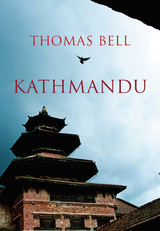 Kathmandu
Thomas Bell
Haus Publishing, 2016 One of the greatest cities of the Himalaya, Kathmandu, Nepal, is a unique blend of thousand-year-old cultural practices and accelerated urban development. In this book, Thomas Bell recounts his experiences from his many years in the city—exploring in the process the rich history of Kathmandu and its many instances of self-reinvention.
Closed to the outside world until 1951 and trapped in a medieval time warp, Kathmandu is, as Bell argues, a jewel of the art world, a carnival of sexual license, a hotbed of communist revolution, a paradigm of failed democracy, a case study in bungled western intervention, and an environmental catastrophe. The layered development of the city can be seen in the successive generations of its gods and goddesses; its comfort in the caste system and ethos of aristocracy and kingship; and the recent destabilizing effects of consumerist approaches and the push for egalitarianism and democracy. In important ways, Kathmandu’s rapid modernization can be seen as an extreme version of what is happening in other traditional societies. Bell also discusses the ramifications of the recent Nepal earthquake.
A comprehensive look at a top global destination, Kathmandu is an entertaining and accessible chronicle for anyone eager to learn more about this fascinating city.
 Katrina: A History, 1915–2015
Andy Horowitz
Harvard University Press, 2020 Winner of the Bancroft Prize
Louisiana Endowment for the Humanities Book of the Year
A Publishers Weekly Book of the Year
“The main thrust of Horowitz’s account is to make us understand Katrina—the civic calamity, not the storm itself—as a consequence of decades of bad decisions by humans, not an unanticipated caprice of nature.”
—Nicholas Lemann, New Yorker
Hurricane Katrina made landfall in New Orleans on August 29, 2005, but the decisions that caused the disaster can be traced back nearly a century. After the city weathered a major hurricane in 1915, its Sewerage and Water Board believed that developers could safely build housing near the Mississippi, on lowlands that relied on significant government subsidies to stay dry. When the flawed levee system failed, these were the neighborhoods that were devastated.
The flood line tells one important story about Katrina, but it is not the only story that matters. Andy Horowitz investigates the response to the flood, when policymakers made it easier for white New Orleanians to return home than for African Americans. He explores how the profits and liabilities created by Louisiana’s oil industry have been distributed unevenly, prompting dreams of abundance and a catastrophic land loss crisis that continues today.
“Masterful…Disasters have the power to reveal who we are, what we value, what we’re willing—and unwilling—to protect.”
—New York Review of Books
“If you want to read only one book to better understand why people in positions of power in government and industry do so little to address climate change, even with wildfires burning and ice caps melting and extinctions becoming a daily occurrence, this is the one.”
—Los Angeles Review of Books
 Katrina on Stage: Five Plays
Suzanne M. Trauth
Northwestern University Press, 2011 The plays collected in this volume give artistic expression to the devastation wrought by Hurricane Katrina. In so doing, they also illuminate many social, political, and environmental issues central to American life. Besides telling the kinds of stories that the news media could not, these plays explore the deeply rooted problems plaguing New Orleans. The factual basis of these plays serves a documentary purpose, but, as drama, they also depict the flood's consequences for individuals—unimaginable loss, powerlessness, displacement. The plays collected here - Rising Water by John Biguenet; The Breach by Catherine Filloux, Tarell Alvin McCraney, and Joe Sutton; Because They Have No Words by Tim Maddock and Lotti Louise Pharrissis; Trash Bag Tourist by Samuel Brett Williams; and Katrina: The K Word by Lisa Brenner and Suzanne Trauth—show how theatre can both enhance our understanding of disastrous events and facilitate a sense of community between audiences and those who experienced them.
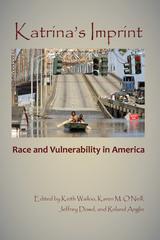 Katrina's Imprint: Race and Vulnerability in America
Wailoo, Keith
Rutgers University Press, 2010 Katrina's Imprint highlights the power of this sentinel American event and its continuing reverberations in contemporary politics, culture, and public policy. Published on the fifth anniversary of Hurricane Katrina, the multidisciplinary volume reflects on how history, location, access to transportation, health care, and social position feed resilience, recovery, and prospects for the future of New Orleans and the Gulf region. Essays examine the intersecting vulnerabilities that gave rise to the disaster, explore the cultural and psychic legacies of the storm, reveal how the process of rebuilding and starting over replicates past vulnerabilities, and analyze Katrina's imprint alongside American's myths of self-sufficiency. A case study of new weaknesses that have emerged in our era, this book offers an argument for why we cannot wait for the next disaster before we apply the lessons that should be learned from Katrina.
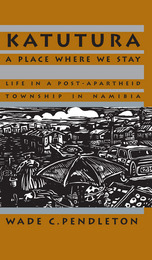 Katutura: A Place Where We Stay: Life in a Post-Apartheid Township in Namibia
Wade C. Pendleton
Ohio University Press, 1995 Katutura, located in Namibia’s major urban center and capital, Windhoek, was a township created by apartheid, and administered in the past by the most rigid machinery of the apartheid era. Namibia became a sovereign state in 1990, and Katutura reflects many of the changes that have taken place. No longer part of a rigidly bounded social system, people in Katutura today have the opportunity to enter and leave as their personal circumstances dictate. Influenced in recent years by significant urban migration and the changing political and economic situation in the new South Africa, as well as a myriad of other factors, this diverse community has held special interest for the author who did fieldwork there for several years prior to 1975. Pendleton’s recent visits provide a rich comparison of life in Katutura township during the peak of the apartheid years and in the post-independence period. In his systematic look at urbanization, poverty, stratification, ethnicity, social structure, and social history, he provides a compassionate view of the survivors of the unstable years of apartheid.
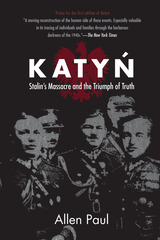 Katyn: Stalin’s Massacre and the Triumph of Truth
Allen Paul
Northern Illinois University Press, 2010
Twenty years ago, Allen Paul wrote the first post-communist account of one of the greatest but least-known tragedies of the 20th century: Stalin’s annihilation of Poland’s officer corps and massive deportation of so-called “bourgeoisie elements” to Siberia. Today, these brutal events are symbolized by one word, Katyn—a crime that still bitterly divides Poles and Russians. Paul’s richly updated account covers Russian attempts to recant their admission of guilt for the murders in Katyn Forest and includes recently translated documents from Russian military archives, eyewitness accounts of two perpetrators, and secret official minutes published here for the first time that confirm that U.S. government cover-up of the crime continued long after the war ended.
Paul’s masterful narrative recreates what daily life was like for three Polish families amid momentous events of World War II—from the treacherous Nazi-Soviet invasion in 1939 to a rigged election in 1947 that sealed Poland’s doom. The patriarch of each family was among the Polish officers personally ordered by Stalin to be shot. One of the families suffered daily repression under the German General Government. Like thousands of other Poles, two of the families were deported to Siberia, where they nearly died from forced labor, starvation, and neglect. Through painstaking research, the author reconstructs the lives of these families including such stories as a miraculous escape on the last transport of Poles leaving Russia and a mother’s daring ski trek over the Carpathian Mountains to rescue a daughter she had not seen in six years. At the heart of the drama is the Poles’ uncommon belief in “victory in defeat”—that their struggles made them strong and that freedom and independence, inevitably, would be regained.
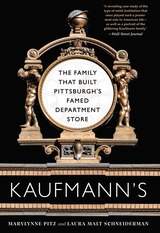 Kaufmann's: The Family That Built Pittsburgh's Famed Department Store
Marylynne Pitz and Laura Malt Schneiderman
University of Pittsburgh Press, 2022 In 1868, Jacob Kaufmann, the nineteen-year-old son of a German farmer, stepped off a ship onto the shores of New York. His brother Isaac soon followed, and together they joined an immigrant community of German Jews selling sewing items to the coal miners and mill workers of western Pennsylvania. After opening merchant tailor shops in Pittsburgh’s North and South sides, the Kaufmann brothers caught the wave of a new type of merchandising—the department store—and launched what would become their retail dynasty with a downtown storefront at Fifth Avenue and Smithfield Street. In just two decades, Jacob and his brothers had ascended Pittsburgh’s economic and social ladder, rising from hardscrabble salesmen into Gilded Age multimillionaires.
Generous and powerful philanthropists, the Kaufmanns left an indelible mark on the city and western Pennsylvania. From Edgar and Liliane’s famous residence, the Frank Lloyd Wright masterpiece called Fallingwater, to the Kaufmann clock, a historic landmark that inspired the expression “meet me under the clock,” to countless fond memories for residents and shoppers, the Kaufmann family made important contributions to art, architecture, and culture. Far less known are the personal tragedies and fateful ambitions that forever shaped this family, their business, and the place they called home. Kaufmann’s recounts the story of one of Pittsburgh’s most beloved department stores, pulling back the curtain to reveal the hardships, triumphs, and complicated legacy of the prominent family behind its success.
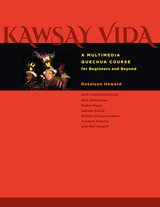 Kawsay Vida: A Multimedia Quechua Course for Beginners and Beyond
By Rosaleen Howard
University of Texas Press, 2014 Kawsay Vida is a course book and interactive multimedia program for the teaching and learning of the Quechua language from beginner to advanced levels. The course book is based on contemporary Bolivian Quechua, while the multimedia program contains a section on Bolivian Quechua (beginner to intermediate levels) and a section on southern Peruvian Quechua (advanced level). The book provides a practical introduction to spoken Quechua through the medium of English, while the multimedia program offers a choice of English or Spanish as the medium of instruction. The video clips introduce us to Quechua speakers in the valleys of Northern Potosí (Bolivia) and Cuzco (Peru), giving a sense of immediacy that the printed page cannot achieve, and highlighting the social and cultural settings in which the language is spoken. The multimedia program is available for both PC and Macintosh platforms.
The book contains twenty-two units of study. As students work through these, cross-references take them to relevant sections of the multimedia program. The Bolivian and Peruvian Quechua sections of the multimedia program are divided into thematically and grammatically ordered modules, which introduce users to different aspects of Andean life, while progressing language learning in a structured way. Users engage with the audio, video, and visual material contained in the program through a range of interactive exercises, which reinforce listening and comprehension skills. Once familiarity with the language is acquired, the multimedia program may be used independently from the book.
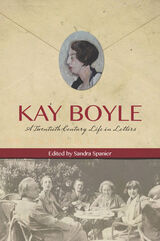 Kay Boyle: A Twentieth-Century Life in Letters
Edited and with an Introduction by Sandra Spanier
University of Illinois Press, 2015 One of the Lost Generation modernists who gathered in 1920s Paris, Kay Boyle published more than forty books, including fifteen novels, eleven collections of short fiction, eight volumes of poetry, three children's books, and various essays and translations. Yet her achievement can be even better appreciated through her letters to the literary and cultural titans of her time.
<p>Kay Boyle shared the first issue of <i>This Quarter</i> with Gertrude Stein and Ernest Hemingway, expressed her struggles with poetry to William Carlos Williams and voiced warm admiration to Katherine Anne Porter, fled WWII France with Max Ernst and Peggy Guggenheim, socialized with the likes of James Joyce, Marcel Duchamp, and Samuel Beckett, and went to jail with Joan Baez. The letters in this first-of-its-kind collection, authorized by Boyle herself, bear witness to a transformative era illuminated by genius and darkened by Nazism and the Red Scare. Yet they also serve as milestones on the journey of a woman who possessed a gift for intense and enduring friendship, a passion for social justice, and an artistic brilliance that earned her inclusion among the celebrated figures in her ever-expanding orbit.
Kayak Girl
Monica Devine
University of Alaska Press, 2012 In Kayak Girl a young child learns to cope with serious loss by focusing on something larger than herself. After Jana’s mother dies, she becomes withdrawn. Her grandfather, a carver, pays the girl a visit and finds her unresponsive to his care. He carves a figure of a girl in a kayak and asks Jana to promise that she will watch for the figure after he releases it upriver. Through the following seasons, Jana goes to the river daily and finds strength in the positive memories from her short time with her mother, even as she imagines the distant kayak girl’s struggles. Eventually, they are reunited, and Jana’s spirit is revived. Throughout the book, watercolor illustrations take readers to a magical place along an Alaska river and demonstrate the power of memory and a sense of place in the natural world.
Kazakhstan's New Economy: Post-Soviet, Central Asian Industries in a Global Era
Jay Nathan
University of Scranton Press, 2013 Kazakhstan has faced severe economic challenges since it gained independence from the former Soviet Union in 1991. Kazakhstan’s New Economy explores how the country might shed the outdated business practices that continue to hamper its growth. Jay Nathan first provides a historical overview of the economy and then delves deeper into the strengths and weaknesses of nine major industries, including oil and gas, banking, telecommunications, and transportation. Nathan’s careful analysis and recommendations will provide valuable insight for anyone interested in Central Asia’s economic growth.
“An excellent resource on major industries in Kazakhstan.”—Byrganym Aitimova, Minister of Education and Science, the Republic of Kazakhstan
 Kazimir Malevich: The Climax of Disclosure
Rainer Crone and David Moos
University of Chicago Press, 1991 Kasimir Malevich's (1878-1935) sudden and startling realization of a nonrepresentational way of painting, which he called Suprematism, stands as a seminal moment in twentieth-century art. Rainer Crone and David Moos trace the artist's development from his beginnings in the Ukraine to his involvement with Futurist circles in Moscow through to the late 1920s and beyond. They convincingly demonstrate that Malevich's late representational painting, still widely misunderstood, solidifies his extraordinarily inventive stance.
Against the historical background of distinctly Russian progressive cultural and scientific movements, the authors define affinities between Malevich's work and other nonpolitical revolutions: relativity and quantum theory in physics; the work of Roman Jakobson and the "Prague School" in linguistics; and the exploration of language in the writings of the poet Velimir Khlebnikov. They situate the artist within the fundamental epistemological shift from nineteenth-century objectivity to an all-pervasive modernist subjectivity, relying upon Malevich's contribution to illustrate the ways cultural production is mediated through various modes of transmission.
 Kazimira
Svenja Leiber
Seagull Books, 2024 A gripping and emotionally resonant saga that traces the lives of five generations of resilient women from the late nineteenth century to the dawn of the twenty-first.
Towards the end of the nineteenth century in East Prussia, a woman named Kazimira strolls the remote shores of the Baltic Sea, bringing home bits of amber that wash up on the beach. Her husband Antas is the region’s best carver, and he catches the attention of Moritz Hirschberg, owner of a nearby amber factory. Antas rises through the ranks, but Kazimira has the best ideas for processing and cutting the stones. Although establishing a new mine on such shifting terrain is hazardous, the venture finally pays off. It brings success, but envy and resentment swiftly follow, as antisemitism and nationalism sweep across the German Empire. Kazimira soon learns she must go her own way, as the Hirshbergs are expelled and World War I shatters her son. Three decades later, at the end of World War II, she becomes the last witness of German war crimes committed on West Beach, formerly a place of prosperity and progress.
At the dawn of the twenty-first century in Russia, a woman named Nadia operates an excavator in a massive open-pit amber mine until she is told to go sell trinkets alongside all the other shopgirls. In alternating passages weaving together vastly different eras across the span of a century and a half, Svenja Leiber’s Kazimira tells the story of the largest amber-mining operation in history, and its lasting effects expose pressing questions: Where do hatred and violence come from? What happens when life is declared worthless? Beginning with Kazimira and her bold struggle for self-determination, this saga follows five generations of women who envision an alternative world.
 Kearney's Own: The History of the First New Jersey Brigade in the Civil War
Gottfried, Bradley M
Rutgers University Press, 2005 From the first battle at Bull Run to the surrender of Lee's army at Appomattox four years later, only one federal infantry brigade experienced the entire Civil War as a cohesive unit. While most units were composed of regiments from different states that were disbanded after three years, the First New Jersey Brigade was the enduring exception. Despite the group's remarkable coherency, it started as many military units did during the early stages of the war-a disorganized ragtag outfit that was poorly trained and ill-prepared for battle. This quickly changed, however, with the appointment of General Philip Kearny in the fall of 1861. Kearny transformed the troops, making them among the most disciplined and effective commands in the Army of the Potomac. A series of notable victories earned the soldiers an impressive reputation and, with it, thousands of others voluntarily came forward to enlist. Even when they suffered heavy losses, the New Jersey regiments fought exceptionally well and served key roles in dozens of battles, including the Peninsula, Seven Days, Second Bull Run, Antietam, Chancellorsville, Wilderness, Spotsylvania, Cold Harbor, Early's Valley, and the Petersburg Campaigns. In Kearny's Own, Bradley M. Gottfried weaves together compelling accounts of battles fought with a wealth of letters and diaries to tell the story of this famous brigade from a uniquely personal perspective. The hopes, fears, and sorrows of the men come through vividly as accounts reveal how civilians were physically and emotionally transformed into soldiers. Primary sources also provide insight to what the war meant to the men who fought for the Union. Fourteen maps illustrate the battles and marches, while detailed appendices include statistical breakdowns of losses and outline the fates of the men whose letters and diaries are used as sources. In this first book published on the subject, Gottfried not only provides a long-overdue history of the First New Jersey Brigade, he offers a human window into the turbulent and trying experiences of war.
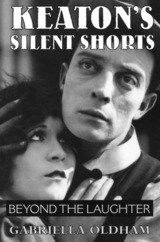 Keaton's Silent Shorts: Beyond the Laughter
Gabriella Oldham
Southern Illinois University Press, 1996 Filling a major gap in the critical canon, Keaton’s Classic Shorts: Beyond the Laughter chronicles the rapid growth in the filmmaker’s understanding of what makes both comedy and film successful. Keaton developed his major themes in these nineteen silent short films shot between 1920 and 1923, creating his persona “Buster” with his trademark stone face. These short films clearly indicate Keaton’s love of the camera and his concern for composition, symmetry, and images that delight the eye and startle the mind. Oldham reconstructs each of these rarely seen films to enable the reader to “watch” Keaton’s performance, devoting a separate chapter to each. She analyzes each film’s strengths, weaknesses, and prevalent themes and threads. She also enables readers to plumb the depths of what seems to be surface comedy through philosophical, biographical, historical, and critical commentary, thus linking the shorts together into a cohesive study of Buster Keaton’s growth through his three-year independent venture as a filmmaker. Beyond the laughter and beyond the great stone face, Oldham presents a treasure of cinema comedy and a unique philosophy of life as captured by a great filmmaker.
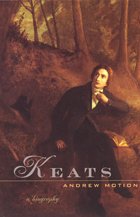 Keats
Andrew Motion
University of Chicago Press, 1999 Andrew Motion's dramatic narration of Keats's life is the first in a generation to take a fresh look at this great English Romantic poet. Unlike previous biographers, Motion pays close attention to the social and political worlds Keats inhabited. Making incisive use of the poet's inimitable letters, Motion presents a masterful account.
"Motion has given us a new Keats, one who is skinned alive, a genius who wrote in a single month all the poems we cherish, a victim who was tormented by the best doctors of the age. . . . This portrait, stripped of its layers of varnish and restored to glowing colours, should last us for another generation."—Edmund White, The Observer Review
"Keats's letters fairly leap off the page. . . . [Motion] listens for the 'freely associating inquiry and incomparable verve and dash,' the 'headlong charge,' of Keats's jazzlike improvisations, which give us, like no other writing in English, the actual rush of a man thinking, a mind hurtling forward unpredictably and sweeping us along."—Morris Dickstein, New York Times Book Review
"Scrupulous and eloquent."—Gregory Feeley, Philadelphia Inquirer
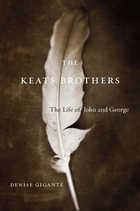 The Keats Brothers: The Life of John and George
Denise Gigante
Harvard University Press, 2013 John and George Keats—Man of Genius and Man of Power, to use John’s words—embodied sibling forms of the phenomenon we call Romanticism. George’s 1818 move to the western frontier of the United States, an imaginative leap across four thousand miles onto the tabula rasa of the American dream, created in John an abysm of alienation and loneliness that would inspire the poet’s most plangent and sublime poetry. Denise Gigante’s account of this emigration places John’s life and work in a transatlantic context that has eluded his previous biographers, while revealing the emotional turmoil at the heart of some of the most lasting verse in English.
In most accounts of John’s life, George plays a small role. He is often depicted as a scoundrel who left his brother destitute and dying to pursue his own fortune in America. But as Gigante shows, George ventured into a land of prairie fires, flat-bottomed riverboats, wildcats, and bears in part to save his brothers, John and Tom, from financial ruin. There was a vital bond between the brothers, evident in John’s letters to his brother and sister-in-law, Georgina, in Louisville, Kentucky, which run to thousands of words and detail his thoughts about the nature of poetry, the human condition, and the soul. Gigante demonstrates that John’s 1819 Odes and Hyperion fragments emerged from his profound grief following George’s departure and Tom’s death—and that we owe these great works of English Romanticism in part to the deep, lasting fraternal friendship that Gigante reveals in these pages.
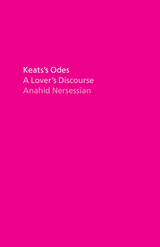 Keats's Odes: A Lover's Discourse
Anahid Nersessian
University of Chicago Press, 2020 “When I say this book is a love story, I mean it is about things that cannot be gotten over—like this world, and some of the people in it.”
In 1819, the poet John Keats wrote six poems that would become known as the Great Odes. Some of them—“Ode to a Nightingale,” “To Autumn”—are among the most celebrated poems in the English language. Anahid Nersessian here collects and elucidates each of the odes and offers a meditative, personal essay in response to each, revealing why these poems still have so much to say to us, especially in a time of ongoing political crisis. Her Keats is an unflinching antagonist of modern life—of capitalism, of the British Empire, of the destruction of the planet—as well as a passionate idealist for whom every poem is a love poem.
The book emerges from Nersessian’s lifelong attachment to Keats’s poetry; but more, it “is a love story: between me and Keats, and not just Keats.” Drawing on experiences from her own life, Nersessian celebrates Keats even as she grieves him and counts her own losses—and Nersessian, like Keats, has a passionate awareness of the reality of human suffering, but also a willingness to explore the possibility that the world, at least, could still be saved. Intimate and speculative, this brilliant mix of the poetic and the personal will find its home among the numerous fans of Keats’s enduring work.
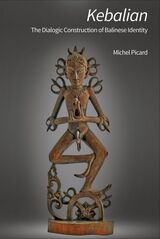 Kebalian: The Dialogic Construction of Balinese Identity
Michel Picard
National University of Singapore Press, 2024 An investigation into the complex forces that shape Balinese identity.
Over the past one hundred years, the Balinese have been challenged by colonial occupation, political turbulence, and, most recently, tourism. In response, they have come to rely on the idea of “Kebalian,” or Balinese-ness. Kebalian is likened to a tree whose roots are religion (agama), the trunk is tradition (adat), and the fruits, Balinese culture (budaya). To understand how this sense of Balinese-ness came to be, Michel Picard examines the dialogues that the Balinese have engaged in both among themselves and with outsiders by conducting over a hundred interviews with Balinese opinion leaders, officials, and religious reformers. A key throughline in the construction of Kebalian is what Picard identifies as a twofold process of “religionization” and “Hinduization.” This process began with the first years of the incorporation of Bali into the Dutch East Indies and became more urgent with Indonesia’s independence. Kebalian today encompasses the tension between those Balinese eager to defend their customary ritual practices and advocates of Hinduism who deny that such local traditions qualify as agama. Kebalian presents a fascinating picture of religious change, identities in motion, and culture. Scholars of religion, cultural change, and Southeast Asian area studies will find this to be a fascinating and important book.
 Kebara Cave, Mt. Carmel, Israel
Ofer Bar-Yosef
Harvard University Press, 2007 The Levantine corridor sits at the continental crossroads of Africa and Eurasia, making it a focal point for scientific inquiry into the emergence of modern humans and their relations with Neanderthals. The recent excavations at Kebara Cave in Israel, undertaken by an international, interdisciplinary team of researchers, has provided data crucial for understanding the cognitive and behavioral differences between archaic and modern humans.
In this first of two volumes, the authors discuss site formation processes, subsistence strategies, land-use patterns, and intrasite organization. Hearths and faunal remains reveal a dynamic and changing settlement system during the late Mousterian period, when Kebara Cave served as a major encampment. The research at Kebara Cave allows archaeologists to document the variability observed in settlement, subsistence, and technological strategies of the Late Middle and early Upper Paleolithic periods in the Levant.
 Kebara Cave, Mt. Carmel, Israel
Liliane Meignen
Harvard University Press, 2007 The remains from Skhul, Qafzeh, Amud, and Kebara caves in Israel provide evidence for the possible contemporaneity and eventual replacement of several distinct hominin populations over time: early Archaic-Modern humans by Neanderthals, and Neanderthals by Modern humans. Kebara Cave, which dates to 65,000 to 48,000 years ago, is well known for its Neanderthal remains and marvelously preserved archaeological record. Dense concentrations of fireplaces and ash lenses and rich assemblages of stone tools, animal bones, and charred plant remains testify to repeated and intensive use of the cave by late Middle Paleolithic foragers.
This second and final volume of the Kebara Cave site report presents findings from nine years of excavation and analysis of the archaeology, paleontology, human remains, and lithic industries from the Middle and Upper Paleolithic periods. Its full documentation of the daily activities of the cave’s Neanderthal inhabitants clearly indicates behavioral patterns generally attributed only to Modern humans. The two volumes on Kebara Cave provide a cornerstone for the story of humankind in a critical geographic region: the continental crossroads between Africa and Eurasia in the Levant.
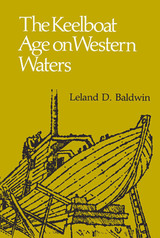 The Keelboat Age on Western Waters
Leland D. Baldwin
University of Pittsburgh Press, 1941 This book tells the story of river boating in the West before the invention of the steamboat. In a deft combination of thorough research and interesting narrative, Baldwin recreates life on the keelboats and flatboats that plied the Ohio, Mississippi, and other rivers from revolutionary days until about 1820. No one knows who put the first keel along the bottom of one big, clumsy river craft used by the pioneers. but the change made the boats far easier to manage, and travel in both directions became practical all the way to New Orleans.
Baldwin examines the many types of craft in use, the different methods of locomotion, and the art of navigation on uncharted rivers full of hidden obstacles. But he never loses sight of the picturesque aspects of his subject, especially the boatmen themselves-a tribe of rugged and fearless men whose colorful lives are described in great detail.
The Keelboat Age is a segment cut from the history of the frontier, showing the overwhelming importance of river transportation in the development of the West. The rivers were great arteries, carrying a restless people into a new land. The keelboatman and his craft did much to build a nation.
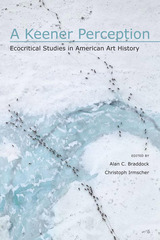 A Keener Perception: Ecocritical Studies in American Art History
Edited by Alan C. Braddock and Christoph Irmsher
University of Alabama Press, 2009 A landmark collection of essays on the intersections of visual art, cultural studies, and environmental history in America.
Issues of ecology--both as they appear in the works of nature writers and in the works of literary writers for whom place and the land are central issues--have long been of interest to literary critics, and have given rise over the last two decades to the now firmly established field of ecocriticism. The essays in this volume, written by art historians and literary critics, seek to bring the study of American art into the expanding discourse of ecocriticism.
A Keener Perception offers a series of case studies on topics ranging from John White's watercolors of the Carolina landscape executed during Sir Walter Raleigh's 1585 Roanoke expedition to photographs by environmental activist Eliot Porter. Rather than merely resurrect past instances of ecologically attuned art, this volume features essays that resituate many canonical figures, such as Thomas Eakins, Aaron Douglas, and Thomas Cole, in an ecocritical light by which they have yet to be viewed. Studying such artists and artworks through an ecocritical lens not only provides a better understanding of these works and the American landscape, but also brings a new interpretive paradigm to the field of art history--a field that many of these critics believe would do well to embrace environmental concerns as a vital area of research.
In highlighting the work of scholars who bring ecological agendas to their study of American art, as well as providing models for literary scholars who might like to better incorporate the visual arts into their own scholarship and teaching, A Keener Perception is truly a landmark collection--timely, consequential, and controversial.
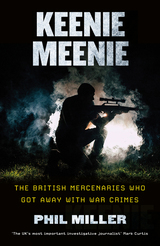 Keenie Meenie: The British Mercenaries Who Got Away with War Crimes
Phil Miller
Pluto Press, 2020 Keenie Meenie Services - the most powerful mercenary company you've never heard of - was involved in war crimes around the world from Sri Lanka to Nicaragua for which its shadowy directors have never been held accountable.
Like its mysterious name, Keenie Meenie Services escaped definition and to this day has evaded sanctions. Now explosive new evidence - only recently declassified - exposes the extent of these war crimes, and the British government's tacit support for the company's operations. Including testimonies from SAS veterans, spy chiefs and diplomats, we hear from key figures battle-hardened by the Troubles in Northern Ireland and the Iranian Embassy siege. Investigative journalist Phil Miller asks, who were these mercenaries: heroes, terrorists, freedom fighters or war criminals?
This book presents the first ever comprehensive case against Keenie Meenie Services, providing long overdue evidence on the crimes of the people who make a killing from killing.
The Keep
Emily Wilson
University of Iowa Press, 2001 The poems in The Keep are influenced by art, by paintings, by “thinking about abstraction and figuration and the space between, beauty apprehended and lost, the divine apprehended and lost.” Emily Wilson's poems are also saturated with nature; from “the great oaks emptying, russet, gusseted” to “the caribou mov[ing] through us beyond numerous,” each image connects the natural world of tides and marshes and forests to the human world of documentation and preservation. The image of the keep as a place of safety and as a kind of prison also informs this very strong collection.
KEEP BOOKS Digital Editions Beginning First Set 1: Easy Stories for Early Readers
Andrea McCarrier
Keep Books, 2019 This set of four books offers engaging, easy to read stories in this set reinforce good health and nutrition for young children.
Stories include: Treats for Barney, Fingers, Fork, or Spoon?, Just One Bite, & Sundaes for Breakfast.
Age Level: 5-6
Grade Level: Beginning First
Reading level: C-D/4-7
KEEP BOOKS digital editions include text features and design elements that give beginning readers what they need to start reading on their own with high interest titles that they can easily manage.
KEEP BOOKS Digital Editions Beginning First Set 2: Easy Stories for Early Readers
Mary Fried
Keep Books, 2019 This set of four books offers engaging, easy to read stories in this set reinforce good health and nutrition for young children.
Stories include: The Farmer’s Market, Our Garden, The Running Girl, & Please and Thank You.
Age Level: 5-6
Grade Level: Beginning First
Reading level: D-E/6-8
KEEP BOOKS digital editions include text features and design elements that give beginning readers what they need to start reading on their own with high interest titles that they can easily manage.
KEEP BOOKS Digital Editions Beginning First Set 3: Easy Stories for Early Readers
Gay Su Pinnell
Keep Books, 2019 This set of four books offers easy reading to enjoy and practice at home.
Stories include: Gingerbread Girl, Making a Peanut Butter and Jelly Sandwich, Keeping Warm, & Let’s Pretend.
Age Level: 5-6
Grade Level: Beginning First
Reading level: C-D/3-5
KEEP BOOKS digital editions include text features and design elements that give beginning readers what they need to start reading on their own with high interest titles that they can easily manage.
KEEP BOOKS Digital Editions Beginning First Set 4: Easy Stories for Early Readers
Kecia Hicks
Keep Books, 2022 This set of four books offers easy reading to enjoy and practice at home.
Stories include: My Happy Heart; Just Like Me; Staying Safe; and Always Brush Your Teeth.
Age Level: 5-6
Grade Level: Beginning First
Reading level: D-E/5-8
KEEP BOOKS digital editions include text features and design elements that give beginning readers what they need to start reading on their own with high interest titles that they can easily manage.
KEEP BOOKS Digital Editions Kindergarten Science Set 1: Weather-Related Concepts
Marsha Levering
Keep Books, 2020 This set of four books offers engaging stories that combine features of early literacy learning while exploring weather-related concepts from Common Core State Standards and Next Generation Science Standards. Stories include: Spring, Summer, Fall, & Winter. Stories include: Spring, Summer, Fall, & Winter. Age Level: 5/6
Grade Level: Kindergarten
Reading level: not leveled KEEP BOOKS digital editions include text features and design elements that give beginning readers what they need to start reading on their own with high interest titles that they can easily manage.
KEEP BOOKS Digital Editions Kindergarten Science Set 2: Weather-Related Concepts
Marsha Levering
Keep Books, 2020 This set of four books offers engaging stories that combine features of early literacy learning while exploring weather-related concepts from Common Core State Standards and Next Generation Science Standards. Stories include: May, Rain, December, & Is It Hot or Cold?. Age Level: 5/6
Grade Level: Kindergarten
Reading level: not leveled KEEP BOOKS digital editions include text features and design elements that give beginning readers what they need to start reading on their own with high interest titles that they can easily manage.
KEEP BOOKS Digital Editions Late First/Beginning Second Set 1: Stories for Young Readers
Mary Fried
Keep Books, 2020 This set of four books offers lots of reading practice for children who can already read easy books.
Stories include: A New House; Scary Noises; Night Games; and Digging for Dinner.
Age Level: 7-8
Grade Level: Late First/Beginning Second
Reading level: E-G/8-12
KEEP BOOKS digital editions include text features and design elements that give beginning readers what they need to start reading on their own with high interest titles that they can easily manage.
KEEP BOOKS Digital Editions Late First/Beginning Second Set 2: Stories for Young Readers
Mary Fried
Keep Books, 2020 This set of four books offers lots of reading practice for children who can already read easy books.
Stories include: The Best Birthday Present; Be Careful!; Trapped; and Where Is Papa?
Age Level: 7-8
Grade Level: Late First/Beginning Second
Reading level: G-H/12-14
KEEP BOOKS digital editions include text features and design elements that give beginning readers what they need to start reading on their own with high interest titles that they can easily manage.
KEEP BOOKS Digital Editions pre-K/Kindergarten Set 1: Stories to Start Learning to Read
Mary Fried
Keep Books, 2018 This set of four books offers engaging stories with simple repeated language and related pictures, one or two lines of print per page, and ample space between words.
Stories include: Balloons, The Farm, Dinosaurs, & Traffic.
Age Level: 3-5
Grade Level: preK-Kindergarten
Reading level: A-B/1-2
KEEP BOOKS digital editions include text features and design elements that give beginning readers what they need to start reading on their own with high interest titles that they can easily manage.
KEEP BOOKS Digital Editions pre-K/Kindergarten Set 2: Stories to Start Learning to Read
Amanda Morley
Keep Books, 2019 This set of four books include traditional nursery rhymes and are formatted with clear text and engaging illustrations.
Stories include: Jack and Jill; Old Mother Hubbard; Humpty Dumpty; & One, Two, Buckle My Shoe.
Age Level: 3-5
Grade Level: preK-Kindergarten
Reading level: not leveled
KEEP BOOKS digital editions include text features and design elements that give beginning readers what they need to start reading on their own with high interest titles that they can easily manage.
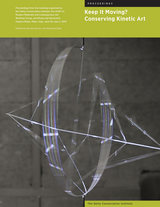 Keep It Moving?: Conserving Kinetic Art
Rachel Rivenc
J. Paul Getty Trust, The, 2018 Kinetic art not only includes movement but often depends on it to produce an intended effect and therefore fully realize its nature as art. It can take a multiplicity of forms and include a wide range of motion, from motorized and electrically driven movement to motion as the result of wind, light, or other sources of energy. Kinetic art emerged throughout the twentieth century and had its major developments in the 1950s and 1960s.
Professionals responsible for conserving contemporary art are in the midst of rethinking the concept of authenticity and solving the dichotomy often felt between original materials and functionality of the work of art. The contrast is especially acute with kinetic art when a compromise between the two often seems impossible. Also to be considered are issues of technological obsolescence and the fact that an artist’s chosen technology often carries with it strong sociological and historical information and meanings.
 The Keep: Living with the Tame and the Wild on a Mountainside Farm
Henry T. Ireys
West Virginia University Press, 2025 When a mid-life couple finds an old farm that promises refuge from hectic lives and encroaching illness, their world opens up to unexpected adventures: breeding heritage goats, hogs, and cattle; managing a half-dozen large guardian dogs; dealing with barn fires, rapacious logging, and the death of treasured animals. The farm and the surrounding forest also lead to surprising moments of beauty—from sublime sunsets and powerful connections with animals to an outpouring of help from neighbors.
Written separately by wife and husband with distinctly separate voices, the book’s essays illustrate different perspectives of life on a farm dedicated to the compassionate treatment of livestock and a deep appreciation of nature’s complexities. Priscilla embraces the intensity of loving animals; Henry explores the mysteries of living in a beautiful place. And, in telling their tales, the authors provide a glimpse into their own marriage—as complicated, improbable, and enduring as life itself. The Keep—the term for “the strongest or central tower of a castle, acting as a final refuge”—is a love letter to an unexpected place and adopted lifestyle.
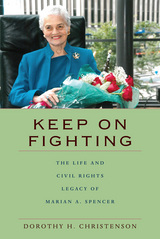 Keep On Fighting: The Life and Civil Rights Legacy of Marian A. Spencer
Dorothy H. Christenson
Ohio University Press, 2015 Marian Alexander Spencer was born in 1920 in the Ohio River town of Gallipolis, Ohio, one year after the “Red Summer” of 1919 that saw an upsurge in race riots and lynchings. Following the example of her grandfather, an ex-slave and community leader, Marian joined the NAACP at thirteen and grew up to achieve not only a number of civic leadership firsts in her adopted home city of Cincinnati, but a legacy of lasting civil rights victories. Of these, the best known is the desegregation of Cincinnati’s Coney Island amusement park. She also fought to desegregate Cincinnati schools and to stop the introduction of observers in black voting precincts in Ohio. Her campaign to raise awareness of industrial toxic-waste practices in minority neighborhoods was later adapted into national Superfund legislation. In 2012, Marian’s friend and colleague Dot Christenson sat down with her to record her memories. The resulting biography not only gives us the life story of remarkable leader but encapsulates many of the twentieth century’s greatest struggles and advances. Spencer’s story will prove inspirational and instructive to citizens and students alike.
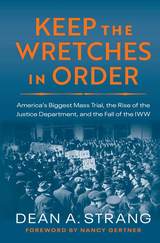 Keep the Wretches in Order: America's Biggest Mass Trial, the Rise of the Justice Department, and the Fall of the IWW
Dean A. Strang
University of Wisconsin Press, 2020 Before World War I, the government reaction to labor dissent had been local, ad hoc, and quasi-military. Sheriffs, mayors, or governors would deputize strikebreakers or call out the state militia, usually at the bidding of employers. When the United States entered the conflict in 1917, government and industry feared that strikes would endanger war production; a more coordinated, national strategy would be necessary. To prevent stoppages, the Department of Justice embarked on a sweeping new effort—replacing gunmen with lawyers. The department systematically targeted the nation’s most radical and innovative union, the Industrial Workers of the World, also known as the Wobblies, resulting in the largest mass trial in U.S. history.
In the first legal history of this federal trial, Dean Strang shows how the case laid the groundwork for a fundamentally different strategy to stifle radical threats, and had a major role in shaping the modern Justice Department. As the trial unfolded, it became an exercise of raw force, raising serious questions about its legitimacy and revealing the fragility of a criminal justice system under great external pressure.
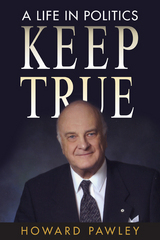 Keep True: A Life in Politics
Howard Pawley
University of Manitoba Press, 2011 Howard Pawley, former Premier of Manitoba (1981-88) led the province during one of the most turbulent periods in its history. Elected at the outset of a serious national recession, his government successfully implemented social democtatic policies that ran counter to the neo-conservative trends that dominated the period, including job creation, labour reform, and human rights legislation. But his greatest challenge was over French-language rights, an explosive two-year debate that left the province badly divided and embroiled in the complicated maneuvering between the national government and Quebec serparatists. The political and public fallout from the French-language issue echoed through Manitoba's subsequent negotiations with the federal government over a bid for a lucrative CF-18 fighter jet contract, through the implementation of the Free Trade Agreement, and again during the stormy Meech Lake Accord debates. In Keep True: A Life in Politics Pawley takes us into the inner workings of his government during this controversial period. He gives us a vivid play-by-play of the events, acknowledging what went right and what went wrong, while putting it all into a contemporary context. Along the way, he offers insight on campaign management, choosing a cabinet, appointing public servants, and leading by consensus, while describing how the principles of Canadian agrarian socialism shaped his political vision.
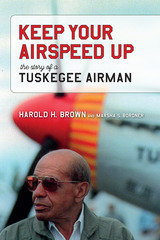 Keep Your Airspeed Up: The Story of a Tuskegee Airman
Harold H. Brown and Marsha S. Bordner
University of Alabama Press, 2017 Inspiring memoir of Colonel Harold H. Brown, one of the 930 original Tuskegee pilots, whose dramatic wartime exploits and postwar professional successes contribute to this extraordinary account.
Keep Your Airspeed Up: The Story of a Tuskegee Airman is the memoir of an African American man who, through dedication to his goals and vision, overcame the despair of racial segregation to great heights, not only as a military aviator, but also as an educator and as an American citizen.
Unlike other historical and autobiographical portrayals of Tuskegee airmen, Harold H. Brown’s memoir is told from its beginnings: not on the first day of combat, not on the first day of training, but at the very moment Brown realized he was meant to be a pilot. He revisits his childhood in Minneapolis where his fascination with planes pushed him to save up enough of his own money to take flying lessons. Brown also details his first trip to the South, where he was met with a level of segregation he had never before experienced and had never imagined possible.
During the 1930s and 1940s, longstanding policies of racial discrimination were called into question as it became clear that America would likely be drawn into World War II. The military reluctantly allowed for the development of a flight-training program for a limited number of African Americans on a segregated base in Tuskegee, Alabama. The Tuskegee Airmen, as well as other African Americans in the armed forces, had the unique experience of fighting two wars at once: one against Hitler’s fascist regime overseas and one against racial segregation at home.
Colonel Brown fought as a combat pilot with the 332nd Fighter Group during World War II, and was captured and imprisoned in Stalag VII A in Moosburg, Germany, where he was liberated by General George S. Patton on April 29, 1945. Upon returning home, Brown noted with acute disappointment that race relations in the United States hadn’t changed. It wasn’t until 1948 that the military desegregated, which many scholars argue would not have been possible without the exemplary performance of the Tuskegee Airmen.
Keeper
Kasey Jueds
University of Pittsburgh Press, 2013 The poems in Keeper explore, and long for, intimacy: with nature, with others, with the unknown. They delve into purely dark spaces (the insides of birdhouses and mailboxes, caves of prehistoric paintings) and in-between places, searching out, as Paul Eluard put it, the other world inside this one, pointing to the pervasive sensuality that connects all beings, and to the fact that essential goodness and sorrow often walk hand in hand.
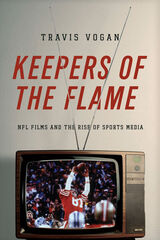 Keepers of the Flame: NFL Films and the Rise of Sports Media
Travis Vogan
University of Illinois Press, 2014 NFL Films changed the way Americans view football. Keepers of the Flame: NFL Films and the Rise of Sports Media traces the subsidiary's development from a small independent film production company to the marketing machine that Sports Illustrated named "perhaps the most effective propaganda organ in the history of corporate America."
Drawing on research at the NFL Films Archive and the Pro Football Hall of Fame and interviews with media pioneer Steve Sabol and others, Travis Vogan shows how NFL Films has constructed a consistent, romanticized, and remarkably visible mythology for the National Football League. The company packages football as a visceral and dramatic sequence of violent, beautiful, graceful, and heroic gridiron battles. Historically proven formulas for presentation--such as the dramatic voiceovers once provided by John Facenda's baritone, the soaring scores of Sam Spence's rousing background music, and the epic poetry found in Steve Sabol's scripts--are still used today.
From the Vincent Price-narrated Strange but True Football Stories to the currently running series Hard Knocks, NFL Films distinguishes the NFL from other sports organizations and from other media and entertainment. Vogan tells the larger story of the company's relationship with and vast influence on our culture's representations of sport, the expansion of sports television beyond live game broadcasts, and the emergence of cable television and Internet sports media.
Keepers of the Flame: NFL Films and the Rise of Sports Media presents sports media as an integral facet of American popular culture and NFL Films as key to the transformation of professional football into the national obsession commonly known as America's Game.
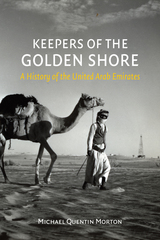 Keepers of the Golden Shore: A History of the United Arab Emirates
Michael Quentin Morton
Reaktion Books, 2016 For those who visit the United Arab Emirates (UAE), staying in its the lavish hotels and browsing in the ultra-modern shopping malls of Abu Dhabi or Dubai, the country can be a mystery, a glass and concrete creation that seems to have sprung from the desert overnight. Keepers of the Golden Shore looks behind this glossy façade, illuminating the region’s history, which stretches from the ancient Arabian tribes who controlled a desolate but economically important shoreline to the ostentatious architectural wonders—bankrolled by a massive wealth of oil—that characterize it today.
As Michael Quentin Morton recounts, the region now known as the UAE likely began as a trading post between Mesopotamia and Oman, and since that time has been the stage of important economic and cultural exchanges. It has seen the rise and fall of a thriving pearl industry, piracy, invasions and wars, and the arrival of the oil age that would make it one of the richest countries on earth. Since the early 1970s, when seven sheikhs agreed to enter into a union, it has been a sovereign nation, carrying on the resourceful spirit—with resplendent fervor—that the brutally inhospitable landscape has long demanded of the people. Ultimately, Morton shows that the country is not only rich in oil and money but in an extraordinarily deep history and culture.
Keepers of the Sacred Chants: The Poetics of Ritual Power in an Amazonian Society
Jonathan D. Hill
University of Arizona Press, 1993 The Wakuenai of the upper Rio Negro region in southern Venezuela employ a form of singing called malikai for ceremonies of childbirth, initiation, and healing. This ritual chanting is a rich amalgam of myth and music, and serves as a means of integrating individuals into a vertical hierarchy of power relations between mythic ancestors and human descendants. Jonathan Hill here shows how the musical and semantic transformations of everyday discourse in malikai integrate the everyday world into a poetic process of empowerment.
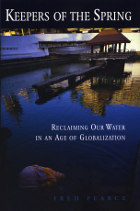 Keepers of the Spring: Reclaiming Our Water In An Age Of Globalization
Fred Pearce
Island Press, 2004 Water has long been the object of political ambition and conflict. Recent history is full of leaders who tried to harness water to realize national dreams. Yet the people who most need water-farmers, rural villages, impoverished communities-are too often left, paradoxically, with desiccated fields, unfulfilled promises, and refugee status. It doesn't have to be this way, according to Fred Pearce. A veteran science news correspondent, Pearce has for over fifteen years chronicled the development of large-scale water projects like China's vast Three Gorges dam and India's Sardar Sarovar. But, as he and numerous other authors have pointed out, far from solving our water problems, these industrial scale projects, and others now in the planning, are bringing us to the brink of a global water crisis. Pearce decided there had to be a better way. To find it, he traveled the globe in search of alternatives to mega-engineering projects. In Keepers of the Spring, he brings back intriguing stories from people like Yannis Mitsis, an ethnic Greek Cypriot, who is the last in his line to know the ways and whereabouts of a network of underground tunnels that have for centuries delivered to farming communities the water they need to survive on an arid landscape. He recounts the inspiring experiences of small-scale water stewards like Kenyan Jane Ngei, who reclaimed for her people a land abandoned by her government as a wasteland. And he tells of many others who are developing new techniques and rediscovering ancient ones to capture water for themselves. In so doing, Pearce documents that these "keepers" are not merely isolated examples, but collectively constitute an entire alternative tradition of working with natural flows rather than trying to reengineer nature to provide water for human needs. The solution to our water problems, he finds, may not lie in new technologies-though they will play a role-but in recovering ancient traditions, using water more efficiently, and better understanding local hydrology. Are these approaches adequate to serve the world's growing populations? The answer remains unclear. But we ignore them at our own peril.
Keepers of the Wolves
Richard P. Thiel
University of Wisconsin Press, 2018 It was 1978, and gray wolves had been extinct in Wisconsin for twenty years. Still, there were rumors from the state's northwestern counties that they had returned. Dick Thiel, then a college student with a passion for wolves, was determined to find out. Keepers of the Wolves is his engrossing account of tracking and protecting the recovery of wolves in Wisconsin. Thiel conveys the wonder, frustrations, humor, and everyday hard work of field biologists, including the political and public relations pitfalls they regularly face.
This new edition brings Thiel's story into the twenty-first century, recounting his work monitoring wolves as they spread to central Wisconsin, conflicts of wolves with landowners and recreationalists, changes in state and federal policies, the establishment of a state wolf-hunting season in 2012, and Thiel's forecast for the future of wolves in Wisconsin.
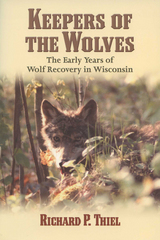 Keepers of the Wolves: The Early Years of Wolf Recovery in Wisconsin
Richard P. Thiel
University of Wisconsin Press, 2001 It was 1978, and there had been no resident timber wolves in Wisconsin for twenty years. Still, packs were active in neighboring Minnesota, and there was the occasional rumor from Wisconsin’s northwestern counties of wolf sign or sightings. Had wolves returned on their own to Wisconsin? Richard Thiel, then a college student with a passion for wolves, was determined to find out.
Thus begins Keepers of the Wolves, Thiel’s tale of his ten years at the center of efforts to track and protect the recovery of wolves in Northern Wisconsin. From his early efforts as a student enthusiast to his departure in 1989 from the post of wolf biologist for the Department of Natural Resources, Thiel conveys the wonder, frustrations, humor, and everyday hard work of field biologists, as well as the politics and public relations pitfalls that so often accompany their profession.
We share in the excitement as Thiel and his colleagues find wolf tracks in the snow, howl in the forest night and are answered back, learn to safely trap wolves to attach radio collars, and track the packs’ ranges by air from a cramped Piper Cub. We follow the stories of individual wolves and their packs as pups are born and die, wolves are shot by accident and by intent, ravages of canine parvovirus and hard winters take their toll, and young adults move on to new ranges. Believing he had left his beloved wolves behind, Thiel takes a new job as an environmental educator in central Wisconsin, but soon wolves follow. By 1999, there were an estimated 200 timber wolves in 54 packs in Wisconsin.
This is a sequel to Dick Thiel's 1994 book, The Timber Wolf in Wisconsin: The Death and Life of a Majestic Predator. That book traced the wolf's history in Wisconsin, its near extinction, and the initial efforts to reestablish it in our state. Thiel's new book looks at how successful that program has been.
The Keepers of Truth
Michael Collins
University of Iowa Press, 2021 The last of a manufacturing dynasty in a dying industrial town, Bill lives alone in the family mansion and works for the Truth, the moribund local paper. He yearns to write long philosophical pieces about the American dream gone sour, not the flaccid write-ups of bake-off contests demanded by the Truth. Then, old man Lawton goes missing, and suspicion fixes on his son, Ronny. Paradoxically, the specter of violent death breathes new life into the town. For Bill, a deeper and more disturbing involvement with the Lawtons ensues. The Lawton murder and the obsessions it awakes in the town come to symbolize the mood of a nation on the edge. Compulsively readable, The Keepers of Truth startles both with its insights and with Collins's powerful, incisive writing.
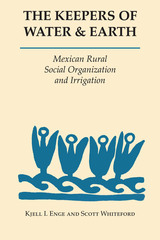 The Keepers of Water and Earth: Mexican Rural Social Organization and Irrigation
By Kjell I. Enge and Scott Whiteford
University of Texas Press, 1989 Agrarian reforms transformed the Mexican countryside in the late twentieth century but without, in many cases, altering fundamental power relationships. This study of the Tehuacán Valley in the state of Puebla highlights different strategies to manipulate the local implementation of federal government programs. With their very differing successes in the struggle to regain and maintain control of land and water rights, these strategies raise important questions about the meaning of the phrase "locally controlled development." Because Mexico is dependent on irrigation for 45 percent of its cash crop production, national policy has focused on developing vast government controlled and financed irrigation systems. In the Tehuacán Valley, however, the inhabitants have developed a complex irrigation system without government aid or supervision. Yet, in contrast to most parts of Mexico, water rights can be bought and sold as a commodity, leading to accumulation, stratification, and emergence of a regional elite whose power is based on ownership of land and water. The analysis provides an important contribution to the understanding of local control. The findings of this study will be important to a wide audience involved in the study of irrigation, local agricultural systems, and the interplay between local power structures and the national government in developing countries. The book also presents unique material on gravity-fed, horizontal wells, known as qanat in the Middle East, which had been unknown in the literature on Latin America before this book.
Keepin' It Real: Essays on Race in Contemporary America
Elwood David Watson
Intellect Books, 2019 The past decade has been one of the most racially turbulent periods in the modern era, as the complicated breakthrough of the Obama presidency gave way to the racially charged campaigning and eventual governing of Donald Trump. Keepin’ It Real presents a wide-ranging group of essays that take on key aspects of the current landscape surrounding racial issues in America, including the place of the Obamas, the rise of the alt-right and White nationalism, Donald Trump, Colin Kaepernick and the backlash against his protests, Black Lives Matter, sexual politics in the black community, and much more.
America’s racial problems aren’t going away any time soon. Keepin’ It Real will serve as a marker of the arguments we’re having right now, and an argument for the changes we need to make to become the better nation we’ve long imagined ourselves to be.
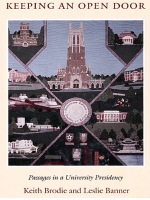 Keeping An Open Door: Passages in a University Presidency
Keith Brodie and Leslie Banner
Duke University Press, 1996 During the 1980s, many of America’s most respected colleges and universities suffered financial crises, athletic scandals, a troubling upsurge of racial conflict, and the divisiveness of political correctness “wars.” Yet Duke University not only avoided these dangers but changed dramatically from a very good regional university to one of the nation’s top research institutions. Its undergraduate campus was hailed as a “hot college”; its Blue Devils basketball team was pronounced a model for student athletes; its graduate and professional schools gained new national prominence; and its scholars were quoted frequently in the popular press on both sides of the political correctness debates.
In Keeping an Open Door, Duke chancellor (1982-1985) and president (1985-1993) Keith Brodie and coauthor Leslie Banner recount what it was like to lead Duke during an era of change for research universities across the country: how Brodie reached some of his most controversial decisions, including the “Black Faculty Initiative”; his strategy for precluding abuse in Division I athletics at Duke; how his training as a psychiatrist shaped his leadership style and influenced how he dealt with trustees, deans, faculty, and students; and the avenues of power still open to today’s university presidents. The history and feeling of life on the Duke campus during the Brodie era are vividly evoked in photographs and key speeches introduced by the former president’s personal recollections.
Keeping an Open Door provides an insider’s view of issues critical to modern research universities and will interest anyone concerned with the history and future of higher education.
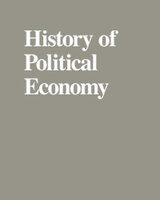 Keeping Faith, Losing Faith: Religious Belief and Political Economy, Volume 40
Bradley W. Bateman and H. Spencer Banzhaf, eds.
Duke University Press “Keeping Faith, Losing Faith: Religious Belief and Political Economy” considers the historical and current relationship between religious and economic schools of thought. The volume explores the integration of theology and economics that was prevalent before the twentieth century, the rise of secular neoclassical economic models in the middle of that century, and the recent trend toward examining economic behavior through the prism of religious belief. Two of the essays examine the antagonism between Christianity and utilitarianism in postrevolutionary French economics and the rising influence of the materialism of the market vis-à-vis the declining authority of the Roman Catholic Church in eighteenth-century Europe. Other topics explored include the work of the great American neoclassicist Frank Knight, the combination of utility analysis and Christian principles among the “clerical economists” in America, and the effect of a crisis of personal faith on the theories of the English philosopher and economist Henry Sidgwick.
Keeping Faith: Memoirs of a President
Jimmy Carter
University of Arkansas Press, 1995 In Keeping Faith, originally published in 1982, President Carter provides a candid account of his time in the Oval Office, detailing the hostage crisis in Iran, his triumph at the Camp David Middle East peace summit, his relationships with world leaders, and even glimpses into his private world. “Responsible, truthful, intelligent, earnest, rational, purposeful. Thus the man: thus the book” (The Washington Post).
 Keeping Faith with Human Rights
Linda Hogan
Georgetown University Press, 2015 The human rights regime is one of modernity's great civilizing triumphs. From the formal promulgation of the Universal Declaration of Human Rights in 1948 to the subsequent embrace of this declaration by the newly independent states of Africa, human rights have emerged as the primary discourse of global politics and as an increasingly prominent category in the international and domestic legal system. But throughout their history, human rights have endured sustained attempts at disenfranchisement. In this provocative study, Linda Hogan defends human rights language while simultaneously reenvisioning its future. Avoiding problematic claims about shared universal values, Hogan draws on the constructivist strand of political philosophy to argue for a three-pronged conception of human rights: as requirements for human flourishing, as necessary standards of human community, and as the basis for emancipatory politics. In the process, she shows that it is theoretically possible and politically necessary for theologians to keep faith with human rights. Indeed, the Christian tradition—the wellspring of many of the ethical commitments considered central to human rights—must embrace its vital role in the project.
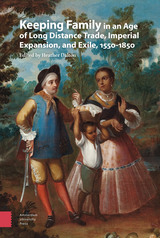 Keeping Family in an Age of Long Distance Trade, Imperial Expansion, and Exile, 1550-1850
Heather Dalton
Amsterdam University Press, 2020 Keeping Family in an Age of Long Distance Trade, Imperial Expansion, and Exile, 1550--1850 brings together eleven original essays by an international group of scholars, each investigating how family, or the idea of family, was maintained or reinvented when husbands, wives, children, apprentices, servants or slaves separated, or faced separation, from their household. The result is a fresh and geographically wide-ranging discussion about the nature of family and its intersection with travel over three hundred years -- a period during which roles and relationships, within and between households, were increasingly affected by trade, settlement, and empire building. The imperial project may have influenced different regions in different ways at different times yet, as this collection reveals, families, especially those transcending national ties and traditional boundaries, were central to its progress. Together, these essays bring new understandings of the foundations of our interconnected world and of the people who contributed to it.
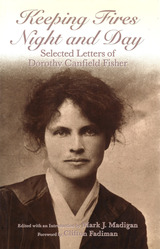 Keeping Fires Night and Day: Selected Letters of Dorothy Canfield Fisher
Edited & Intro by Mark J. Madigan & Foreword by Clifton Fadiman
University of Missouri Press, 1993
Eleanor Roosevelt called her one of the most influential women in America. Among the earliest and most assertive members of the Book-of-the-Month Club selection committee, Dorothy Canfield Fisher helped define literary taste in America for more than three decades. She helped shape the careers of such great writers as Pearl Buck, Isak Dinesen, and Richard Wright. A best-selling author herself, Fisher was also a deeply committed social activist. In Keeping Fires Night and Day, Mark J. Madigan collects much of Fisher's copious correspondence. With letters to Willa Cather, W.E.B. Du Bois, Albert Einstein, Robert Frost, Margaret Mead, James Thurber, and E.B. White, he documents Fisher's personal and professional life and career in a way that no biography could. Set against the American historical and cultural landscape from 1900 to 1958, these letters offer a firsthand account of one of the twentieth century's most remarkable women.
While Fisher's novels treated such conventional subjects as marriage and domestic life, her own life was anything but conventional. When her best-selling novels made her the chief breadwinner in her marriage, her husband, John Fisher, quietly assumed the role of secretary and editor of her work. Fluent in five languages, Dorothy Canfield Fisher founded a Braille press in France and introduced the educational methods of Dr. Maria Montessori to the United States. She became a pioneering advocate of adult education and served as the first woman on the Vermont Board of Education.
In letters to friends, fans, and colleagues, Fisher discussed her homelife, her work, and the world around her. Her passions and concerns-revealed in her correspondence with wit and poignancy-include the "New Woman' and the suffrage movement, racial discrimination and the emergence of the NAACP, the development of the national education system, two world wars, the depression, and the influence of book clubs in the literary market-place.
Dorothy Canfield Fisher "helped twentieth-century American literature to come of age," writes Clifton Fadimon in his Foreward. Yet lasting recognition has eluded her. In Keeping Fires Night and Day the distinctive voice of this gifted, intelligent and spirited woman is heard once again.
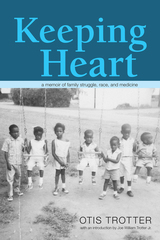 Keeping Heart: A Memoir of Family Struggle, Race, and Medicine
Otis Trotter
Ohio University Press, 2015 “After saying our good-byes to friends and neighbors, we all got in the cars and headed up the hill and down the road toward a future in Ohio that we hoped would be brighter,” Otis Trotter writes in his affecting memoir, Keeping Heart: A Memoir of Family Struggle, Race, and Medicine. Organized around the life histories, medical struggles, and recollections of Trotter and his thirteen siblings, the story begins in 1914 with his parents, Joe William Trotter Sr. and Thelma Odell Foster Trotter, in rural Alabama. By telling his story alongside the experiences of his parents as well as his siblings, Otis reveals cohesion and tensions in twentieth-century African American family and community life in Alabama, West Virginia, and Ohio. This engaging chronicle illuminates the journeys not only of a black man born with heart disease in the southern Appalachian coalfields, but of his family and community. It fills an important gap in the literature on an underexamined aspect of American experience: the lives of blacks in rural Appalachia and in the nonurban endpoints of the Great Migration. Its emotional power is a testament to the importance of ordinary lives.
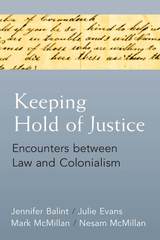 Keeping Hold of Justice: Encounters between Law and Colonialism
Jennifer Balint, Julie Evans, Mark McMillan, and Nesam McMillan
University of Michigan Press, 2020 Keeping Hold of Justice focuses on a select range of encounters between law and colonialism from the early nineteenth century to the present. It emphasizes the nature of colonialism as a distinctively structural injustice, one which becomes entrenched in the social, political, legal, and discursive structures of societies and thereby continues to affect people’s lives in the present. It charts, in particular, the role of law in both enabling and sustaining colonial injustice and in recognizing and redressing it. In so doing, the book seeks to demonstrate the possibilities for structural justice that still exist despite the enduring legacies and harms of colonialism. It puts forward that these possibilities can be found through collaborative methodologies and practices, such as those informing this book, that actively bring together different disciplines, peoples, temporalities, laws and ways of knowing. They reveal law not only as a source of colonial harm but also as a potential means of keeping hold of justice.
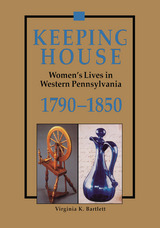 Keeping House: Women’s Lives in Western Pennsylvania, 1790–1850
Virginia Bartlett
University of Pittsburgh Press, 1994
This book is a fascinating re-creation of the lives of women in the time of great social change that followed the end of the French and Indian War in western Pennsylvania. Many decades passed before a desolate and violent frontier was transformed into a stable region of farms and towns. Keeping House: Women’s Lives in Western Pennsylvania, 1790-1850 tells how the daughters, wives, and mothers who crossed the Allegheny Mountains responded and adapted to unaccustomed physical and psychological hardships as they established lives for themselves and their families in their new homes.
Intrigued by late eighteenth and early nineteenth-century manuscript cookbooks in the collection of the Historical Society of Western Pennsylvania, Virginia Bartlett wanted to find out more about women living in the region during that period. Quoting from journals, letters, cookbooks, travelers’ accounts - approving and critical - memoirs, documents, and newspapers, she offers us voices of women and men commenting seriously and humorously on what was going on around them.
The text is well-illustrated with contemporaneous art-- engravings, apaintings, drawings, and cartoons. Of special interest are color and black-and-white photographs of furnishings, housewares, clothing, and portraits from the collections of the Historical Society of Western Pennsylvania.
This is not a sentimental account. Bartlett makes clear how little say women had about their lives and how little protection they could expect from the law, especially on matters relating to property. Their world was one of marked contrasts: life in a log cabin with bare necessities and elegant dinners in the homes of Pittsburgh’s military and entrepreneurial elite; rural women in homespun and affluent Pittsburgh ladies in imported fashions. When the book begins, families are living in fear of Indian attacks; as it ends, the word “shawling” has come into use as the polite term for pregnancy, referring to women’s attempt to hide their condition with cleverly draped shawls. The menacing frontier has given way to American-style gentility.
An introduction by Jack D. Warren, University of Virginia, sets the scene with a discussion of the early peopling of the region and places the book within the context of women’s studies.
|
|
